Catalyst for success
Henrik Rasmussen, MD, The Americas at Topsoe, explains the role the company is playing in the transition from grey to blue to green fuels


Interview
Why digital technologies are essential to decarbonizing key industries
Supply chain
Scope 3 emissions and charting a course to net-zero
Wind energy
Decreasing LCOE and supporting the transition to wind power
Issue 210 - 2022
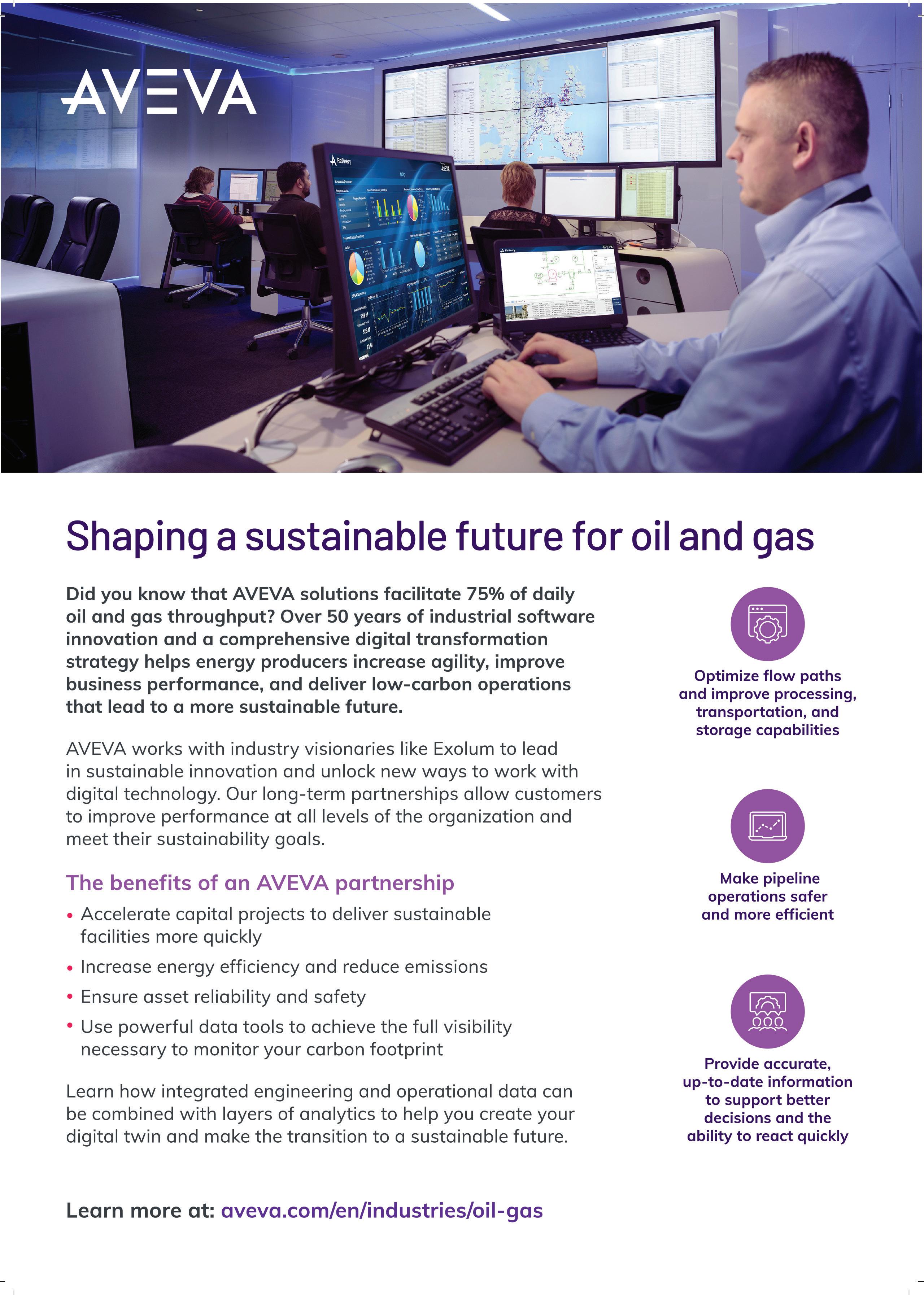
CEO Andrew Schofield
Group COO Joe Woolsgrove
Creative Director Tom Vince
Data & Insights Director Jaione Soga
Editor Libbie Hammond
Assistant Editor Mary Floate
Content Editors Daniel Baksi, Alex Caesari, Danielle Champ
Editorial Administrator Amy Gilks

Managing Art Editor Fleur Daniels
Art Editors Paul Gillings, David Howard, Charlie Protheroe, Lee Protheroe
Artwork Administrator
Rochelle Broderick-White
Sales Director Alasdair Gamble


Project Directors
Philip Monument, Joy Francesconi
Head of Content Management
Adam Blanch
Head of Global Media Programs
Mark Cawston
Project Managers Lewis Bush, Natalie Griffiths, Jo-Ann Jeffery, Ben Richell
Content Managers Johanna Bailey, Mark Cowles, Jeff Goldenberg, Wendy Russell, Richard Saunders, Kieran Shukri
Media Sales Executives Mike Berger, Jessica Eglington, Will Gwyther, Reid Lingle, Sam Surrell
General Manager Florida Division
Ryan Finn
Social Media Co-ordinator Rosie Clegg
IT Support Iain Kidd
Administration Natalie Fletcher, Rory Gallacher, Ibby Mundhir
Hello and welcome to the November issue of Energy, Oil & Gas. Among our feature selection this month is an interview with Ron Beck from AspenTech. He shared some insights with Dan Baksi from the EOG team, around the challenges facing the energy sector, and the pivotal role that digital technologies are playing and will continue to play in the energy transition. Ron says that more advanced companies are ‘pioneering the integration of digital twins, dynamic optimization, and utility optimization’ and he also notes that artificial intelligence is expected to further accelerate the pace of change. For the full story, visit page 6.
lh@finelightmediagroup.com
Our cover story this issue features an interview with Henrik Rasmussen, Managing Director, The Americas at Topsoe. Turn to page 66 to find out why he describes the business’ trajectory as ‘riding the wave of decarbonization’.

© 2022 Finelight Media Group
Corporate Head Office
Cringleford Business Centre, 10 Intwood Road. Cringleford, Norwich NR4 6AU U.K.
T: (312) 854-0123 T: +44 (0) 1603 274130
US Office
2240 West Woolbright Road, Suite 402 Boynton Beach. FI 33426
T: (561) 778-2396
Supply chain Scope 3 emissions and charting a Why digital technologies are essential to decarbonizing key industries Wind energy Decreasing LCOE and supporting the transition to wind power Henrik Rasmussen, MD, The Americas at Topsoe, explains the role the company is playing in the transition from grey to blue to green fuels Catalyst for success Please note: The opinions expressed by contributors and advertisers within this publication do not necessarily coincide with those of the editor and publisher. Every reasonable effort is made to ensure that the information published is accurate, and correct at time of writing, but no legal responsibility for loss occasioned by the use of such information can be accepted by the publisher. All rights reserved. The contents of the magazine are strictly copyright, the property of Finelight Media Group, and may not be copied, stored in a retrieval system, or reproduced without the prior written permission of the publisher.
energy, oil & gas at
Libbie Hammond, Editor
Follow
@EOG_magazine energy-oil-gas-magazine Welcome energy-oil-gas.com 1
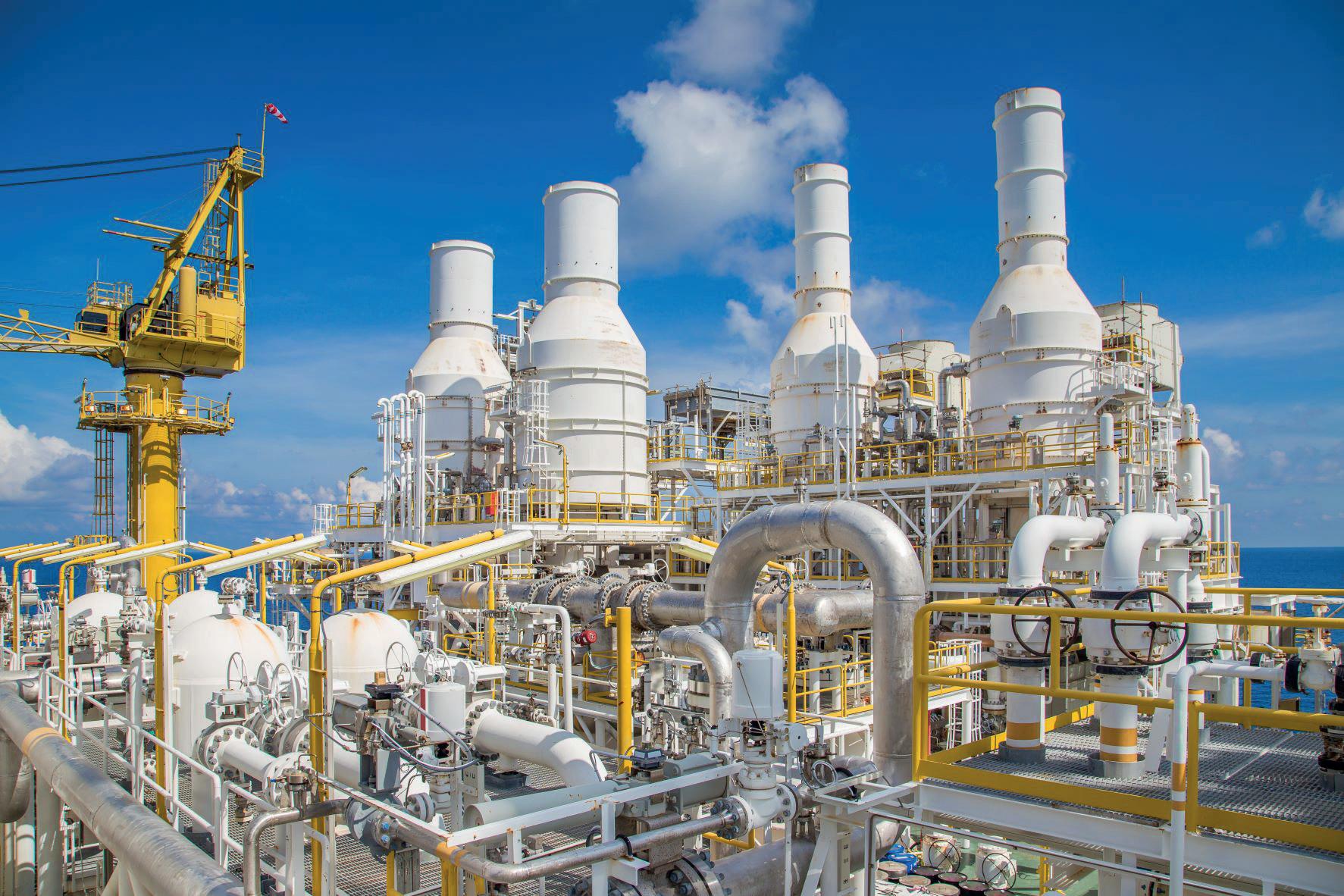
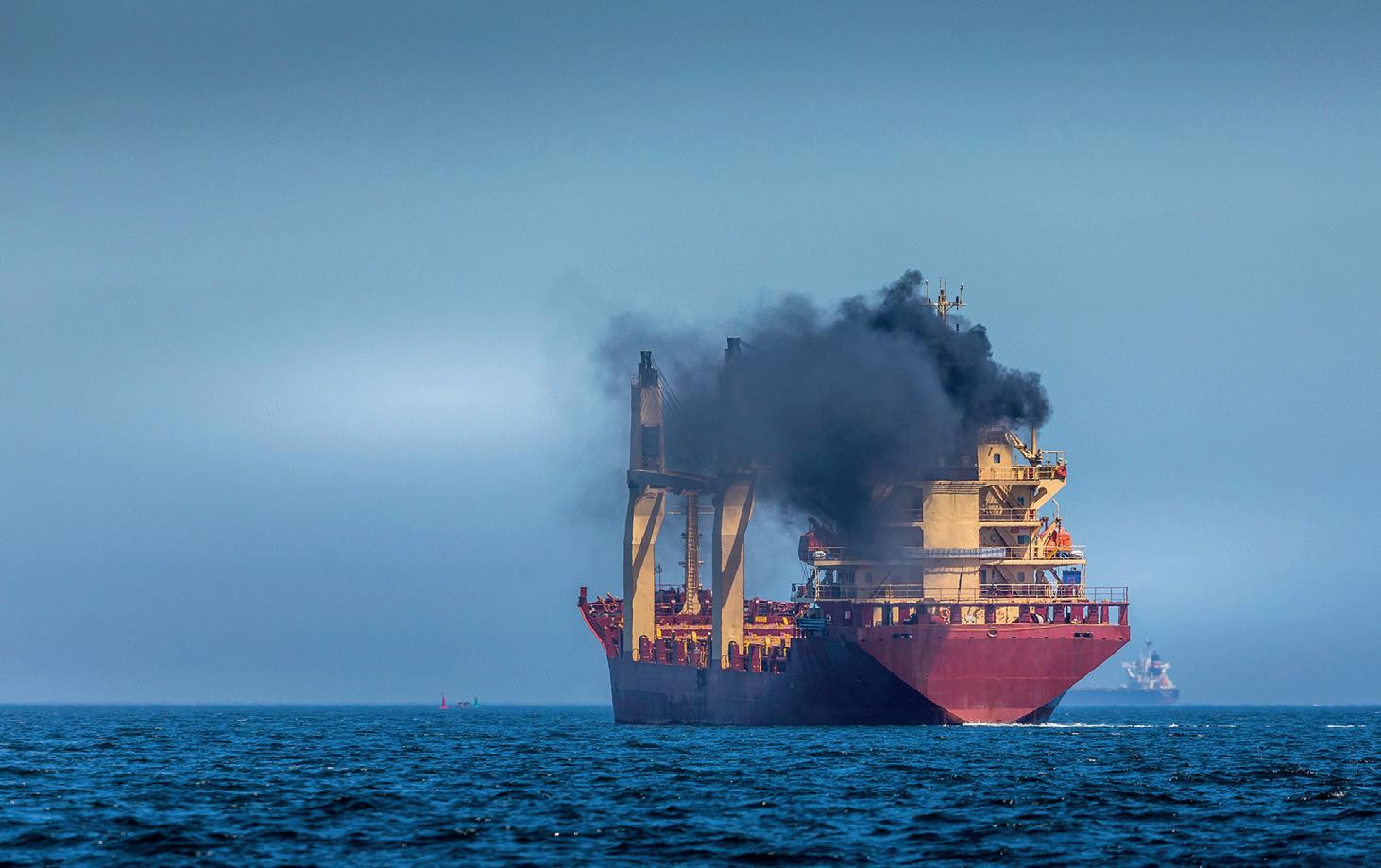


Inside
Supply chain Motors 12 16 6 Technology 20 Interview Ron Beck, AspenTech Contents 2
this issue

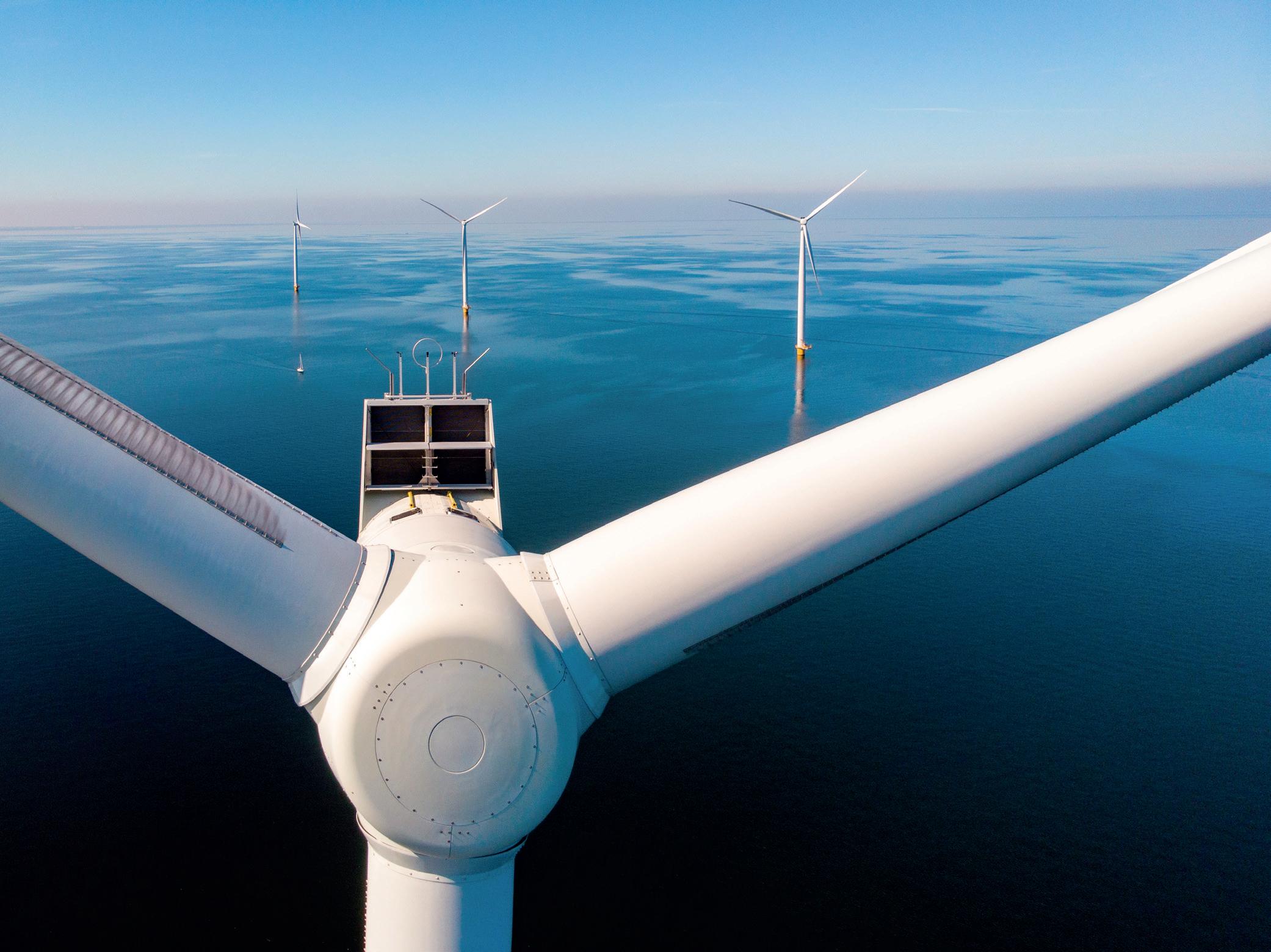
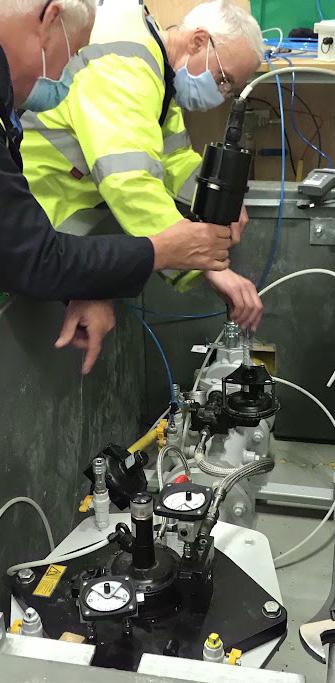

Wind energy News 32 24 Nuclear 28 Exclusive Feature Glander International Bunkering 36 energy, oil & gas magazine energy-oil-gas.com 3


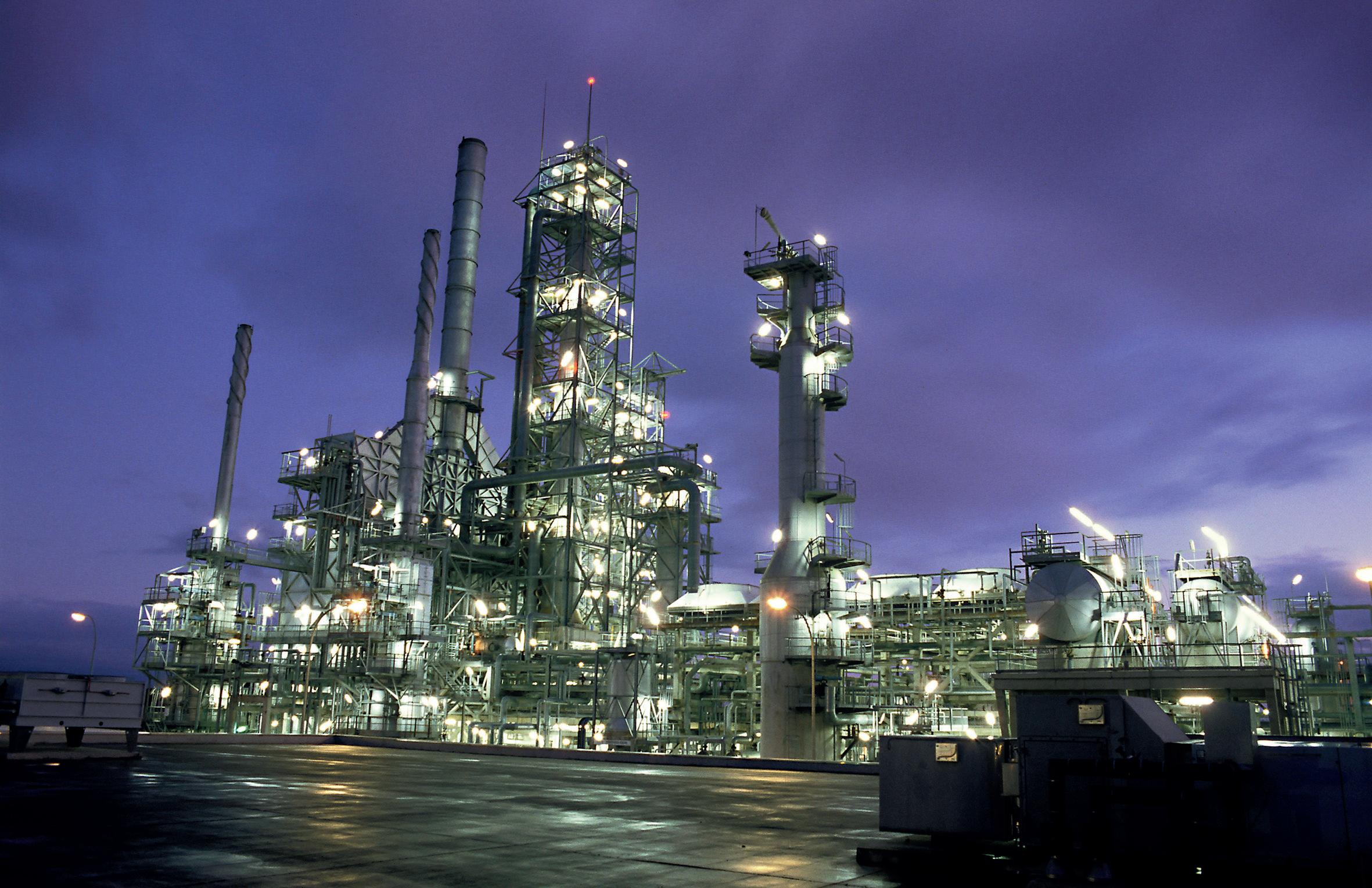

Capstone Infrastructure Corporation 48 Calumet 56 Cover Story Topsoe 42 Exclusive Feature TEPSA 66 Contents 4
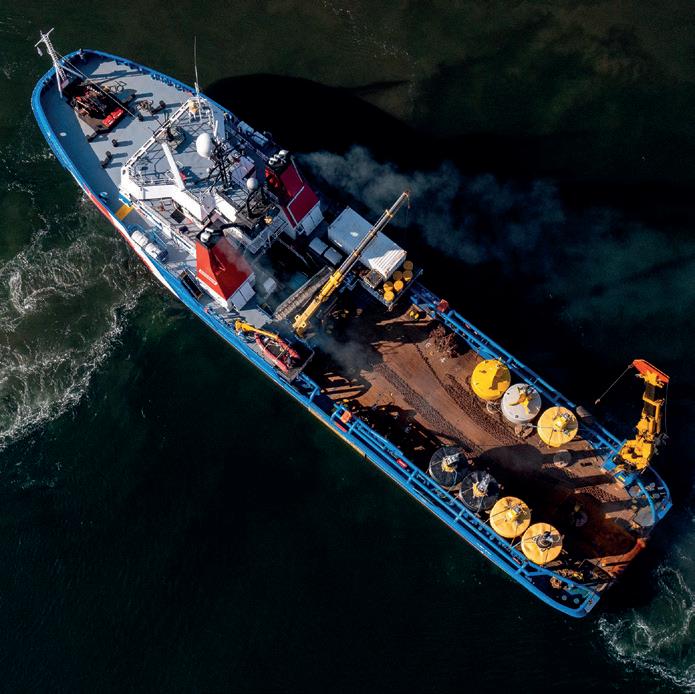

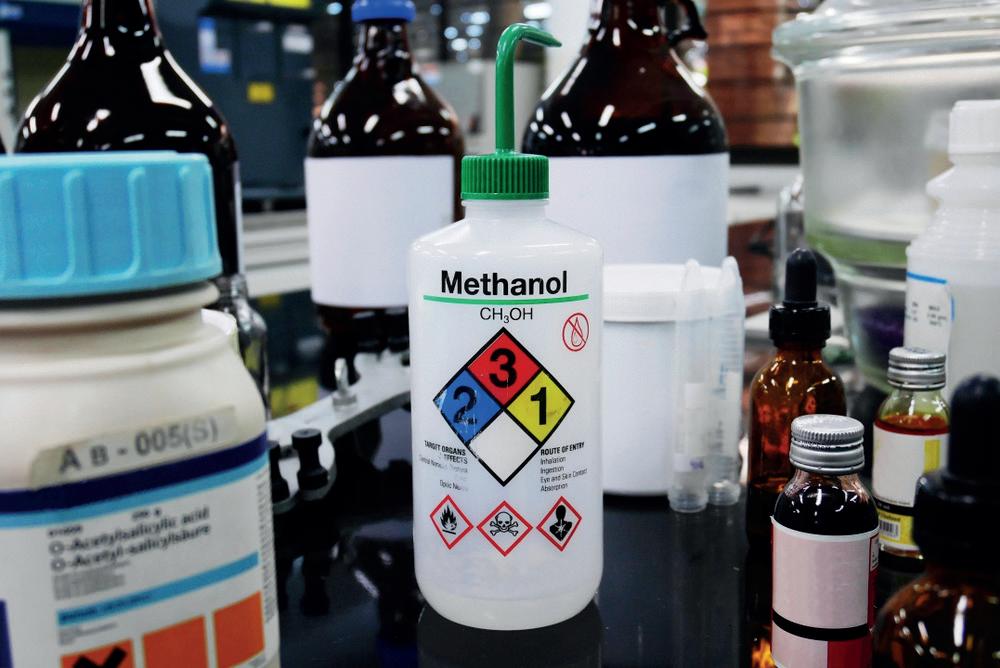
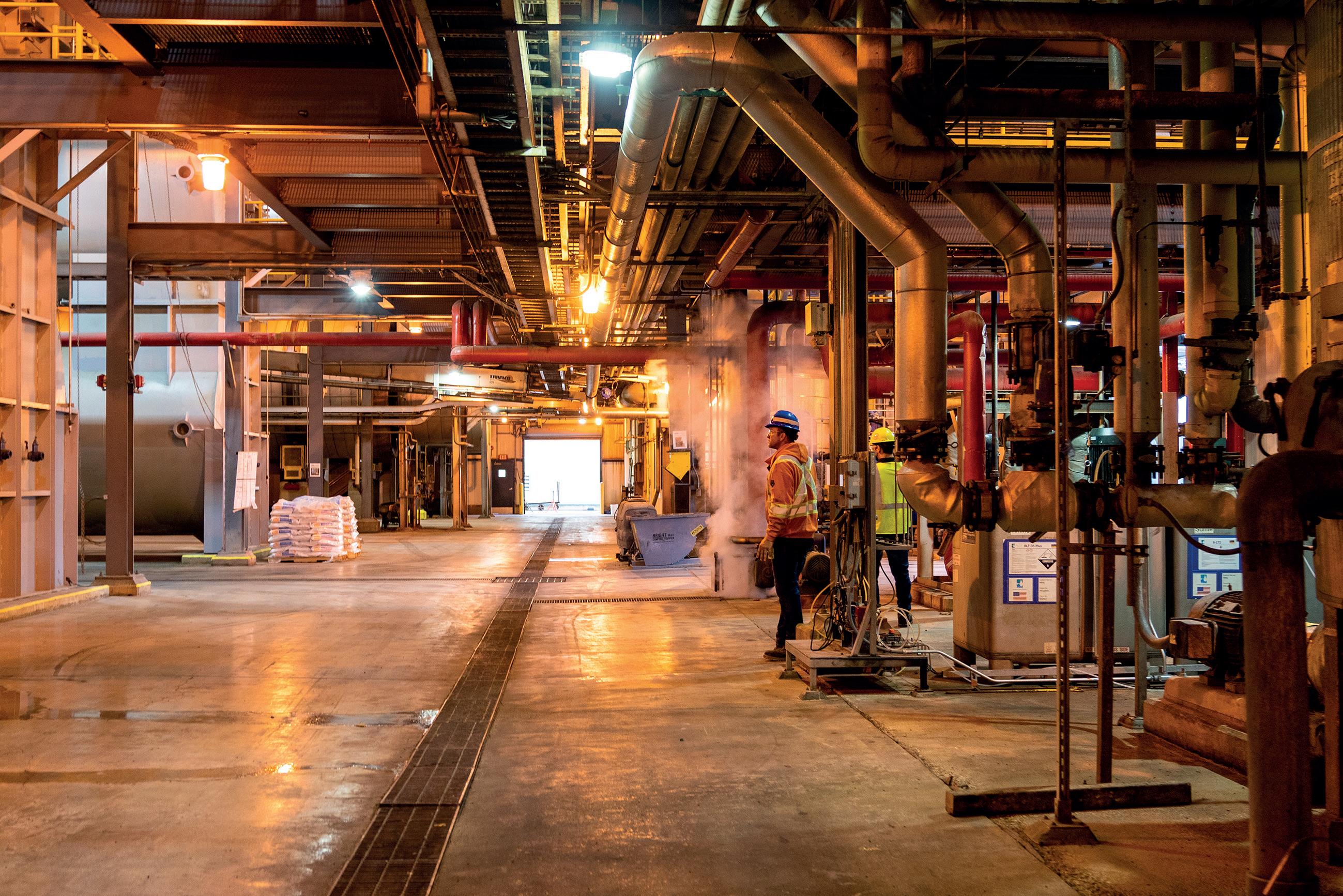
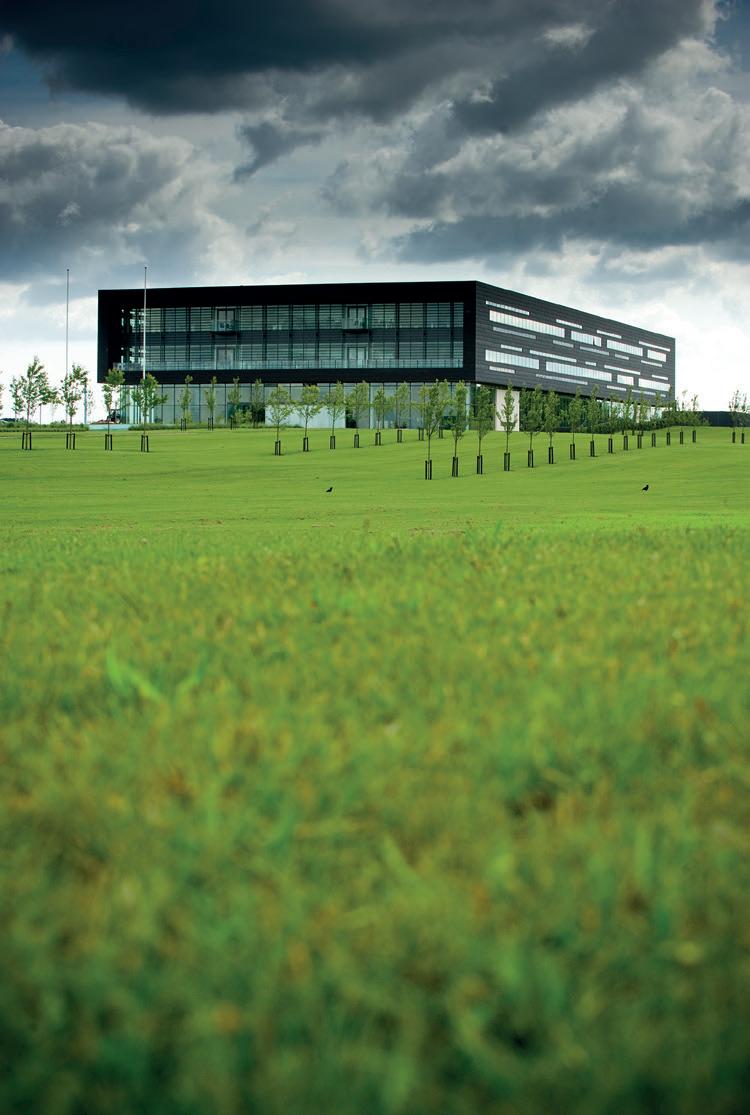

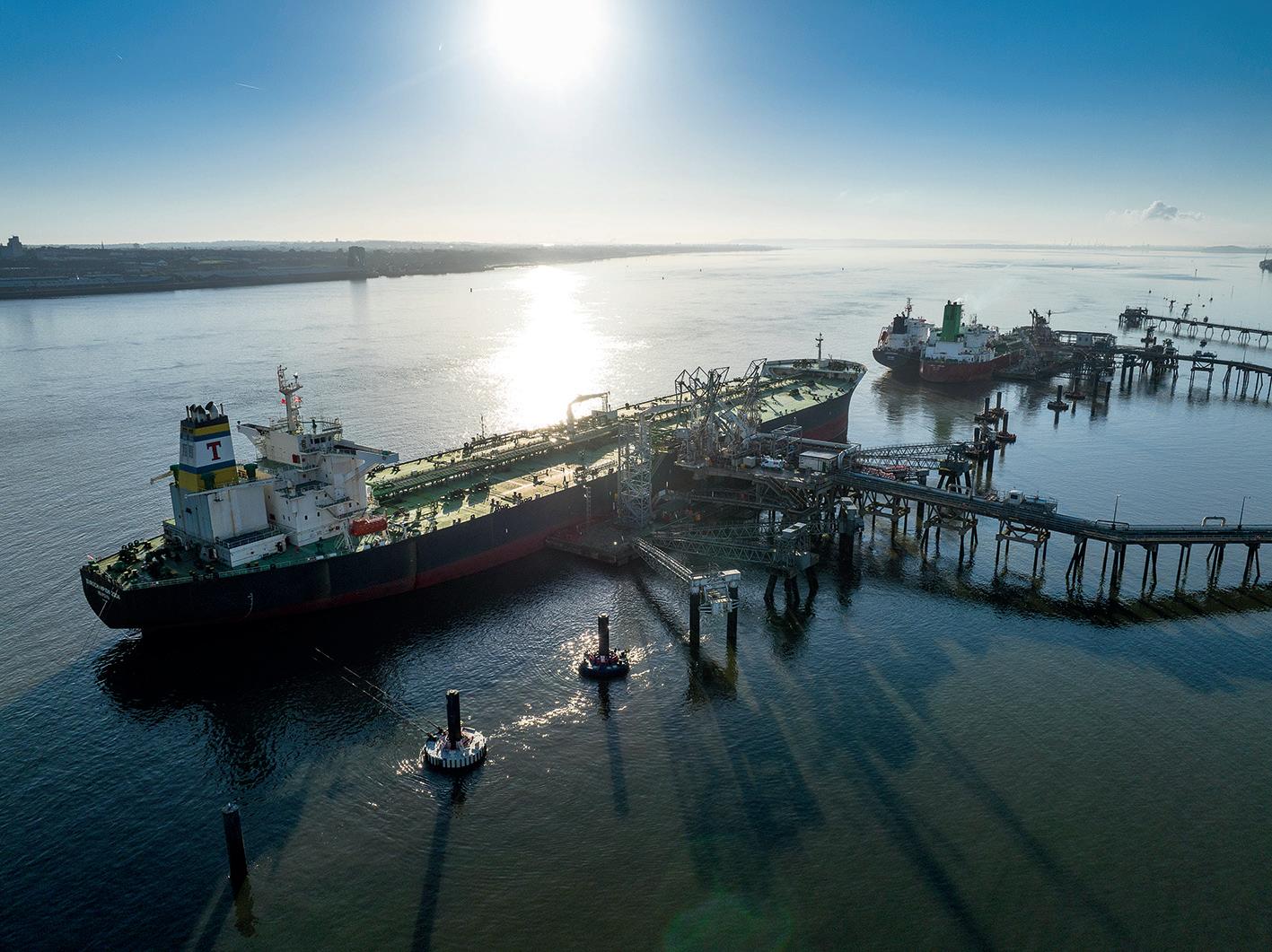
Natgasoline LLC 82 The Andersons Motive Offshore Stanlow Terminals Briggs Marine & Environmental Services Graco Oilfield Services Energinet 88 76 110 92 104 100 energy, oil & gas magazine energy-oil-gas.com 5
Embracing the industry
optimum
Ron Beck, Senior Director, Industry Marketing at AspenTech, explains how digital solutions can help tackle the challenges facing a changing energy sector

6
In April 2021, when the US President announced plans to halve US greenhouse gas emissions by 2030, and to reach net-zero emissions by 2050, it represented a significant event for the climate movement. As the world’s largest economy, and its second largest greenhouse gas emitter, the US had finally joined some other 130 nations in signaling its intention to act on climate change. For advocates of the policy, it signaled the continued shifting of the dial when it comes to attitudes towards decarbonization, and a major step on the road towards a more sustainable future.

Fast forward a year, and we’re facing a very different picture. While the decarbonization movement continues apace, the world finds itself in the grip of an energy shortfall, with rising prices driving up the cost of living for billions of people. It’s a period in which fresh questions are being raised about the future of the energy
sector, including the shift towards renewables. Albeit exacerbating in the short term, the consensus across the sector is that many of these issues are here to stay, as growing populations across the globe place an everincreasing strain on available resources.
“The world needs more energy, and that need is not going away,” says Ron Beck, Senior Director, Industry Marketing at AspenTech, a global asset management software provider. “Most projections foresee a 50 percent growth in our energy need by 2030, driven in part by the emphasis on electrification and the shift towards renewable energy sources. At the same time, demand for oil and gas will continue to rise, at least through the next decade.”
Ron, as he freely admits, is a little before his time. A student of Environmental Studies at Princeton University, he began his career within the field of sustainability, before turning to the energy and chemical industries approximately 30 years ago. Ron joined Aspentech in 2007, when he served as the company’s first industry marketing professional.
Now in his current role, Ron heads up a team that seeks to understand client needs and emergent trends, such as through its recent survey of EPC, and energy and chemical industries professionals, which sought to gauge attitudes towards sustainability and decarbonization. AspenTech’s findings found that such impacts were top-of-mind, particularly in Asia, Europe, and North America. In the case of the latter, 40 percent of respondents believed that sustainability represented

Interview 7
Ron Beck
energy-oil-gas.com
an existential impact for their company. Meanwhile, 77 percent of companies believed that having a strong CO2-reduction strategy represented either a moderate or significant competitive advantage.

“Particularly in the US, the political outlook when it comes to sustainability remains fragmented,” Ron comments. “In that context, these findings are really fascinating. On the one hand, they demonstrate how government policies are capable of driving consumer behavior, be it incentives for driving electric cars, the installation of heat pumps, or otherwise. At the same time, we’re seeing the impact of major financial houses, with investment banks such as JP Morgan Chase and
BlackRock taking a more active role in identifying sustainability risk factors, and scrutinizing their investment project on that basis. That, in turn, drives companies to report on their greenhouse gas emissions, if for no other reason than financial, and risk transparency.”
Despite the all-encompassing nature of the energy transition, Ron observes a significant divergence in strategic thinking when it comes to grappling with the change. “In the absence of upstream oil investment, US-based hydrocarbon producers such as Chevron and Exxon Mobil have established themselves among the largest global investors in carbon capture, as they seek to utilize their existing energy resources
“ “ “ “ 8
Nowadays, almost every refinery has some form of APC installed, with exact application determined by profitability and emissions reduction
more effectively,” he argues. “By contrast, European-based companies such as Shell and BP are diversifying down the energy pathway, viewing their future as broader energy companies, as opposed to operating strictly within oil and gas.
“This evolution is being driven by the EU itself, where sustainability reporting is now a legal requirement,” Ron adds. “As such, the pace of digital investment has soared, as companies seek to gain a better understanding of their emissions footprint, and develop support systems to help them make decisions to move towards carbon-zero.”
According to Ron, it’s these digital technologies that hold the key to accelerating
decarbonization of key industries. The majority of these fall under the umbrella of Advanced Process Control (APC), a broad range of techniques and technologies implemented within industrial process control systems, with proven ability to deliver energy savings of upwards of ten percent. For companies, such measures are a win-win: helping to reduce carbon emissions, while also driving enhanced profitability.
“Nowadays, almost every refinery has some form of APC installed, with exact application determined by profitability and emissions reduction,” Ron comments. “At the same time, more advanced companies are pioneering the integration of digital twins, dynamic optimization, and utility

Interview 9 energy-oil-gas.com

10
optimization, each of which deliver further energy savings.”

In tandem with the emphasis on decarbonization, another trend taking hold of industry is electrification. This, as Ron points out, is more than a matter of electric vehicles or domestic heat pumps, but involves the electrification of major chemical and industrial plants, by substituting fossil fuels for renewable alternatives.
“In the making of plastics, for instance, one of the basic building blocks are olefins, which consume a very significant portion of energy within the chemical value chain, through a process known as ethylene cracking,” Ron explains. “In Europe, pilot projects are already underway to test an electrified ethylene cracker, with large scale use a possibility within the next two decades. Exactly how fast that date arrives will largely depend on the incorporation of digital technologies, which once again have the potential to be huge accelerators as companies seek to roll out these and other energy-efficient processes.”
Any attempt to electrify industry isn’t without its challenges, such as regulatory issues, combined with an ageing international grid. “As it exists today, our grid was never designed to work in two directions,” Ron says. “Even many of the digital technologies that we’re now implementing were originally designed for a centralized grid. As rooftop solar arrays and batteries become more common, the question arises as to how we can use the grid more effectively, and what form the grid might have to take in the years to come if we’re to fully realize the potential that these technologies have to offer?
“If we’re hoping to achieve anywhere between 35-to-50 percent of vehicles running on electricity by 2035, then these are the kinds of innovations we need to pursue,” he insists. “Add to that the growth we’re seeing in the scale and number of cloud computing companies, which have already become very significant global consumers of energy, and the need for an intelligent grid is only going to increase.”
In particular, a growing uptake of artificial intelligence is expected to further accelerate the pace of change. “Looking beyond individual plants, and beginning to tackle questions such as how to optimize a network of plants across a whole country or region, you not only need proven optimization technologies, but you need to apply data in better ways,” Ron continues. “Introducing AI capabilities can help to achieve that, while also providing a solution to the growing shortage of experts who know how to intervene with operational software.
“Beyond that, we can expect to see far more transparency within the areas of carbon emissions and recycling,” he rounds off. “If a new fashion brand comes out with a new raincoat claiming to be made of 80 percent renewable plastic, technology will soon enable that to be tracked and reported. Similarly, at gas stations throughout North America, startups are harnessing the power of digitalization to offer different pricing options for gasoline containing varying proportions of biofuels, bringing unprecedented levels of dynamism to that product offering.” ■
“ “ “ “ Interview 11 energy-oil-gas.com
As rooftop solar arrays and batteries become more common, the question arises as to how we can use the grid more effectively
Motoring on
Five considerations to improve the efficiency of motors in the oil and gas industry.
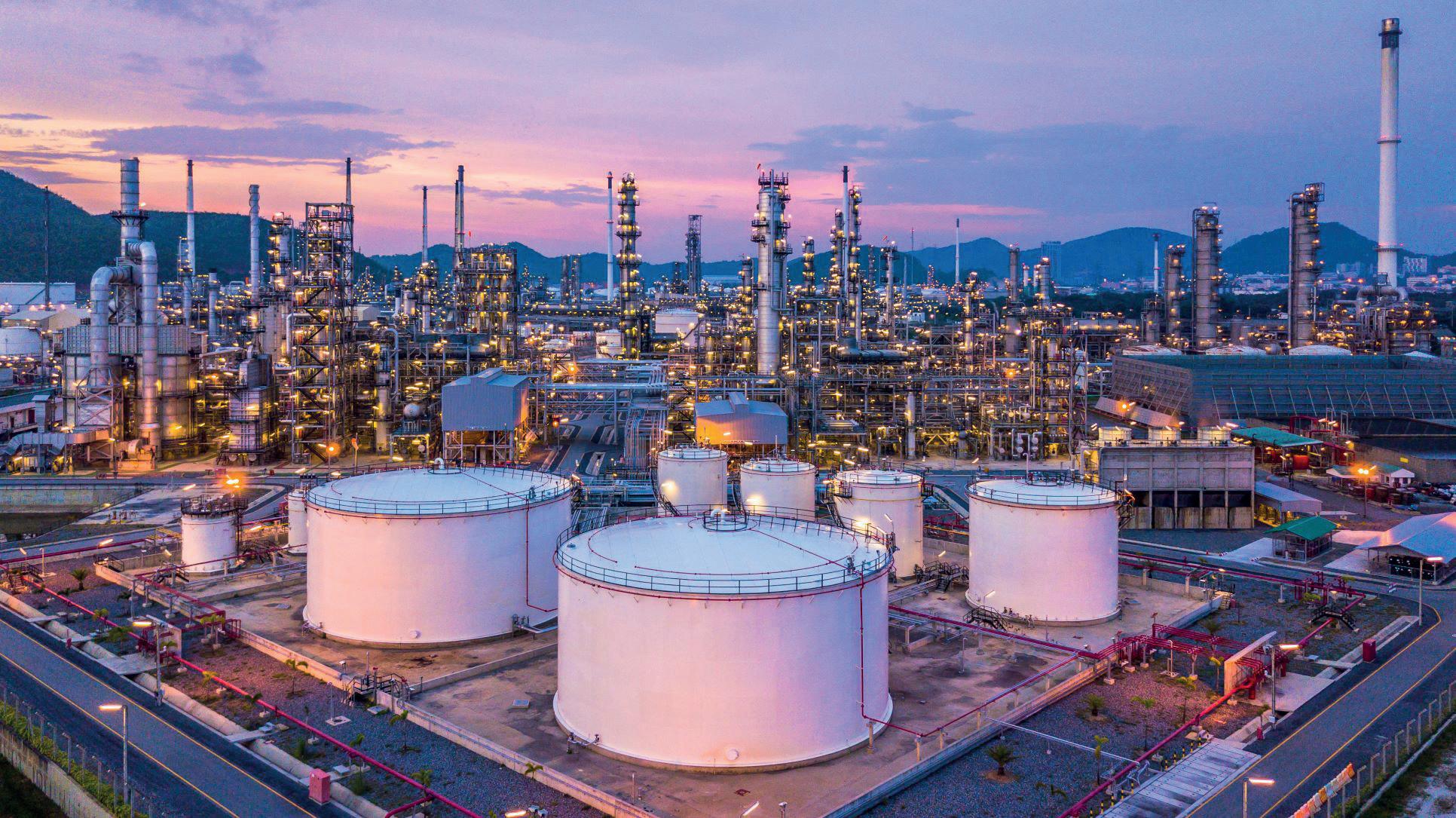 By Marek Lukaszczyk
By Marek Lukaszczyk
According to McKinsey, most oil and gas operators have not maximized the production potential of their assets and offshore platforms are, on average, running at only 77 per cent of maximum production potential. Industry-wide, this shortfall represents a whopping $200 billion in annual revenue. Optimizing
motor performance can contribute to more efficient and effective production processers in the oil and gas industry.
Energy efficient oil and gas processing begins with efficient facility design and this includes the choice of each piece of equipment in each individual process. More and more, we are seeing an increasing number of oil
12
and gas companies adopting a wider range of technologies that are helping them become more efficient and minimizing costs.

While efficiency improvements should be considered as a facilitywide strategy instead of limited to one individual asset, electric motors play a key role in the oil and gas production and distribution infrastructure. They are widely used to drive equipment such as pump and compressor systems and thus offer great potential for efficiency gains. Let’s explore five considerations to improve the efficiency of motors in the oil and gas industry.
High efficiency motor upgrades
Europe has over eight billion electric motors in use across industry, consuming approximately 63 per cent of the electricity generated across the continent. Many motors used in oil and gas applications are either low efficiency or not properly sized for the application. Incorrect sizing can significantly impact the efficiency of motor performance.
Similarly, older motors may have been rewound, reducing their efficiency. For this reason, a cost benefit analysis should be completed prior to rewinding to determine if purchasing a higher efficiency motor is economically advantageous. Hazardous area motors are now available with high efficiency ratings to IE3 or IE4.
Because energy consumption accounts for 96 per cent of the total life cycle cost of a motor, paying extra for a premium efficiency motor will result in return on investment over its lifespan. The recent introduction of stricter ecodesign requirements (EU 2019/1781) for electric motors has accelerated this trend.
Until 2021, some motors, including those designed for hazardous areas, were exempt from energy efficiency regulations. This is no longer the case under the current regulations. Additionally, these regulations also now apply to variable speed drives (VSDs). The legislative changes have impacted many industries, but sectors with high energy usage or using ATEX motors, such as the oil and gas industry, have seen the greatest transformation.
The new regulations replaced the regulation EC 640/2009 and have brought reductions in energy consumption related to motor use,
13 energy-oil-gas.com Motors
of safety. It is estimated that by 2030, this will deliver extra energy savings of ten TWh/yr and GHG emission reduction of three Mt CO2 equivalent annually.
Motor sizing
Significant improvement to motor design can be achieved, without substantially increased costs. However, the electric motor must always be properly dimensioned according to its real load. If a motor is oversized, with the actual load less than 50 per cent of the rated load, it will reduce efficiency and power factor values. For this reason, it’s important that efficiency and sizing considerations go hand in hand.
There may also be additional factors to bear in mind when choosing ATEX motors for oil and gas applications. As a result of safety requirements, explosion proof motors (Ex db, Ex dc) may face
as derating for VSD operation or reduced starting current. This may result in a larger frame size and additional considerations when retrofitting equipment with a need for motor interchangeability.
Installing a VSD or soft starter
Although very few oil and gas applications require 100 per cent flow continuously, many of the motors employed in these applications, such as pumping systems, are started at full speed and remain at full, fixed speed while in use. VSDs can effectively control rotating equipment and offer the best efficiency advantages in variable torque applications. In fact, according to the European Committee of Manufacturers of Electrical Machines and Power Electronics (CEMEP) a 20 per cent reduction in speed could lead to a 50 per cent reduction in energy.

14
To deliver the maximum energy saving potential, VSDs must be commissioned and installed correctly. This is where partnering with an expert like WEG really pays off. If the VSD hasn’t been properly configured this can impact the performance of the system. To maximize VSD reliability start by considering the application conditions and the required speed. Parameters usually have a ‘default’ setting which will probably be adequate for most applications. However, these should be checked and adjusted for optimum operation. Motors are often left to idle, which uses energy unnecessarily. This is where soft starters should be considered. As the name suggests, soft starters allow the motor to start the load more gradually by limiting the voltage to the motor and providing a reduced torque. In addition to reducing energy consumption, a reduced voltage soft starter helps protect the motor and connected equipment from damage by controlling the terminal voltage.
Digitalization and motor performance sensors
Correctly implemented data analytics systems and tools can overcome the operational complexity of oil and gas operations. By combining advanced engineering, the latest data science and computing power, there’s potential to make improvements across the board.
Instead of replacing conventional methods of operation, digitalization will supplement them. For example, to keep motors running optimally in oil and gas plants, managers can install retrofit sensors. With important metrics monitored in real-time, built-in predictive maintenance
analytics will identify future problems, preventing shutdown and potential safety concerns.
Correct maintenance practices
Regular maintenance should be carried out on the entire motor system. Performance will naturally decrease after prolonged heavy-duty use or the exposure to harsh conditions. Engineers should opt for products that can provide energy efficient operation in harsh oil and gas environments. Like many energy-intensive industries, the oil and gas sector is exploring new solutions to increase production and energy efficiency. As the sector continues to evolve, it will continue to rely on high efficiency technology as a reliable pillar in the wider energy efficiency drive. ■
For a list of the sources used in this article, please contact the editor.
Marek Lukaszczyk www.weg.net
Marek Lukaszczyk is European and Middle East marketing manager at WEG. Founded in 1961, WEG is a global electric-electronic equipment company, operating mainly in the capital goods sector with solutions in electric machines, automation and paints for several sectors, including infrastructure, steel, pulp and paper, oil and gas, mining, among many others.
WEG stands out in innovation by constantly developing solutions to meet the major trends in energy efficiency, renewable energy and electric mobility.
15 energy-oil-gas.com Motors
How to stay afloat
Why shipping is sink or swim for Scope 3 in oil and gas.
 By Kris Fumberger
By Kris Fumberger
Reports from the IPCC and the International Energy Agency have dramatically raised the stakes for decarbonizing the oil and gas industry, imposing tough targets for transition to net zero by 2050. Investors have also piled on the pressure, with over 20 global investors last year outlining how companies must reduce and report emissions to qualify for inclusion in future net zero portfolios. Yet recent analysis reveals that the sector is on course to miss the 1.5°C mark by a significant margin, with the World Benchmarking Alliance predicting the top 100 oil and gas companies will overshoot the target by 2037.
This is worsened by the fact there is currently no sector-wide standard or best-practice methodology for
achieving net zero across the oil and gas industry. The Science-Based Targets initiative (SBTi) published a universal methodology for net zero in October 2021, while the independent Global Reporting Initiative (GRI) released a new sector standard for net zero emissions by 2023. Without a universal guide to decarbonization within scientifically advised limits, oil and gas companies are effectively left to chart their own course to net zero.
The hidden emissions in the industry’s wake
In the absence of universal standards, the oil and gas industry has instead adopted a widely varying array of individual approaches which do not necessarily cover the true scope and scale of their emissions.
16
One of the biggest challenges for oil and gas companies is accounting for Scope 3 supply chain emissions, including up and downstream shipping. This is despite the fact that Scope 3 emissions account for 88 percent of all oil and gas greenhouse gas emissions and that failure to curb supply chain CO2 could cause fossil fuel firms to miss net zero targets. Shipping emissions could soar 50 percent by 2050 which risks significantly increasing the carbon footprint of the oil and gas industry. Tankers largely powered by ‘dirty’ marine diesel and heavy fuel oil remain the primary mode of transport for intercontinental oil movement.

Pioneering oil and gas leaders are now using independent vessel selection criteria to analyze total supply chain shipping emissions and even predict future emissions
“ “
“ “
17 energy-oil-gas.com
Supply chain
Bringing transparency to shipping
It is a daunting task to calculate shipping related emissions, made exponentially more so due to diversification and globalization of supply chains. The industry is also falling behind on measuring as well as managing emissions. Ships have recently improved at digital data capture and communication but many are still failing to derive insights from that data, which could dramatically increase carbon accountability and energy efficiency across supply chains. Shipping lags behind many other industries such as automotive and aviation in adoption of technologies such as AI and data analytics. For example, there is no universal big data analytics framework for ship performance monitoring to improve operational energy efficiency.
Transparent, actionable data is critical to helping the oil and gas industry record and report as well as ultimately reduce its shipping related emissions. For example, RightShip has launched a digital platform that ranks ships on environmental performance by accurately assessing the relative energy efficiency and theoretical CO2 emissions of each ship relative
to vessels of a similar size and type. It even enables vessel companies to benchmark the performance of their fleet compared to the world fleet. Vessel owners can upload data such as recent energy-saving upgrades directly into the digital platform to create dynamic, data-driven GHG rankings. This data could ultimately be used to demonstrate compliance for bodies such as the SBTi, who introduced net zero standards and methodologies for oil and gas.
Transparent, data-driven vessel selection can give the oil and gas industry unprecedented visibility over their shipping related Scope 3 emissions and enable accurate carbon accounting for investors, governments and other stakeholders. Companies can benchmark annual progress towards net zero against equivalent vessels and even global fleets and accurately forecast future emissions. Independent vessel selection criteria, as part of a due diligence process, can also be used to select more energyefficient or even renewably powered vessel designs, driving decarbonization of supply chains at source.
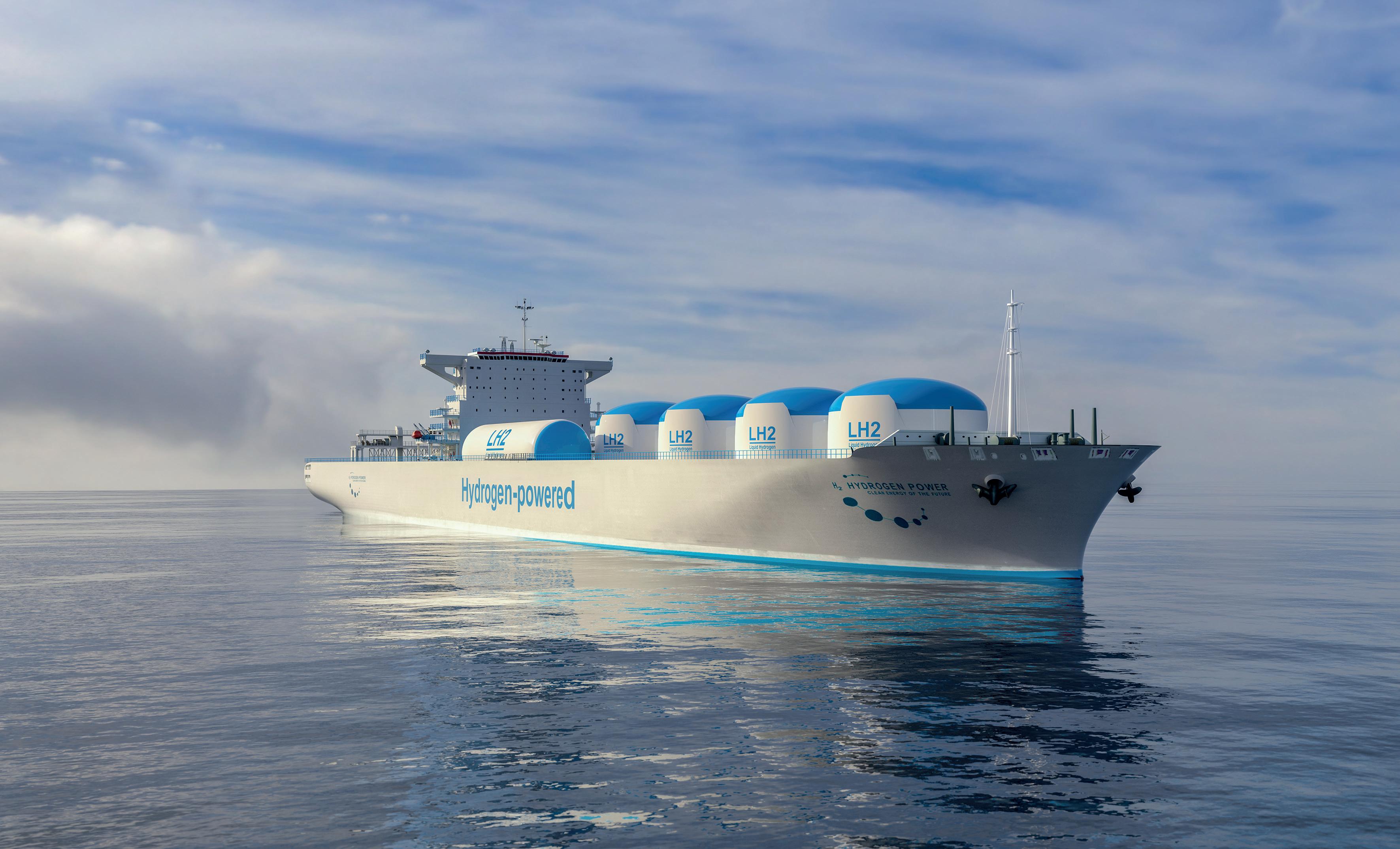
18
Pioneering oil and gas leaders are now using independent vessel selection criteria to analyze total supply chain shipping emissions and even predict future emissions across everything from specific supply routes to ship and cargo types. This information can help to rank individual suppliers on carbon emissions, and to reveal and remove carbon-intensive logistics companies from the shipping supply chain. Independent carbon accounting can also facilitate more intelligent optimization of cargo loads, ship speeds and trade routes to cut CO2 emissions. Research has shown that distance is the main driver of shipping emissions and we have helped major logistics firms use voyage optimization to dramatically reduce CO2 output.
However, as well as reducing fuel usage, ships will ultimately need to match other transport sectors and switch to renewable fuels. Hydrogen-derived green ammonia offers a sustainable fuel of the future for shipping supply chains. Ammonia can be made with renewable power, water and air, does not need to be stored in pressurized tanks or cryogenic dewars and can power both fuel cells and

internal combustion engines. Australian mining giant Fortescue recently pledged to convert its entire fleet of 100 vessels to green ammonia within the decade as part of a drive to bring its Scope 3 emissions to net zero by 2040.
The voyage to net zero
The oil and gas industry is steeped in history, but this has also meant it remains mired in old operating models and systemic behaviors that are hard to shift. Yet, confronting and changing shipping related emissions will be pivotal to ensuring the oil and gas industry meets its net zero targets within scientifically advised timelines.
The key is to use independent vessel selection processes to bring greater transparency to shipping related emissions and inform data-driven solutions from changing routes and suppliers to transforming technology. This is the key to bring greater central visibility over emissions across fragmented, far-flung supply chains and accelerate the drive to net zero across the value chain. ■
For a list of the sources used in this article, please contact the editor.
Kris
Kris Fumberger is Head of Sustainability and Environment at RightShip. Established in 2001, RightShip is one of the world’s leading ESG focused digital maritime platforms, providing expertise in global safety, sustainability and social responsibility practices. Founded with the mission to drive operational improvements in the global shipping industry, more than 4,500 people use RightShip’s due diligence, environmental and inspections services to help them manage risk and improve overall maritime safety standards.
Fumberger www.rightship.com
19 energy-oil-gas.com Supply chain
BLUE SKY THINKING
Using autonomous drones to inspect pylons
By Kathryn Fairhurst
Building a net zero power system fit for the demands of tomorrow means innovating today – and at National Grid Electricity Transmission (NGET) we know that innovation and collaboration are the best way to tackle some of the biggest challenges in energy.
As the body responsible for building and maintaining the infrastructure to transmitclean electricity to homes and businesses across the country, we have a key role to play in Britain’s decarbonization journey. But it’s a journey we’re on together with industry.
Over the last year we’ve teamed up with 19 partner organizations on over a dozen NGETled innovation projects funded by Ofgem’s Network Innovation Allowance (NIA) and its new Strategic Innovation Fund (SIF).
One project is particularly eye-catching, and sees us working with deep tech startups Keen AI and sees.ai to boost our field operations by harnessing the latest in artificial intelligence and autonomous flight technology.
We’ve launched trials of a system which, using computer-manned drones, aims to fully automate the capture and processing of data that tells us what condition our pylons and overhead lines are in.
This is a job our field ops teams have traditionally carried out on foot or by helicopter, which is an enormous task. We own 21,900 steel lattice pylons that carry overhead transmission conductor wires across England and Wales, each of which needs a routine close-quarter health assessment to monitor for corrosion which can affect them over time.
There’s only a certain number of pylons our field teams can assess in a year – normally around 3650 – owing to limitations with our current methods.
For example, our expertly trained engineers can ascend the pylons to inspect them. That’s much safer today with modern climbing equipment and precautions we have in place, but it’s slow and not without risk. Our helicopters can help us cover a wider area, but do not allowus to inspect the pylons up close – not to mention being less carbon-efficient.
More recently we’ve used manually-flown drones. This has significantly enhanced our capability – allowing closer inspections without associated risk – but these drones are still resource-intensive, needing a team of pilots and spotters to keep them in sight at all times to ensure safe operation.
20

21 energy-oil-gas.com Technology
Autonomous drones could be a game-changer, and it’s why we’re so
a pool of inspectors. With the help of sees.ai’s autonomous drone inspection system, in our trial the data and imagery are automatically transmitted to an AI system –courtesy of Keen AI’s technology – which assess corrosion, proposes maintenance work, and can even predict the future state of a pylon.
It’s not only enabling the capture of data that’s optimal for automated processing; it’s also increasing the speed, efficiency and consistency of
Currently, images from our helicopter and manned-drone flights are processed manually by

The trial brings another advantage over manned drones. While the latter needs carrying to the site of the pylons being inspected – and then kept in sight while being flown – our project will enable a fleet of

22
overhead lines to a higher capacity, boosting existing network capacity without the need to build new infrastructure – meaning lower costs for consumers and more renewable generation able to connect to the grid faster.
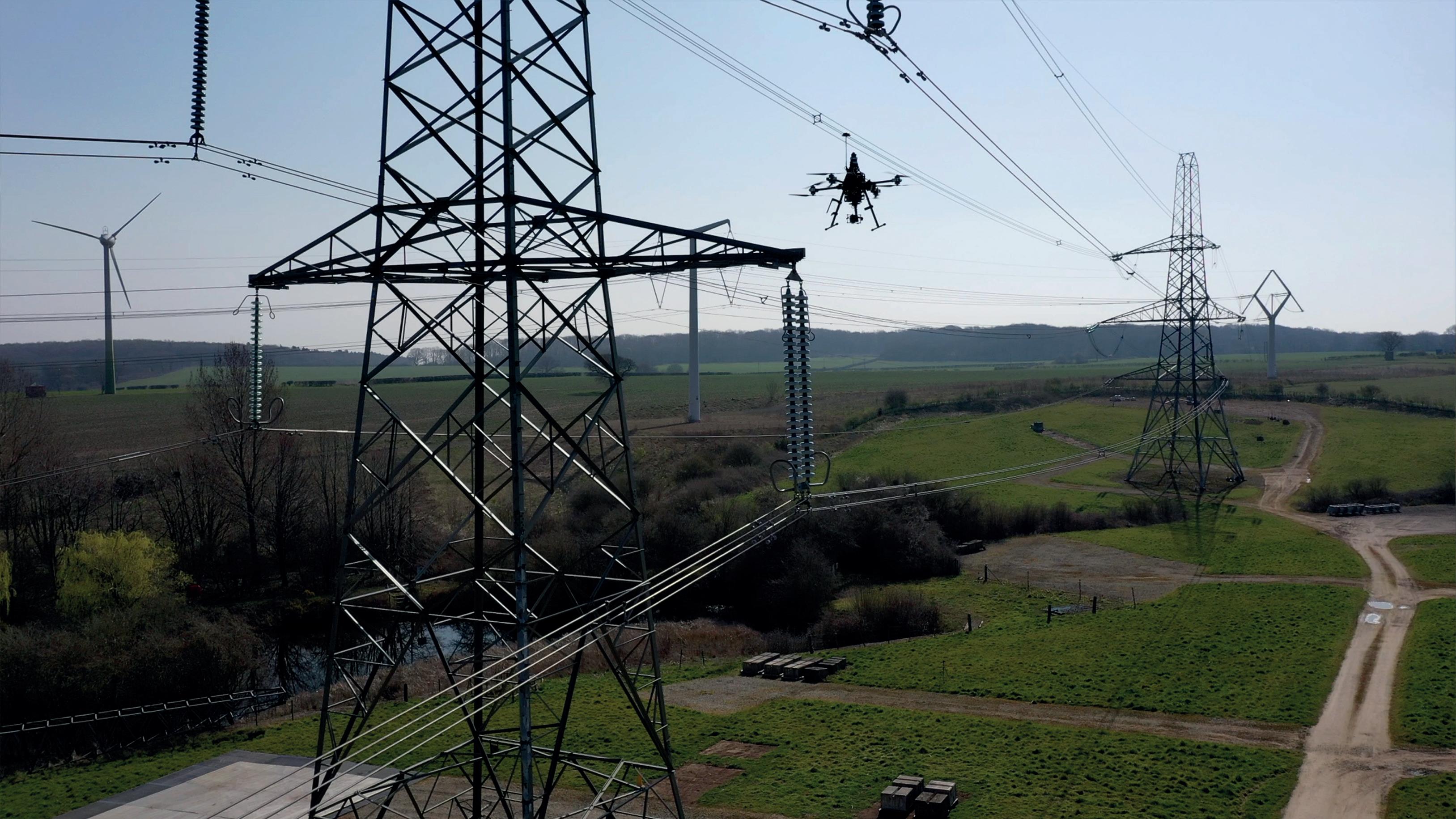
We’re also working with the European Space Agency to harness satellite data to improve grid resilience, enhancing the emergency response capability of Britain’s networks to extreme weather events.
Collaboration is the key ingredient in all of these projects: now more than ever is the time for the energy industry to work together to innovate for net zero. ■
Kathryn Fairhurst www.nationalgrid.com
Kathryn Fairhurst, is Head of Engineering Services, National Grid Electricity Transmission. National Grid Electricity Transmission (ET) owns and maintains the high-voltage electricity transmission network in England and Wales. The company transports electricity through over 5000 miles of power lines and 300 substations en route to Britain’s homes and businesses, and invests £1.3 billion in the network each year to connect more renewables to help achieve net zero.
23 energy-oil-gas.com Technology
True alternative
How to increase the affordability of wind energy.
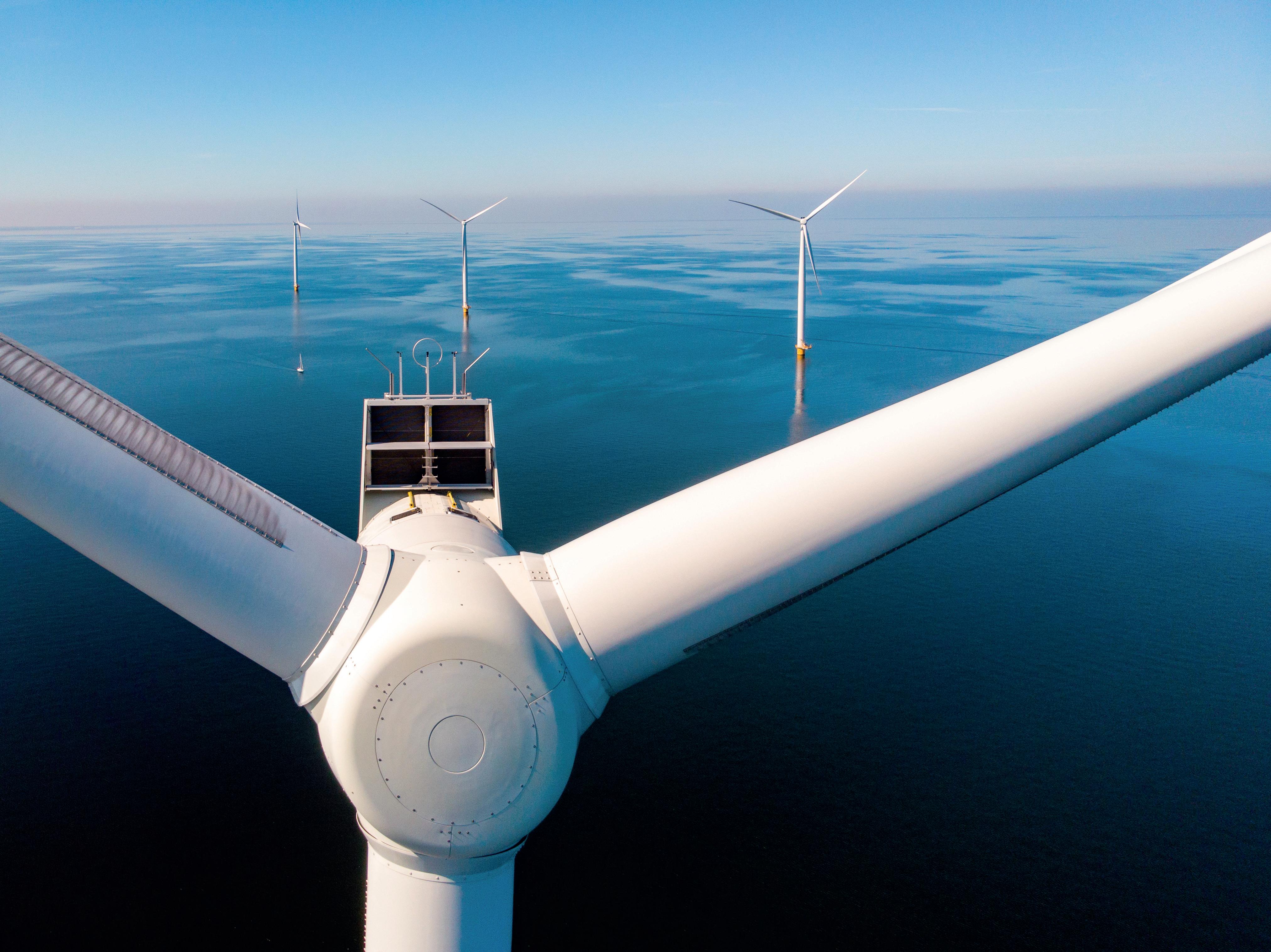 By Wouter Maas
By Wouter Maas
The global transition to renewable energy is crucial to realize a more sustainable future for people and the planet. In fact, renewable energy and energy efficiency measures could achieve up to 90 percent of the carbon reductions needed to minimize climate change, according to the International Renewable Energy Agency.
Countries and organizations are feverishly reviewing their options as they strive to reach important
24
environmental targets. This includes the ambition set at COP26 to keep a maximum of 1.5 degrees Celsius of warming within reach, and the pledge made by 30 firms in the FTSE100 to eliminate their carbon emissions by 2050.
As the world urgently looks for solutions, offshore wind provides a cleaner, safer, and more sustainable energy source. However, even with the best intentions, buyers have unavoidable commercial considerations, and the cost of wind energy needs to be made more affordable. Offshore wind has made

significant strides in terms of cost and is now competitive with conventional sources, however more efficiencies are still needed, particularly at more challenging sites further away from the shore.
The pressure is on global wind farm operators to bring down the Levelized Cost of Energy (LCOE) and provide a financially feasible alternative to fossil fuels.
LCOE: The holy grail in the offshore industry
LCOE is the ratio between total discounted lifetime cost and total discounted lifetime production. This metric is the holy grail in the offshore industry – relied upon by wind farm operators to demonstrate that they can provide the most cost-efficient solution in a highly competitive arena. Indeed, across the sector, asset
Wind energy 25 energy-oil-gas.com
managers are under huge pressure to deliver against LCOE targets and secure new contracts.
With LCOE, buyers can also get a more accurate comparison between the cost of renewables and the cost of more conventional energy sources such as coal and gas. For business decision-makers, it is the most important measure to determine whether it is commercially viable to invest in renewables.
There are, of course, many costs associated with wind projects across the entire asset life cycle – from site characterization through to the design phase, installation, maintenance, and decommissioning. Any efficiencies applied across the value chain can help to bring down the overall LCOE and support the global transition to wind power.
The role of structural health monitoring in reducing LCOE
There is a significant opportunity for structural health monitoring to extend the life cycle of wind farms and, subsequently, reduce the LCOE. In fact, our own analysis suggests that having a wind farm in operation for just one more year could generate more than €165 million in extra revenue to a 77-turbine wind farm.
By monitoring offshore wind turbines remotely with a set of specific sensors, an operator can identify and correct issues such as fatigue, corrosion and scour before they impact the asset’s integrity or performance. Furthermore, if energy prices are low on a turbine with a high fatigue loading, the operator can simply turn it off to reduce its fatigue consumption. This can help to make sure turbines function efficiently to the end of their life cycle and beyond.
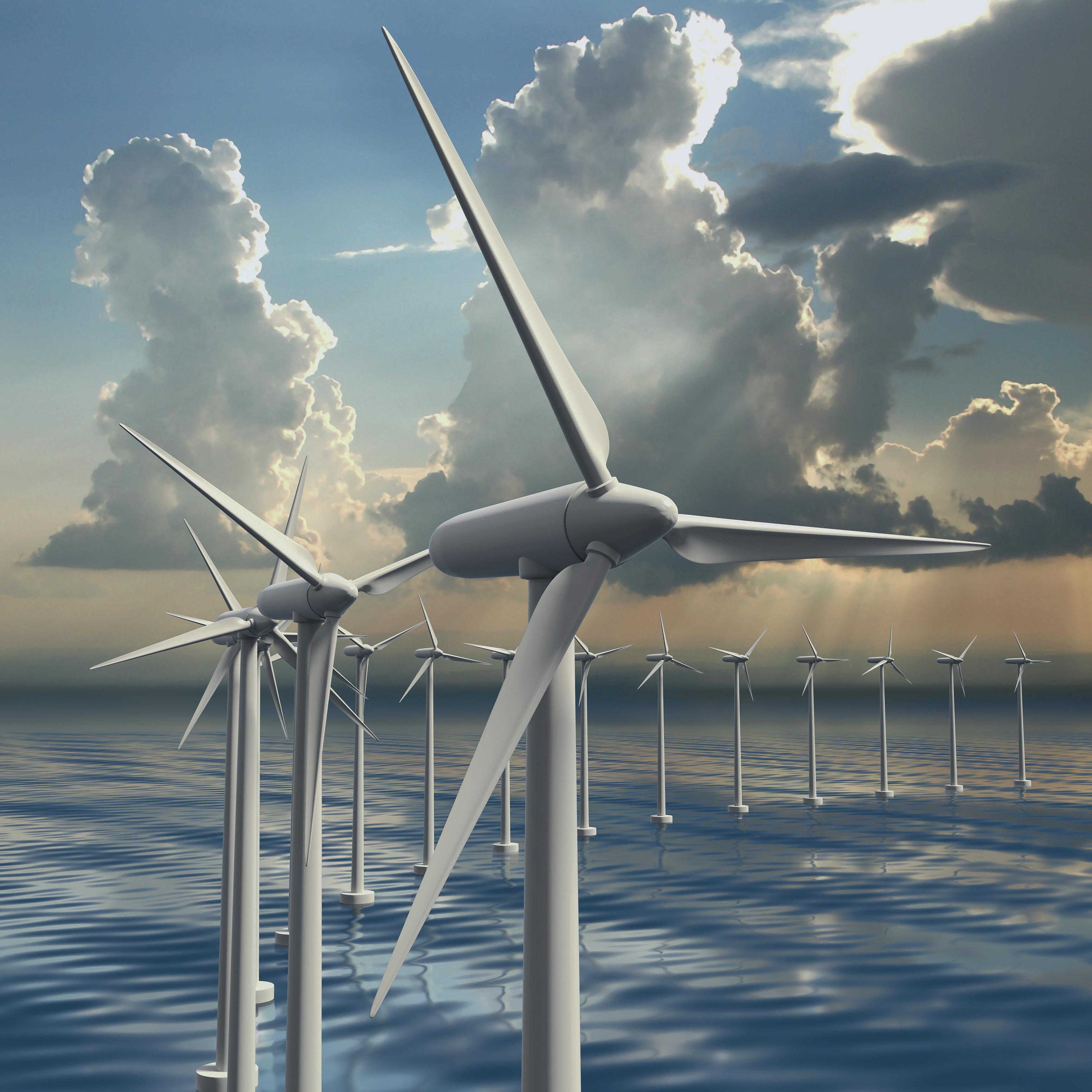
26
Structural monitoring can also help to increase production as it helps to reduce unexpected breakdowns. Tasks such as restoring a corrosion protection system or securing a free-floating cable involve a considerable period planning, however preventative measures can increase the wind farm availability and minimize downtime. This is in addition to costing significantly less than corrective actions. Indeed, a one percent increase in availability could add more than €43 million of production to a 77-turbine wind farm.
Industry innovation
To reap maximum cost rewards, operators should be aiming for subsea inspections to be carried out less frequently. In fact, a shift from four-yearly to five-yearly inspections could reduce OPEX of a 700 MW offshore wind farm by €2.5 million over the asset lifetime.
New innovations are helping to make this a reality. Automated data delivery, for example, can provide real-time access to data and continuous remote monitoring of assets. This can provide early indications of fatigue or failure, helping to reduce the LCOE, enhance asset performance, minimize downtime and failures, and improve safety for wind farms. Overall, better access to realtime data will help operators and asset owners to make informed decisions and implement strategies based on the reality of the situation, versus relying on gut feel. This technological advancement will help to increase the speed from observation to action, improve operational efficiency, and reduce the frequency of subsea inspections.
Operators should also consider the long-term benefit of integrating all available GEO data – from site investigation to asset inspection and
monitoring – into a digital twin of their offshore asset. This will enable conditionbased and preventative maintenance strategies to be implemented on a per turbine basis, maximizing the total value of the asset, and speed, facilitating any decision-making process, and at the same time, extending its lifetime and its value.
Ultimately, structural monitoring combined with remote inspection solutions whether above or below water, will optimize maintenance and extend the wind turbine life cycle beyond 25 years, making it a priority activity for operators and asset owners alike. Those that look beyond daily operations and take steps to ensure the long-term structural health of their assets will unlock significant additional value –helping to decrease LCOE and win a competitive advantage in the market. ■
For a list of the sources used in this article, please contact the editor.
Wouter Maas

www.fugro.com
Wouter Maas is Strategy Director Offshore Wind O&M at Fugro, the world’s leading GEO data specialist. Adopting an integrated approach that incorporates acquisition and analysis of GEO data and related advice, Fugro provides solutions. With expertise in site characterization and asset integrity, clients are supported in the safe, sustainable and efficient design, construction and operation of their assets throughout the full lifecycle. Employing approximately 9000 people in 59 countries, Fugro serves clients around the globe.
Wind energy 27 energy-oil-gas.com
Power for tomorrow ?
The potential for small modular reactors (SMRs) in the future of nuclear energy
By Daniel Garton, Richard Hill, Andrew McDougall QC, Kirsten Odynski, Vit Stehlik and Dipen Sabharwal QC
TerraPower’s recent equity raise of $750 million shows how SMRs are gaining the attention of governments and power providers across the world. The champions of the SMR must work hard to ensure its full potential is reached.
Why SMRs hold such potential in nuclear power projects
Nuclear plants have a role to play in the energy transition. They have a small environmental footprint and keep air clean, requiring only a small amount of fuel compared to gas or coal while taking up a fraction of the space needed for wind and solar farms. In fact, a report published last August by the UN’s Commission for Europe, argued for the crucial role nuclear power can play in the transition to a clean energy future.

28


29 energy-oil-gas.com Nuclear
almost 70 different SMR technologies under development, a significant jump from just a couple of years ago. This is particularly pertinent in light of recent events in Ukraine. Many countries are taking a fresh look at energy independence, as opposed to relying on fossil fuels from neighboring nations. Nuclear power is one of the clearest avenues to secure energy independence and SMR technology will be one way in which to facilitate this for those looking to achieve autonomy.
The challenges at play
Regulation has long been a challenge in nuclear plant development, and this will likely be no different for SMRs. Licensing risk has been a difficult and controversial issue in nuclear power, and has driven significant attention from policy makers, the public and


environmentalists. The proliferation of nuclear plants envisaged by the widespread rollout of SMRs will be unlikely to avoid this scrutiny.
In tandem, the industry must overcome previous generations’ perceptions of nuclear power, in particular that the projects are too costly and complex. This is especially true when compared to both traditional fossil-fuel power generation and the breakneck rollout of renewables.
There is also the issue of waste. NuScale says that because SMRs contain less radioactive material and can be located below ground, their risks are lower. However, this point of view has received criticism from some experts.
There is currently no guarantee that SMR producers will not face the same obstacles that have plagued
30
developers of traditional nuclear power. It will also be a challenge to convince industrial users that it can compete with low-cost natural gas or proven renewables such as wind and solar. And the nature of SMRs mean they will have to be built close to the communities they serve, raising new challenges for public engagement, especially around the waste problem.
The introduction of a new generation of nuclear power will undoubtedly lead to legal and commercial disputes. The intense scrutiny from policymakers and the public will likely cause delays and conflicts. As will jockeying for position in a potentially more competitive nuclear industry marketplace. With first-of-a-kind designs, and potentially new and less experienced players entering the market, comes increased risk of regulatory issues, time lags, cost barriers and general conflicts. It’s vital to understand the nuclear regulatory framework and the nature of risks that commonly arise concerning the nuclear projects, in order to navigate these issues and minimize their impact.
Unlocking SMRs full potential

The SMR has widespread support, from politicians to global companies. The technology’s offering is compelling: carbon-free power that’s reliable, safe, more affordable and can be built and deployed without the significant costs and complexity of traditional nuclear power.
In a world where investment decisions are increasingly measured against climate impact and compatibility with the Paris climate goals, the SMR offers a solution

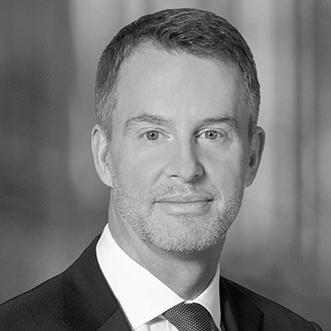
without many of the drawbacks that have hindered its larger predecessors.
As with all new technologies, there are of course challenges to overcome, and with nuclear power specifically, these can be expensive and protracted. The champions of the SMR will have to work with all stakeholders, from governments and investors to the wider public, to ensure its potential can be fully unlocked. ■

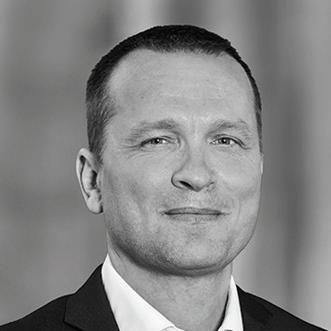
www.whitecase.com

31 energy-oil-gas.com Nuclear
Daniel Garton, Richard Hill, Andrew McDougall QC, Kirsten Odynski, Vit Stehlik and Dipen Sabharwal QC are partners at law firm White & Case. White & Case is a leading global law firm with lawyers in 45 offices in 31 countries. Among the first US-based law firms to establish a truly global presence, it provides counsel and representation in virtually every area of law that affects cross-border business. Its clients value both the breadth of its global footprint and the depth of its US, English, and local law capabilities.
Daniel Garton, Richard Hill, Andrew McDougall QC, Kirsten Odynski, Vit Stehlik and Dipen Sabharwal QC
For a list of the sources used in this article, please contact the editor.
Andrew McDougall QC
Richard Hill
Daniel Garton
Kirsten Odynski Vit Stehlik Dipen Sabharwal QC
Crucial contract
Saipem has been awarded a contract by Qatargas worth approximately $4.5 billion. The project encompasses two offshore gas compression complexes in Qatar, and represents the largest single offshore contract by total value in the company’s history.
The scope of work covers the engineering, procurement, fabrication and installation of two offshore natural gas compression complexes aimed at sustaining the production of the North Field, including two of the largest fixed steel jacket compression platforms ever built, flare platforms, interconnecting bridges, living quarters and interface modules.
Saipem will leverage its own assets and competences in offshore engineering, installation and fabrication, as well as its capability to maximize local content. With this contract, Saipem accelerates its strategic repositioning in the offshore segments.
Reliable emissions reduction
Utonomy, the developer of patented hardware and AI technology that optimizes pressure in the gas network, has been awarded a $150k contract by US-based GTI Energy to assess the potential of its technology to reduce methane emissions across North American utility networks.
The project will see Utonomy adapt its technology to control US gas regulator types and carry out testing at a flow laboratory in North America. This follows a successful technical review and evaluation of the

Progressive partnership
Glacier Energy, experts in the design and manufacture of large, high pressure and high temperature pressure vessels, has been awarded funding in partnership with Robert Gordon University (RGU) from Interface through the Scottish Funding Council (SFC), to work in collaboration on a new hydrogen project.
The project will conduct a feasibility study on affordable and portable hydrogen storage pressure vessels. Glacier Energy and RGU will work in collaboration to provide a lightweight, cost-effective, safe and scalable hydrogen storage pressure vessel.
Andy Scott, Heat Transfer Director at Glacier Energy highlights: “This is a major step to support our strategic diversification into the renewable market. We are applying our extensive expertise from oil and gas projects to support renewable energy scopes as we move towards a zero-carbon future.”
Utonomy Smart Regulator by GTI Energy last year. Assuming the flow laboratory tests are successful, the next phase of the project will be North American utility field trials.
The capability to reduce methane leakage is now a major legislative agenda issue across the US following the publication of its Methane Emissions and Reduction Plan in November 2021. As Dennis Jarnecke, Research & Development Director at GTI Energy, explains: “GTI Energy brings partners together to find the optimal tools and insights for gas operations to maintain a safe and reliable infrastructure.”
Utonomy CEO, Adam Kingdon, reiterates: “Using smart, AI-based solutions will provide network operators with cost-effective tools to target leakage reduction, helping support national and international emissions reduction targets.”
32
Go with the flow
Flogas Britain, one of the UK’s leading LPG suppliers, announces that it has been granted planning permission to construct a gas pipeline from Bristol Port into the nation’s largest above ground LPG storage terminal, at Avonmouth, near Bristol.

Once complete, the pipeline will link the UK to a diverse, global supply of off-grid gas, providing security of supply and enhancing affordability for off-grid commercial and residential customers.
The pipeline will also have the capability to import Bio-LPG, which is a fully renewable green gas alternative. Additionally, it will provide access to emerging sources of renewable fuels, helping to further future-proof Britain’s supply of low carbon off-grid fuels.
Running safely underground and out of site, the twin-pipeline will vastly increase the

availability of LPG and Bio-LPG, enabling up to 20,000 tons of commodity to be safely and securely discharged from a ship in 24 hours.
Lee Gannon, Flogas Britain’s Managing Director explains: “The next phase of design is currently underway and with completion of construction potentially as early as 2025, we will soon have locked in a direct link between our storage facility and world supply of existing and upcoming carbon free fuels.”
energy-oil-gas.com 33 Industry News


Smooth shipping
In 1961, Clifford Mallory and Otto Glander founded CD Mallory & Co. in New York, building on a six-generation heritage of ship ownership and brokerage. Upon Mallory’s retirement in 1980, the company rebranded as Glander International – and it was under that name that the company established itself on the US bunkering scene, contributing to the development of the world scale system – a method of calculating the payment rate for freight still used by shipowners and charterers today.
Glander International relocated to Florida in 1991. It spent two decades there before, in 2013, the company merged with Dubaibased International Bunkering Middle East. The move precipitated a series of expansions for what then
became Glander International Bunkering. Now one of the world’s leading trading and brokerage firms within the bunker industry, the company boasts a total of nine global offices, employing approximately 100 members of staff. More than 60 years after that first founding, Carsten Ladekjær, CEO of Glander International Bunkering, sat down to discuss the company’s successful past, and ambitious future, with Energy, Oil & Gas. Glander Bunkering International’s role, in Carsten’s own words, is “to facilitate and enable the smooth movement of goods across the globe.” Amid a critical period for supply chains worldwide, it’s a responsibility that’s more vital than ever.

With the maritime industry in the grip of volatility, Glander International Bunkering is coming to the fore
Exclusive Feature 36

International Bunkering energy-oil-gas.com 37
Carsten Ladekjær, CEO of Glander International Bunkering
Glander
“There are several facets and factors that affect the energy supply chain, and we consider ourselves partners to shipowners, charterers, and energy suppliers, every step of the way,” Carsten elaborates. “How do we do that? We offer a competitive supply of all grades of marine fuel and lubricants worldwide. Our professional and responsive teams are placed strategically in nine different cities to assist the global maritime trade. This encompasses everything from planning, procurement, supply, and post-fixture services of bunkers and marine lubricants.”
As a responsible legal counterpart, Glander International Bunkering also secures flexible terms and conditions for its clients. “The sea accounts for
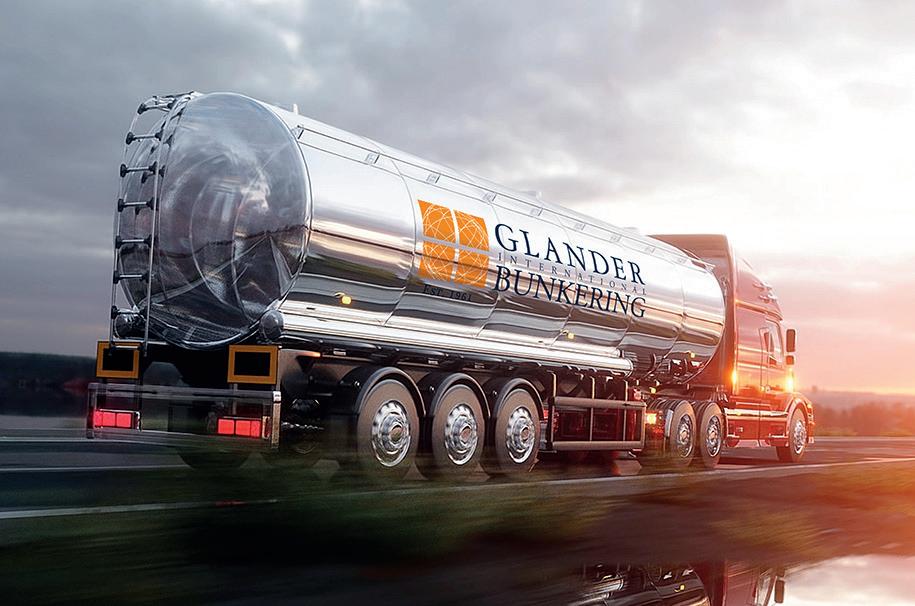
approximately 90 percent of global trade, so we see it as our responsibility to use our expertise to make it easier for our clients,” Carsten points out. “We provide tailored project solutions and contracts based on special requirements, in addition to spot sales, risk management, claims mitigation, and resolution. Our commercial and technical advisors can also provide guidance, fuel management, and post-fixture operational services.”
The shipping sector has demonstrated considerable resilience throughout the last few years, and unlike many sectors – such as aviation – escaped Covid-19 relatively unscathed. But it did pose challenges. As Carsten notes: “the ones hit worst
Exclusive Feature 38
in our industry, without a doubt, were all the brave seafarers who were forced to endure excessive tenures at sea without crew changes. It was a historic time period that defined new heroes in the world.”
Nor is the disruption over. The Russian invasion of Ukraine earlier this year has triggered a febrile political situation, causing ripple-effects for both shipping and bunkering across the continent, following the imposition of fresh sanctions and further supply chain disruption. A steep increase in the price of oil, coupled with supply premiums, have also precipitated a squeeze within bunker markets.
“We’re impacted along with everyone else,” Carsten notes. “We
have to adhere to these changes and help our customers navigate safely through these uncertain times by enabling them to move legal cargo smoothly from A to B. Fortunately, our financial results continue to be strong, so we are well positioned to weather any potential economic storms and rough seas ahead.”
Turning to the long term, Glander International Bunkering’s sights are firmly set on a completely different challenge: decarbonization. While emissions within the sector have grown since 2008, the carbon intensity of shipping has nevertheless shown a marked improvement in recent years, due in part to the introduction of more modern vehicles. A reduction of emissions by at least

“ “
Our organization is working closely with various partners enabling us to supply LNG, biofuels, and carbon certificates
“ “ energy-oil-gas.com 39 Glander International Bunkering
50 percent by 2050 is now the target for many industry players, including shipyards, engine manufacturers, and energy companies, as part of a long-term ambition of realizing commercially viable net zero maritime transportation.
In an effort to underline its own status as a reliable, ESGdriven partner, 2021 saw Glander International Bunkering extend its partnership with ECOUREA, a full-service solutions provider to businesses wishing to preserve the environment and maintain sustainability emission compliance. Under the terms of the new agreement, Glander International Bunkering will provide shipping companies with a complete emissions control package, from the system design to the supply of Marine Urea (AUS40) – a product that neutralizes marine fuel NOx, reducing emission levels by up to 98 percent.
“Apart from offering Urea as a NOx reduction agent, we are assisting customers from all over the world with other innovative solutions,” Carsten comments. “Our organization is working closely with various partners enabling us to supply LNG, biofuels, and carbon certificates. Naturally, we are also looking into the more long-term fuels such as ammonia and methanol, and we strive to be able to provide these as and when the market is ready, and the framework is in place.”

The company has also acted to cement its own credentials as a responsible business. “We want to contribute positively to local societies, not only where our business operations are represented – but also in other countries that need our
support,” Carsten insists. “As a result, we’ve been involved in numerous CSR projects over the years, several of them on a long-term basis. We’ve also taken measures to reduce our carbon footprint in our offices and operations, and we’ve implemented one of the most advanced and comprehensive compliance systems and procedures known in our industry.”
“As of August this year, we’re also granting employees worldwide a 20week paid parental leave – this applies to both mothers and fathers,” he adds. “We’ve also established a new important position in our company, the Wellbeing Manager, whose role
Exclusive Feature
“ “ “ “ 40
We offer a competitive supply of all grades of marine fuel and lubricants worldwide
is to make people the priority. This is more complex that it sounds –because it emphasizes emotional, physical and mental wellbeing. Our Wellbeing Manager is a former emergency room nurse who brings a high level of emotional intelligence to her role.
“It’s initiatives like these that help inject the concept of ESG into our corporate culture and day to day life,” Carsten notes. “Motivating our staff is an ongoing task, and we will never cease improving our efforts towards being an attractive workplace.”

Before we conclude, Carsten is keen to emphasize the importance of the employees who make up Glander
International Bunkering. “After 27 years in the shipping industry, I still feel privileged to work with so many fantastic people,” he tells us. “This is truly a fast-paced global industry where the people and the professional relations between them make up all the magic. In my view, that’s never going to change.” ■ www.gibunkering.com

energy-oil-gas.com 41 Glander International Bunkering
Enabling energy flows
Recently acquired by bulk liquid specialist, Rubis Terminal, TEPSA is now targeting a new era of efficient logistics solutions
Bulk liquid storage company, TEPSA, began its operation in 1964 in Barcelona, working from the 7200-cubic-meter terminal on the port’s old Contradique Quay. From there, operations accelerated. The year 1966 saw the inauguration of the first Valencia terminal, located on the Turia Quay, also with a capacity of 7200 cubic meters. The 7500-cubic-meter Santurce terminal, situated in the northern city of Bilbao, followed in 1968.
Throughout the ensuing decades, TEPSA has continued working to become a strategic ally for its clients, through effective, flexible, and highquality service. To-date, the company
boasts more than 900,000 cubic meters dedicated to petroleum products, chemicals, biofuels, and foodstuffs, spread across four terminals, located in the main ports on the Iberian Peninsula, following the addition of its Tarragona terminal in 1986.
But TEPSA isn’t done making history. One of the most significant milestones in more than half a century of the company’s operation arrived in the fourth quarter of 2020, upon TEPSA’s acquisition by Rubis Terminal Infra SAS (Rubis Terminal), a specialist in the storage and handling of bulk liquids and gases, such as chemicals, fertilizers, biofuels, and fuels that are fundamental to the economy.
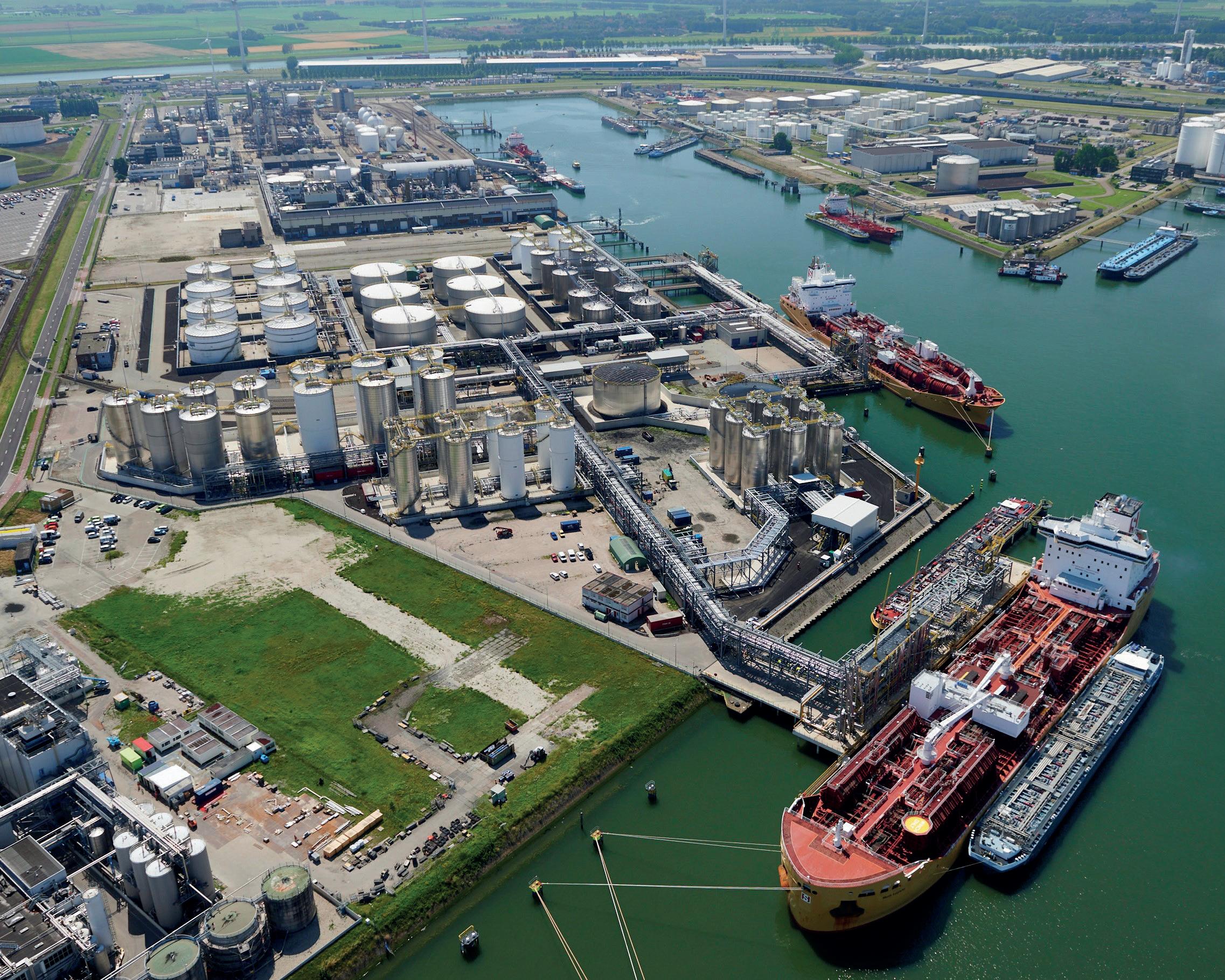
42
Exclusive feature

energy-oil-gas.com 43 TEPSA
Headquartered in Paris, France, Rubis Terminal is jointly owned and controlled by Rubis SCA and Cube Storage Europe HoldCo Ltd, managed by I Squared Capital.
As Nuria Blasco, Managing Director at TEPSA explains, the acquisition makes Rubis Terminal a stronger, more diversified group. “From the first day, it’s been evident that the two companies shared a similar culture, and a willingness to improve and grow together,” she says. “It’s a move that allows Rubis Terminal to take advantage of a growing Spanish biofuel market, thanks in large part to ample feedstock availability, mainly due to an oversupply of animal fats.
“This creates an opportunity for liquid storage providers with the operational knowhow and expertise,” Nuria notes. “We are the clear biofuel leader in Spain, thanks to locations close to key producing areas and
refineries, multimodal connections, and vertical integration, with the ability to handle raw feedstocks arriving by vessel, send them to production plants and receive them back for storage and onward distribution to the end customer.”
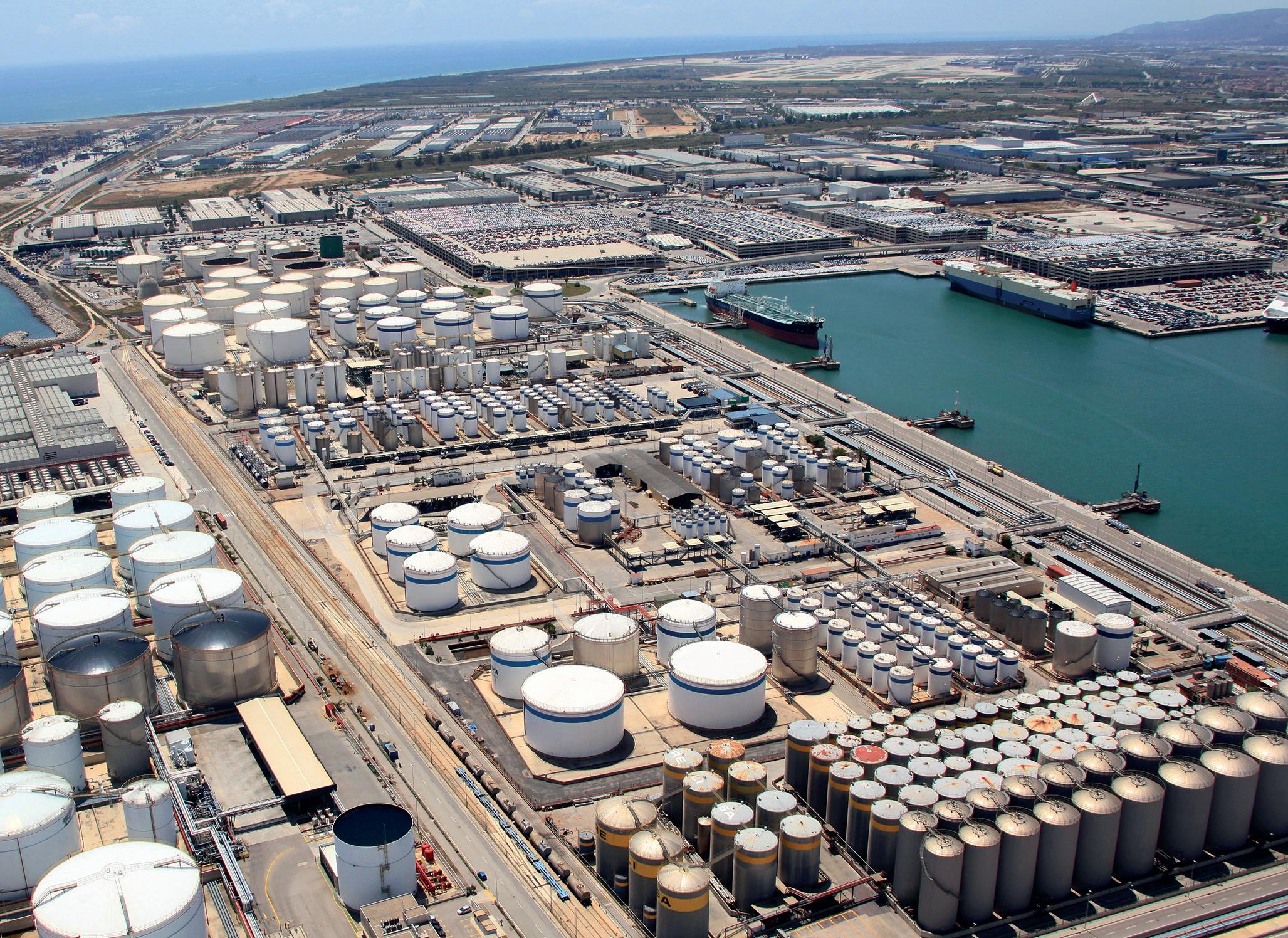
Sustainable storage
Bolstered by the addition of TEPSA’s four sites within Spain, Rubis Terminal boasts a footprint that spans continental Europe. The company operates a total of nine terminals in France, where it is the leading independent liquid bulk storage operator. Further terminals in Antwerp and Rotterdam in the Netherlands placed the company at the heart of northwestern Europe’s product trading hub.
“Our Antwerp and Rotterdam terminals were built according to the latest construction standards to limit environmental impact,
44
Exclusive feature
including best-in-class Net Zero direct emission facilities,” Nuria notes. “The conversion of our Rotterdam terminal from fossil-fuel to biodiesel illustrates the flexibility of our assets: we are emptying, cleaning the tanks, and modifying the connections to safely receive and store biodiesel – a shift that is also taking place at terminals in Spain. Moreover, with storage in our Netherlands facilities comprised entirely of chemicals and biofuels, we have ensured that our terminals are ready for the future of liquid bulk storage.”
A core value for both TEPSA and Rubis Terminal’s shared vision is a commitment to connecting industries with people through safe storage solutions. “When I look back over the past five years, I realize we have implemented innumerable small initiatives in terms of sustainability and CSR,” Nuria reflects. “We’ve increased energy efficiency with LED lighting; installed more efficient pumps and better insulation in tanks; introduced biofeedstock storage to help our clients make the green transition; promoted gender equality and employee welfare, and actively supported charitable initiatives. Some actions were small, some were extremely substantial, but none
was inconsequential. In terms of CSR and sustainability, every grain of sand, every action, no matter how small, is important.
“Today’s market is changing, and we are adapting again, contributing to the sustainability transition as an enabler of new energy flows,” she goes on. “Rubis Terminal has more than 200 contracts throughout its portfolio. Each one of these serves as an essential link in the logistics chains of fuel and biofuel companies, chemical groups, agricultural cooperatives, refiners, distributors, and traders, by storing local and imported products. We also provide services such as blending, additivation, and markering, and ensure a bulk transport connection as close as possible to the product’s destination.”
As Nuria is keen to emphasize, all industries have a role to play in the energy transition, and the storage of bulk liquid products is no exception. An uptick in demand for sustainable fuels and chemicals worldwide is contributing to significant market growth, resulting in an increasing need for storage.
“A global consensus is also emerging regarding the key role to be played by hydrogen in the energy transition, with
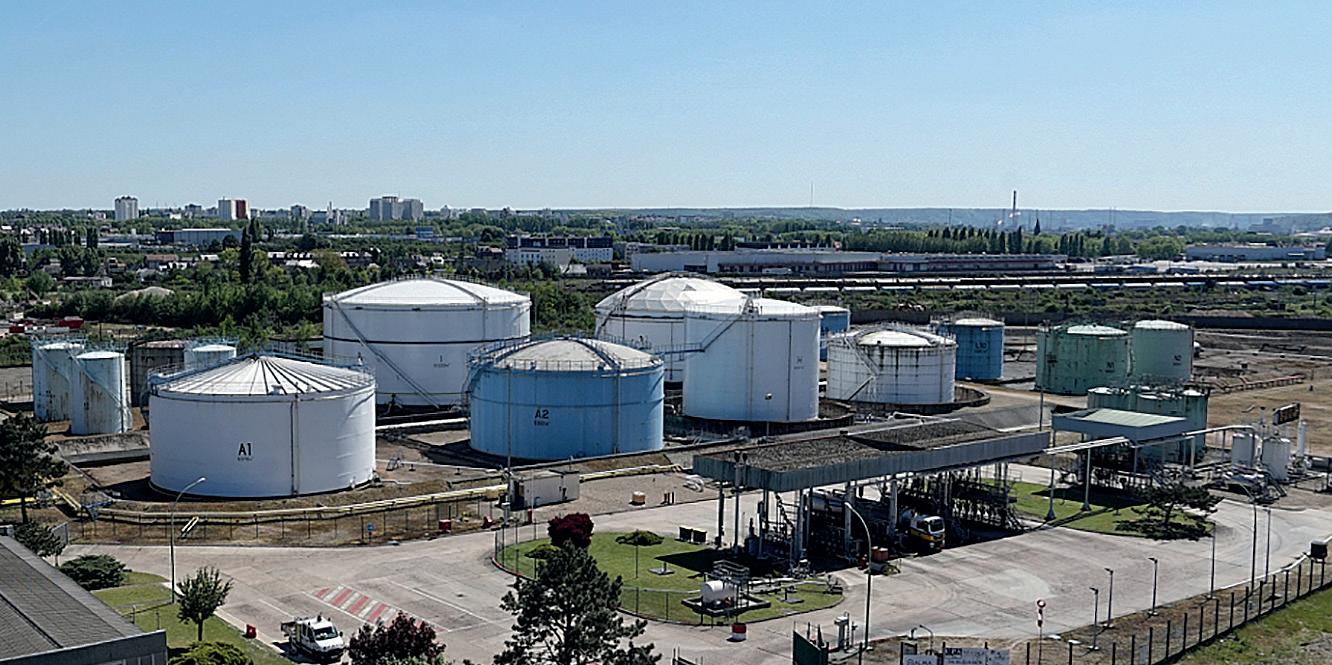
energy-oil-gas.com 45 TEPSA
prototypes now under development,” Nuria points out. “Supply chains need to be prepared to meet exponential demand growth once these technologies scale up. Rubis Terminal is already participating in the strengthening of the French hydrogen ecosystem, as part of the Elemanta H2 project framework, developed by Sofresid, which aims to accelerate the energy transition in maritime and river transport, in particular in the port of Rouen.”
People, planet, profit
As it continues to work towards the energy transition, Rubis Terminal has set out its Triple Bottom Line Roadmap under three headings: People, Planet, Profit. “Our success depends on the skill and dedication of our people,” Nuria insists. “We have strong ethical, social, and environmental values, and we empower the women and men who work in our company to uphold and promote them. Our corporate culture emphasizes diversity, innovation, and efficiency, and we invest in the growth of our teams through training. In an industry
historically dominated by men, we are committed to achieving greater genderbalance in the workplace. Today, 25 percent of members of our General Management Committee are women, and we have a goal to increase this percentage in the near future.
“At the same time, ‘Planet’ signals our commitment to the use of natural resources, and to protect, in a broader manner, the environment in which we work,” she elaborates. “The diversification of Rubis Terminal’s product mix towards non-fuel products has led to an increase in the energy consumption of our terminals since chemicals require more heating during storage than traditional fuels. Our objective is now to optimize our energy consumption, thereby reducing our environmental impact, all while meeting the changing needs of our clients. For example, we’re already utilizing steam produced in chemicals handling to heat up tanks and office buildings at our Rotterdam terminal.”
In 2021, TEPSA Barcelona increased its by train transit by an impressive 50 percent. It’s an indication of the company’s alignment

46
Exclusive feature
with the vision of Rubis Terminal, and TEPSA’s commitment to becoming more efficient and sustainable in its logistics, a growing concern among clients.

“We have set ambitious decarbonization objectives for 2025 and 2030, and we’re refining our trajectory with a thorough review of our assets and operations to reach our sustainability goals,” Nuria adds. “We’re currently developing projects and strategies aligned with our decarbonization trajectory that will have an impact across all scopes, including investments in pipe heating system controls, land use, and knowledge sharing between our Rotterdam and Antwerp Zero Emissions terminals. We’re also set to further diversify our product mix, and engaging our stakeholders where possible in the development of
aim to operate at a sustainable level of profitability to ensure we continue to invest in innovation, decarbonize our activities and contribute to the transition to net zero while upholding the highest standards of safety and efficiency. While providing a vital link in the value chains for energy, chemicals, and agri-food, we work to ensure prosperity for all our stakeholders.
“Looking ahead to next year, huge uncertainty remains,” Nuria concludes. “There is a potential for recession on the horizon; our challenge is to help our clients as best we can by remaining flexible. While we have historically supported the storage, shipping, and transportation of fossil fuel products to end consumers, we have successfully diversified our product mix and reduced the share of fossil fuels, which
TEPSA
Uncapped potential
Why the fast-growing Capstone Infrastructure Corporation is looking west to expand its renewable energy portfolio
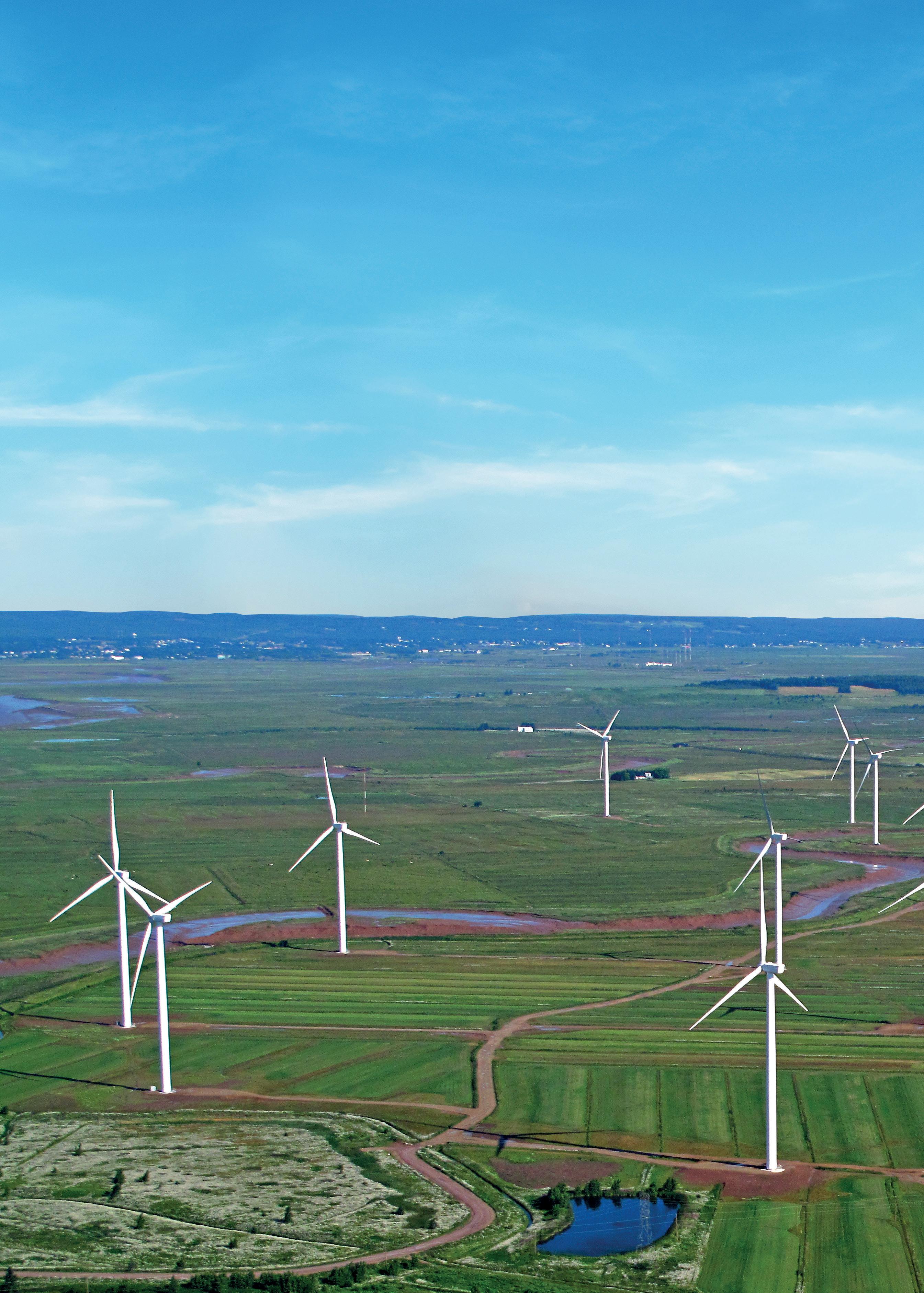
48
It has been a momentous year for Capstone Infrastructure Corporation (Capstone) since we last spoke with CEO David Eva in 2021. Founded in 2004, the Canadian developer, owner, and operator of clean and renewable energy facilities has made short work of investing in and operating clean power businesses, such as wind, solar, hydro, biomass, and natural gas co-generation power plants. Subsequently, Capstone has become a reputable name in
the Canadian energy industry, pioneering the drive for greener energy usage.
During our last discussion, we covered the development of the 132 MWac Claresholm Solar Project – as of 2021, Canada’s largest solar facility – which achieved commercial operation and is successfully producing clean power. “Just over half of Claresholm’s generation capacity is contracted by TC Energy, but certainly, the plant has been running well in a period of robust merchant

construction-today.com 49
Capstone Infrastructure Corporation
pricing in Alberta,” David reveals. He highlights how the company has also secured purchase agreements with Keyera Corporation, Pembina Pipeline Corporation, and the City of Edmonton, which is the largest direct procurement of renewables by a Canadian municipality to date. The purchase agreements allowed Capstone to accelerate the development of over 300 MW of new wind and solar projects in Alberta,
with the Michichi, Kneehill, and Buffalo Atlee projects already in construction, and the 192 MW Wild Rose 2 wind farm following closely behind.
“Alberta is known as the birthplace of wind energy in Canada,” David says. “The province supports the only open electricity market in the country, providing opportunity for corporations to reduce their carbon footprints by purchasing emissions-
 Above: Claresholm Solar Project, Alberta
Above: Claresholm Solar Project, Alberta
50
free electricity and carbon offsets directly from renewable power producers. Further, by taking advantage of Alberta’s world-class wind and solar resources and capturing those resources with modern wind turbines and solar PV modules, we are able to provide our customers with exceptionally competitive and reliable solutions to achieve their decarbonization goals,” he notes, adding that the area continues to be a significant market for the company.

Building from its success in Canada, Capstone is now entering the US market, exploring more opportunities in California, which is looking to be just as promising. “When we began this journey, we saw great potential in Alberta, but we have seen similarities regarding market demand and growth in California, where there is an exceptional amount of support for renewable energy. Another advantage is the stability of
Capstone Infrastructure Corporation
Astroenergy
The Astronergy panels supplied for this Claresholm Solar Project is ASTRO Series; a reinforced bifacial module with double glass. Enhanced with excellent encapsulation structure and strengthened frame, this type is specially designed for severe hail (45mm, 30.7m/s), and unfriendly environments with high reliability requirements. The module has passed severe damp and heat 2000 hours, thermal cycle 600 and PID 300 tests, which were verified and approved by CSA certificate-C450 and PVEL certificate-PQP.
Astronergy is proud of the delivery of ASTRO series PV panels for Claresholm Solar Project, and has a very good cooperation experience with Capstone Infrastructure. The quality policy of Astronergy is to create a world-famous brand and to provide lasting, quality products and solutions for customers.
To find out more visit www.astro-energy.com/en
construction-today.com 51
 The Skyway 8 Wind Farm is a 9.48 megawatt (MW) wind energy project near Southgate, Ontario
The Skyway 8 Wind Farm is a 9.48 megawatt (MW) wind energy project near Southgate, Ontario
I am pleased to share that despite the obstacles of the last two years, the demand for renewable energy continues to grow and Capstone continues to deliver in a challenging environment 52
“ “ “ “
the regulatory regime in the state, which will help further encourage a dynamic market.”
To this end, Capstone recently announced a new joint venture with Eurowind Energy, a Danish renewable energy company, to advance several of the projects in its California development pipeline.

“Several years ago, we also added energy storage projects to our development efforts, which is where we see the next major opportunity in our business. With the extensive growth of wind and solar, and the long-term need to further decarbonize our power grid, as an industry, we must address the need to have power available when customers need it – and do so with non-emitting sources. For example, energy storage allows us to capture excess energy when wind is blowing and the sun is shining, and then re-inject that electricity into the grid when it’s required. That is a big part of
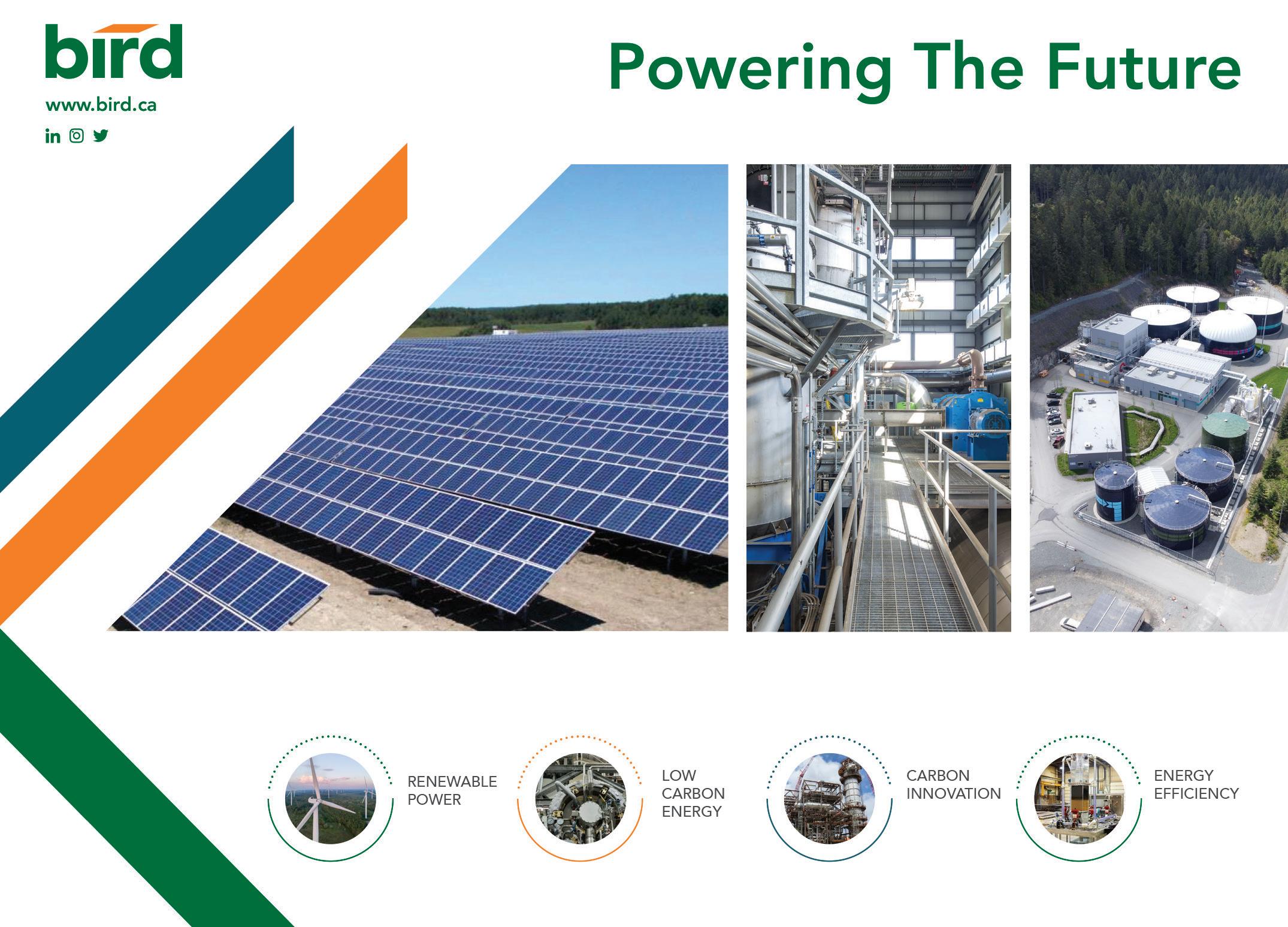
Capstone Infrastructure Corporation
BIrd Construction Your partner for a sustainable future
As one of Canada’s leading construction companies, with operations coast-to-coast, Bird Construction (Bird) provides a comprehensive range of construction services to all of Canada’s major markets.
Bird’s collaborative culture and innovative, solutions-focused approach, helps our clients meet their sustainability goals. Drawing from our 100-year history and multi-disciplinary expertise, Bird delivers deep carbon retrofits and sustainable building construction, as well as self-perform services for renewable power, low-carbon energy, carbon innovation, energy efficiency and small modular reactors.
There’s a roll for all of us to play in decarbonization, let Bird be your partner of choice
construction-today.com 53
our strategy in California, and we are starting to take some of the successes we are seeing there and apply them in places like Alberta and Ontario.”
With more than 110 MW of construction projects underway, and 192 MW Wild Rose 2 project planned for 2023, Capstone stands in good stead to achieve its goal of a total installed capacity of 1 GW. “We are very pleased with the level of progress we’re making, and I am particularly proud of our team for making this possible,” David adds.
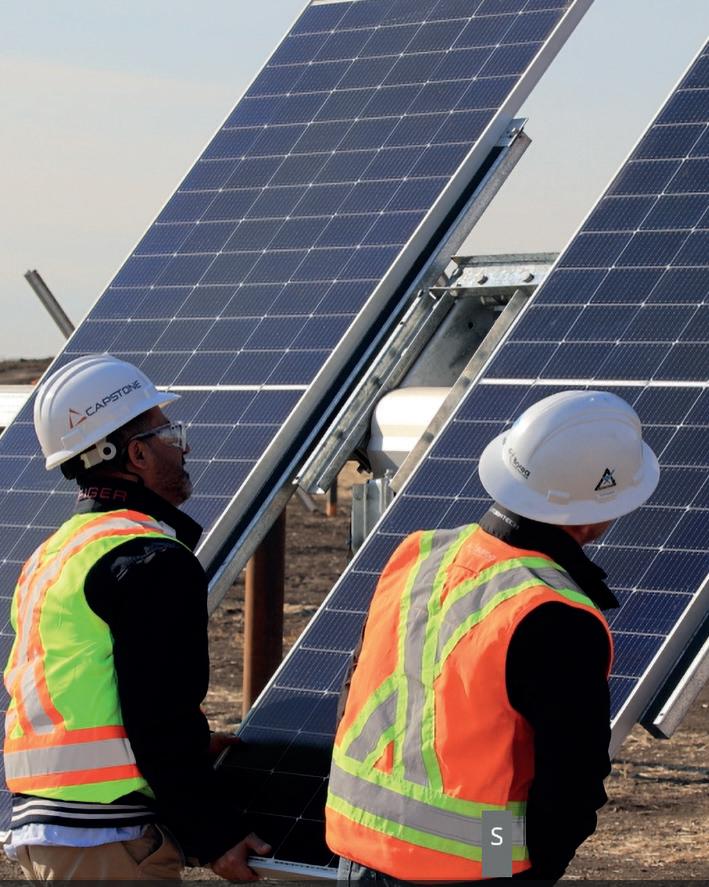

“Alongside Alberta and California, we are also very active in Ontario with multiple energy storage development projects in the province currently underway,” David notes. “What we are seeing is a big push towards capacity projects that are either dispatchable, have generation, or have storage potential. In addition, over the next five years, we expect to expand into several additional markets in North America.”
Being able to make impressive ground so quickly has not been
Above and left: First panels installed at the Michichi Solar Project, Alberta
54
an easy journey. However, considering the challenges inflicted by the pandemic, David is proud of the efforts the business has implemented to remain a leader in the energy industry. “We have been in this sector for a long time, and our projects can take years to complete. Fortunately, in some instances, they can move quicker than anticipated, and I am pleased to share that despite the obstacles of the last two years, the demand for renewable energy continues to grow and Capstone continues to deliver in a challenging environment.”
Taking this strategy forward, David highlights that the near future will be focused on the completion of current projects, as well as continuing to drive forward development efforts, with a focus on looking after supplier relationships. “There is an urgency for businesses to establish themselves as leaders in their sectors, and demonstrate they can overcome the challenges within the industry as best as possible. This is why it is crucial for
Capstone to maintain strong supplier relationships, and invest time in developing our networks to ensure that our quality is not neglected. This will ultimately be our strategy over the next five years as we strive to become a multi-gigawatt North American player in renewable energy, and energy storage.”
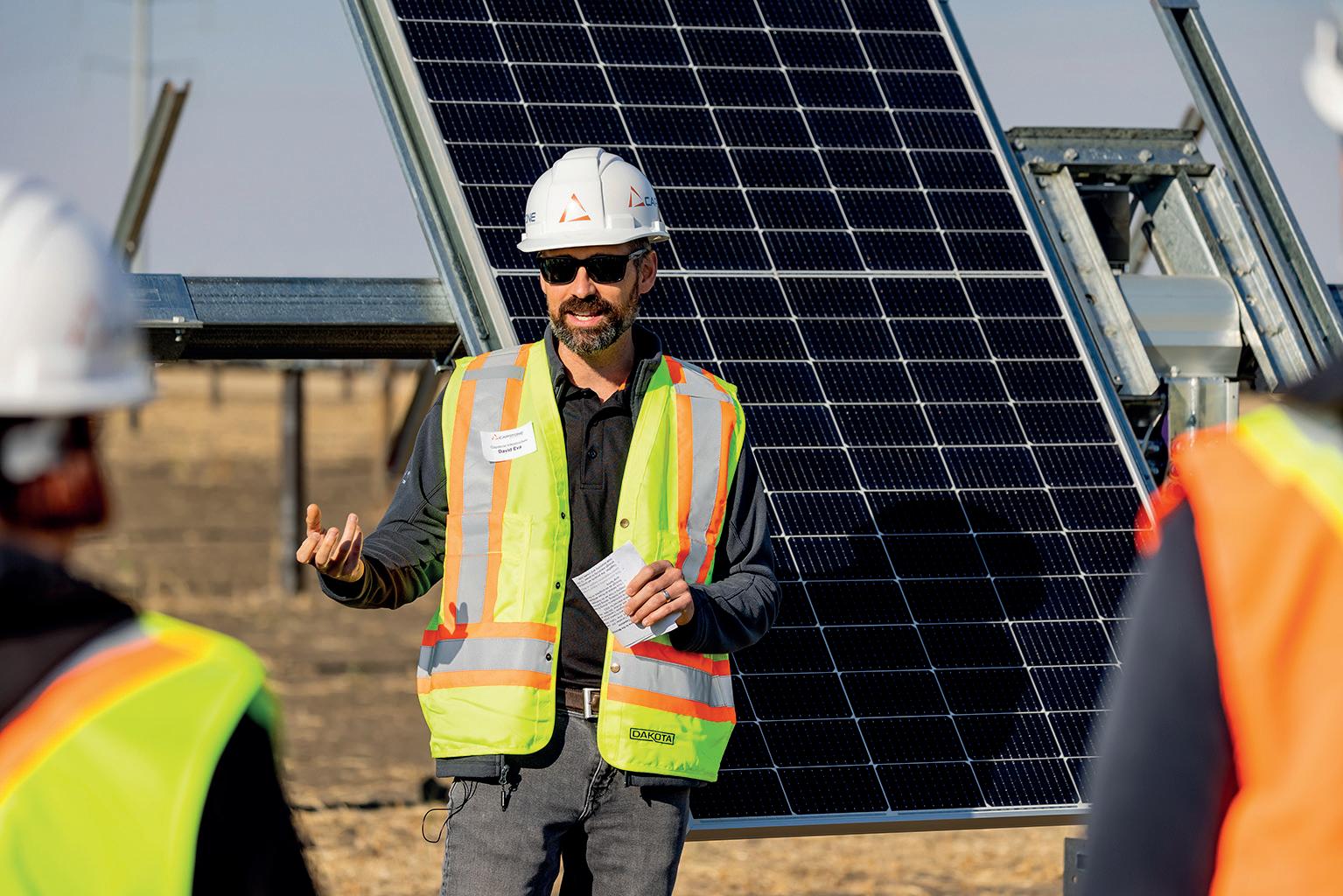
Beyond these plans, David is excited about the development of renewable energy and storage in markets that the business deems to be attractive, and is determined to maintain the business’ high level of innovation to meet the demands of its customers. “Whether this is through speed of execution, specific products on renewables, or continuing to conduct ourselves to the highest standards, we know that the years ahead will be even more prosperous than the ones before,” he concludes. “I am so proud to be part of this journey.” ■
www.capstoneinfrastructure.com
Above: CEO David Eva addresses stakeholders at the Michichi Solar Project, Alberta
Capstone Infrastructure Corporation construction-today.com 55
A transformed company
Have you met Calumet? Find out about one of the world’s leading specialty products manufacturers as it shifts its focus towards sustainable solutions

56

Calumet energy-oil-gas.com 57
In June, we featured renewable diesel producer Montana Renewables, the sustainably focused segment of the Calumet family. In this issue of Energy, Oil & Gas, we turn our attention to Calumet’s broader business, exploring its history, increasing emphasis on sustainability, and rapidly growing host of capabilities.
While many of its businesses are more than 100 years old, Calumet in its current form was founded in 1990 with the purchase of a Princeton, Louisiana-based naphthenic lubes facility. Since then, the company has transformed into a well-refined and profitable powerhouse within the specialty products business niche. Growth inevitably means progress, and with Calumet it is no different. The company has ventured out into new terrain over the last three decades, blazing trails in areas that naturally supplement its existing footprint.

This business has been built one customer, one product, and one asset at a time
“ “
58
“ “
Now one of the most highly integrated specialty products players in the industry, that growth mindset has undoubtedly paid dividends. Headquartered in Indianapolis, Indiana, Calumet operates in over 90 countries from ten integrated production and formulation facilities across the US and a host of distribution points. The company is split into three distinct segments: specialty products and solutions; performance brands; and, as mentioned previously, Montana Renewables, where Calumet is currently focused on converting a large part of its Great Falls facility into an innovative, renewable feedstock processing plant.
Across its businesses, Calumet finds solutions to sustain and enhance life’s essential products – from the tires on your car to the balm on your lips – and delivers them to medical and pharmaceutical, industrial, personal care, transportation, energy and
Innospec
Innospec is at the forefront of Renewable Diesel (RD) fuel additive technology supporting partners, like Calumet, working side-by-side on their Montana Renewables project. Innospec is the leading RD additive provider with over half of all RD currently being produced domestically treated with Innospec additives. Our product line is designed to meet our customers’ lubricity, conductivity, and cold temperature operability requirements for RD and RD / Biodiesel blends. We help ensure fuels leave the refinery on specification, and continue to benefit downstream customers that choose low-emission sustainable fuels. Contact our team today to find out how we can help you.
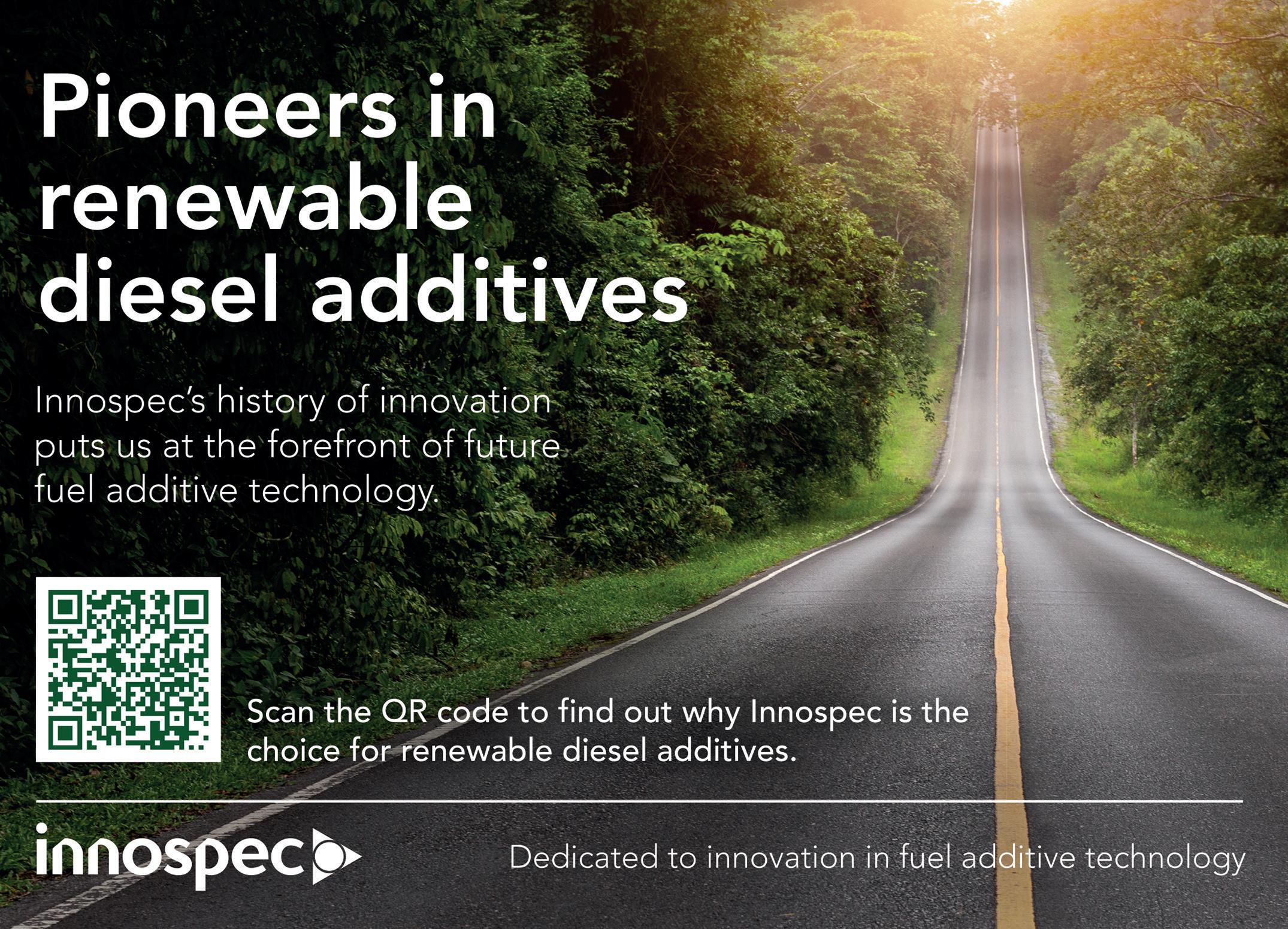
energy-oil-gas.com 59 Calumet

60
chemical, food and agriculture, and home and electronics markets.
Products include base oils, food grade white oils, solvents, esters, waxes, petrolatum, fuels, asphalts, finished lubricants, greases, horticultural spray oils, renewables, and gels. Base ingredients such as these find their way into familiar household items like ointments, baby oil, lubricants, paints, and candles. Calumet also owns high-end retail and industrial brands such as Royal Purple, TruFuel, Bel-Ray, and Orchex.
Offering us an insight into the behind-thescenes operations and progressive ethos of Calumet is company CEO, Todd Borgmann. “This business has been built one customer, one product, and one asset at a time,” says Todd. “We are building partnerships that can evolve to meet current business needs. This mindset allows us to serve our customers differently and, as a result, we have cultivated

Baker Hughes
Baker Hughes is the downstream market share leader in North America for hydrocarbon treatment. Its extensive experience and technical knowledge of the refining industry has been key to ensuring success for Calumet. Baker Hughes’ personnel acts as an extension of its customers’ engineering teams to maximize asset reliability and profitability.
Recently, Calumet and Baker Hughes expanded their relationship to include the chemical treatment and services at the new Montana Renewables Diesel Unit to ensure a successful startup and operation.
Baker Hughes’ BIOQUEST™ product line includes new technology and services specifically designed for the unique challenges of renewable diesel processing. Baker Hughes’ leading position in the renewables market enables it to provide this growing industry segment with forefront solutions.
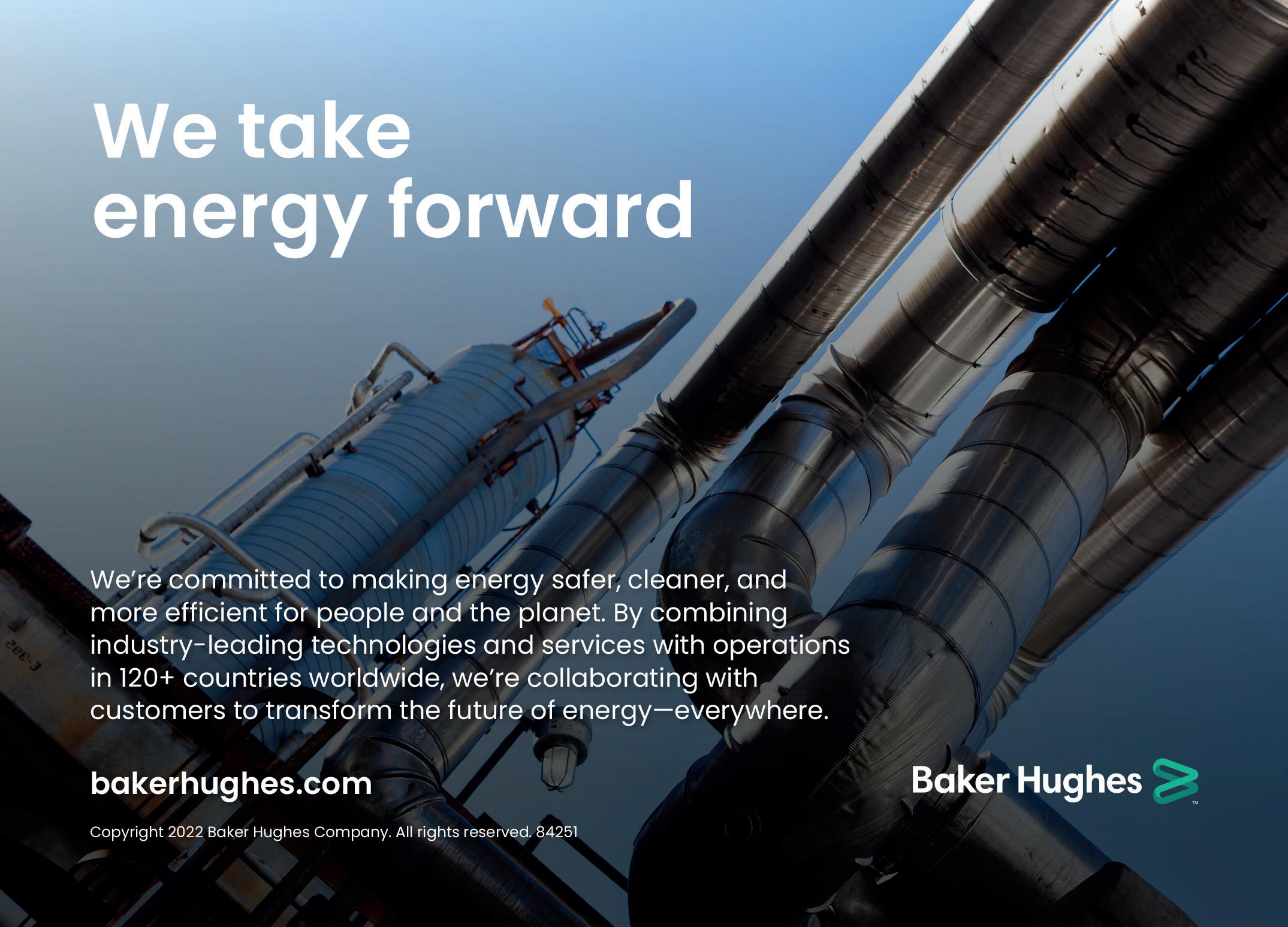
energy-oil-gas.com 61 Calumet
a deeply integrated business and a rich culture of innovation – both of which are core competitive advantages for Calumet.
“To give you an overview of the asset base, our four facilities in northwest Louisiana operate as one cohesive specialty unit,” he continues. “Here, we have tight distillation capabilities, and a broad array of hydro-treating, dewaxing, and blending competencies. Next, we have six upgrading and distribution

facilities where we can upgrade base stocks into complex food grade and pharmaceutical products or create finished branded products that serve retail channels through our highperformance lines. With our diverse, integrated asset base, we simply can do things others cannot.”
For those who value innovation and operational optimization, Calumet offers a seemingly endless number of opportunities. The Indianabased company is committed to deploying unique solutions to clients’ problems, and that has not gone unnoticed. As Todd goes on to explain, the company has built a strong reputation and separates itself from competitors by identifying and addressing these needs.
“
We provide more than 1800 products to more than 2500 customers around the world
“
62
“ “
“We provide more than 1800 products to more than 2500 customers around the world,” Todd details. “With each client, we apply our innovative spirit. We also look at our ability to serve evolving demands. The pivot at Montana Renewables you wrote about previously is a great example of Calumet’s ability to move quickly to fill a need. In two short years, our team has transformed our Great Falls asset and positioned us as a leader in producing Renewable Diesel (RD) and Sustainable Aviation Fuel (SAF), two of the highest growth markets in energy.
“We can innovate at scale, and in times like we’re seeing today where customers’ needs are evolving quickly, Calumet can shine.” reveals Todd. “We’re also seeing interest in sustainable specialty options, and we are very excited to further deploy our growing expertise in sustainable markets across Calumet’s specialty offering.
TANCO
Since TANCO’s beginning in 1979, we have exceeded customer expectations through our commitment to safety, reliability, and excellence. In our 40-plus years of business, we’ve continuously excelled in health and safety performance, work quality, environmental stewardship, and customer service. We specialize in above-ground storage tank construction and repairs, and want to come alongside you to help you accomplish more with less stress and keep your tanks in service. We have worked closely with Calumet for many years, and have consistently performed at the highest level at multiple Calumet locations across the country. The services we provide Calumet range from tank design and engineering services to tank maintenance and repair, and turnkey new tank construction projects.
The team at TANCO values the trusted relationship it has built with Calumet, and looks forward to many more years of working together as a trusted partner in Calumet’s family of contractors.

energy-oil-gas.com 63 Calumet
“In fact, we have already begun to do so, and I am proud to share two recent examples,” he comments. “First, our highest growth product this year is BioMax. This biofriendly lubricant developed for the global shipping market performs at an incredibly high level. Also, in the near future we’ll roll out a wax product designed to meet the needs of environmentally conscious candle customers. Both of these examples demonstrate our commitment to doing things differently – for both our clients and the planet – without sacrificing the quality and performance that our customers rely on.”

For Calumet, the next six months are set to be an exciting period; the company expects to see the culmination of several years of work from both Montana Renewables and its specialty business. “Currently, at Montana Renewables, we are in a commissioning phase, and we’ll be running within weeks,” says Todd. “And our specialty business is performing as well as I can remember.

“ “
64
We can innovate at scale, and in times like we’re seeing today where customers’ needs are evolving quickly, Calumet can shine
“ “
“Looking beyond that is yet more exciting,” he concludes. “In Montana we have a big opportunity to continue to expand, develop even more local feedstocks, and grow into the largest SAF producer in North America! In our specialty business we have a number of high-return projects that will further integrate our business, increase the optionality we offer our customers, and ultimately deepen the competitive advantage that Calumet has today.”

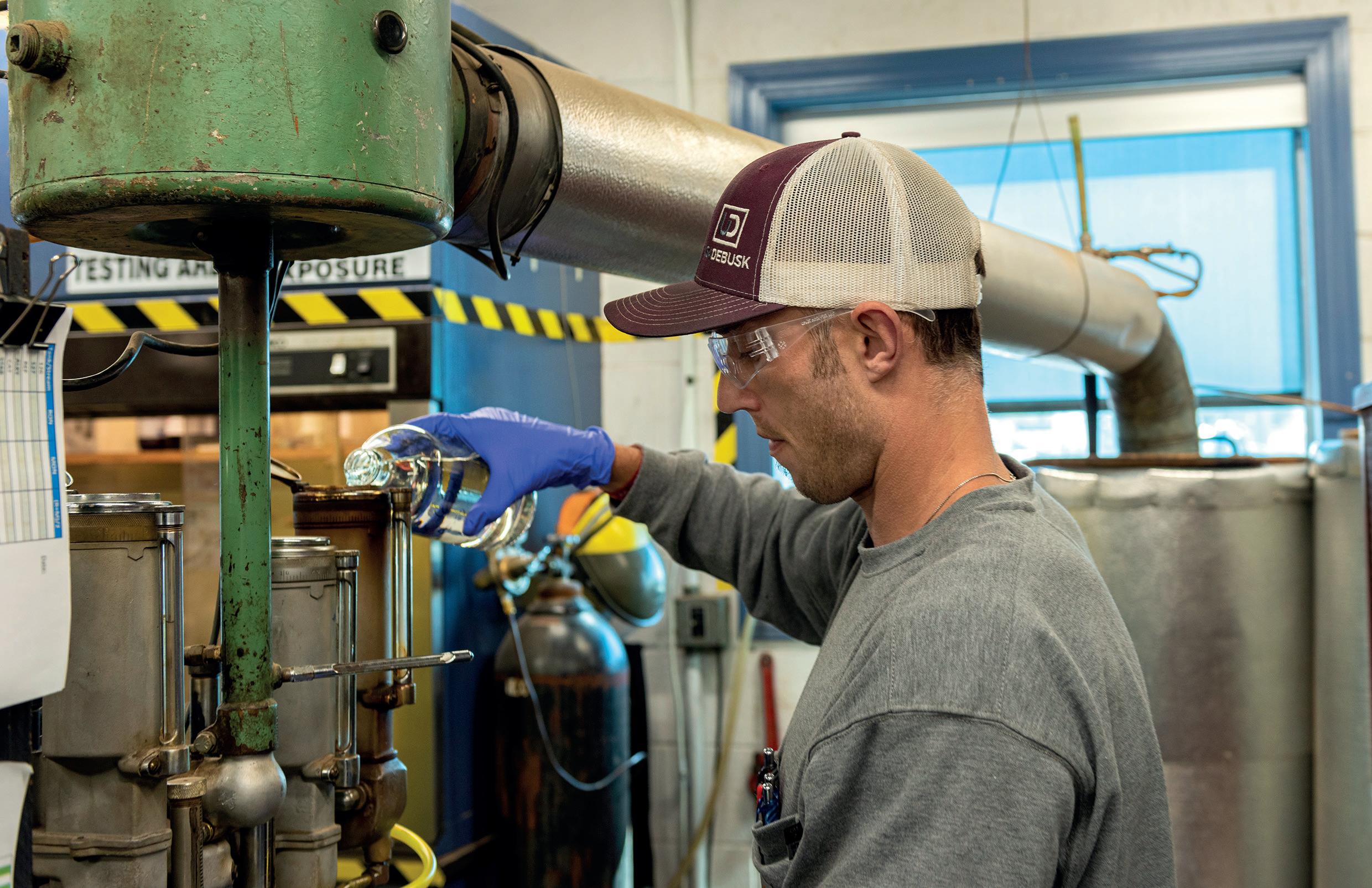

energy-oil-gas.com 65 Calumet
Decarbonization at SCALE
How Topsoe is pioneering green and blue fuel solutions

66 Cover Story
It was in 1944 that Topsoe delivered its first Topsoe VK catalyst to customers, after being founded just four years prior with a vision to tap into the potential of catalysis and apply it to industry. Since then, the company has remained steadfast in that belief, ushering in an era in which catalysis has become a central process within modern industry, utilized in 90 percent of all commercially produced chemical products. Today, Topsoe delivers a wide range of catalysts and process technologies that are essential for producing clean fuels from crude oil and waste, and increasing the efficiency of industrial processes. Headquartered in Ravnholm, north of Copenhagen, the company has offices in a number of locations globally.

Topsoe energy-oil-gas.com 67
“We’re riding the wave of decarbonization,” admits Henrik Rasmussen, Managing Director, The Americas at Topsoe, reflecting on what has been a successful couple of years, which saw the company secure the vast majority of its renewable green fuels business. “We are still producing technologies and catalysts for the fossil fuel
industry, including jet fuel, gasoline fuel, and more, and we expect that to continue to be a large part of the world’s energy source for many years to come. While helping those industries to decarbonize, we’re also witnessing the growth of renewable green fuels, as we move towards a far more diverse energy mix.”

ENGlobal Corporation
Throughout our 37 years of history, ENGlobal Corporation (ENG) have developed a strong relationship with Topsoe in the energy industry. We have worked closely with Topsoe on projects that include developing the ‘inert free’ ammonia synthesis loop eliminating the need to purge inerts like argon from the system, and improving yields. Further examples include the H2BridgeTM technology, which we have incorporated in the latest 6,500 BPD renewable diesel plant recently started up in Kansas. This allows for
the replacement of external fossil feedstocks in the hydrogen unit with renewable LPG. ENG is incorporating the latest high yield SAF/RDU HydroFlexTM technology from Topsoe for two current projects in design, which also includes an optimized version of the H2Bridge. ENG appreciates the confidence Topsoe has in its organization in jointly realizing projects, applying its technology for green and blue methanol and ammonia, SMR hydrogen, and renewable diesel and SAF.

Topsoe 68

69
As Henrik indicates, the growth of green diesel represents a significant development for Topsoe. In the US, Renewable Fuel Standard 2 (RFS2) requires refineries to blend 36 billion gallons of renewable fuel into the country’s total transportation fuel consumption by 2022. Similarly, the EU’s Renewable Energy Directive (RED) requires all its member states to ensure that at least ten percent of their transport fuels come from renewable fuel sources by 2020. It’s led to many refiners revamping their production plants, using processes such as Topsoe’s HydroFlex™ solution.
“We currently have 14 renewable fuels units in operation, with another six due to come online before the end of 2022,” Henrik reveals. At the time of speaking, this was complemented by a further pipeline of 20 projects, due to begin between 2023 and 2025. “All of these will draw on feedstocks including chicken fat, cow and pork tallow, used cooking oils, soya bean oil, canola oil, distilled corn oils, and other types of vegetable oils,” he continues. “These plants are today making products ranging from 5000to-20,000 barrels a day.
“Another wave of projects we’re involved in is the gasification of biomass, such as waste wood or corn stovers,” he goes on. “That can be

We can decarbonize any industry that uses energy to heat up a process
“ “ “ “ 70 Cover Story
used to produce syngas, which in turn is used to make renewable jet fuel, renewable diesel, and renewable gasoline. We have a number of those projects also in progress, and we’re steadily inching up the plant capacity.”
As Topsoe’s own work indicates, the world is steadily embracing the potential of renewable fuels, with an ever-increasing number of projects coming online. But for Henrik, green
Catmasters LLC
isn’t the only color of interest. The company is also investing heavily in the development of so-called ‘blue’ fuels, such as blue ammonia, blue hydrogen, and blue methanol. Blue hydrogen is produced using a similar reforming process to that used to create typical hydrogen, but the carbon dioxide that would ordinarily be released is captured and stored underground.
Catmasters LLC (Catmasters) is a technology company focused on optimizing reactor performance and automating catalyst changeout processes. Catalytic reactor performance can be impacted by catalyst loading quality. Catmasters’ engineers have now developed, tested, and produced the next generation catalyst dense loading technology, called Hyperloader™.
Hyperloader™ has been extensively tested in our testing vessels in Pasadena, Tx and is fulfilling all of Topsoe’s criteria with respect to the reproducibility and loading quality. Hyperloader™ will be introduced to market in the fall of 2022, through our subsidiary company Hyperload LLC.
Email

info@Catmasters.com to find
Topsoe energy-oil-gas.com 71
out more.
“We firmly believe that blue fuels are the key to decarbonizing a number of industries, including fossil fuels and petrochemicals,” Henrik explains. “For instance, blue fuels can be used instead of methane during the process of chemical production. At Topsoe, we’ve built the technology to be able to provide this blue fuel. We’re able to produce blue hydrogen at a significant scale which involves the compression of clean carbon dioxide. The result is hydrogen that is 99.3 percent decarbonized, just 0.7 percent shy of green fuels.”

“ “
“ “
As sea levels are rising and icebergs melting, we can’t wait another ten years – we need to act now. Therefore, a transition from grey, through blue, and eventually to green, is the most effective solution
72 Cover Story
The benefit of blue, says Henrik, is scale. “We can make plants on a mega scale today that are already commercially proven,” he insists. “The implications that has for decarbonization are significant, and are in my opinion far more relevant than the fact that it’s blue, rather than green. Right now, we can decarbonize any industry that uses energy to heat up a process – such as food, petrochemicals, steel, cement, or any kind of manufacturing – using blue fuel.
“Of course, green fuels based on electrolysis are great, it works, and they will certainly materialize,” Henrik continues. “But at the moment, we don’t have the large-scale projects that really matter. As sea levels are rising and icebergs melting, we can’t wait another ten years – we need to act now. Therefore, a transition from grey, through blue, and eventually to green, is the most effective solution. In the US in particular,
Heurtey Petrochem Solutions
Heurtey Petrochem Solutions is a major supplier of steam methane reformers.
The company also provides a comprehensive range of solutions including furnaces, waste heat recovery units, emission reduction and efficiency improvement equipment, electric heaters, services such as furnace performance optimization, revamp studies, CFD modeling and revamps, as well as a supply of spare parts.
Heurtey Petrochem Solutions has a local network with a presence in all strategic markets. Its team has significant expertise in thermal and mechanical design, fabrication and modularization of equipment, and project management.

Topsoe energy-oil-gas.com 73
natural gas is in abundance, meaning it’s relatively cheap, and we have the geology to sequestrate it safely. That’s a significant competitive advantage for the country. In the meantime, we will also pursue smaller green electrolyzer projects with our Solid Oxide Electrochemical Cell technology (SOEC electrolysis), and continue to improve efficiency and further bring down the cost of green fuels.”
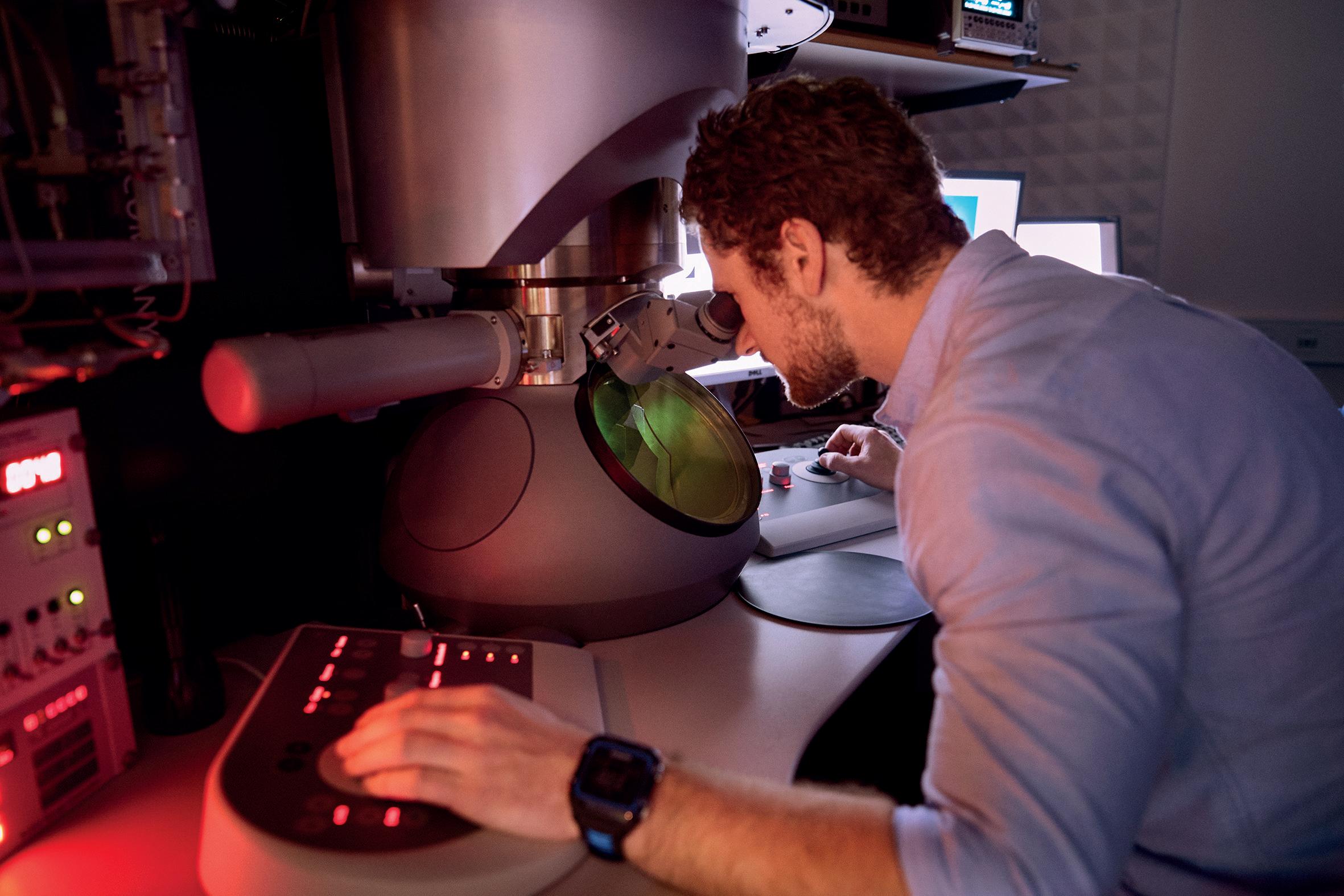
Topsoe is already capitalizing on the benefits of blue fuels, having recently signed a contract for the launch of the world’s largest ammonia plant. Based in Louisiana, it’s due to produce 4000 tons of blue ammonia per day upon completion. “Nowadays, people have more and more need for ammonia as an energy carrier, so we believe it’s a project that makes a lot of commercial sense, while drawing on hundreds of years of operating experience when it comes to making these molecules at scale.”

74 Cover Story
With projects like these, Topsoe is eyeing a bright future. Within five years, the company expects to establish itself as the leader within the field of decarbonization, thanks to its range of innovative technologies. According to Henrik, it’s an opportunity for growth, and he hopes to see Topsoe couple its continued support for oil and gas with an expansion into new and unfamiliar industries.
“Fossil fuels continue to be necessary in the world,” Henrik comments. “Today we consume about 100 million barrels of fossil oil per day. That is expected to go up to 110 million barrels over the next about five years, before slowly tapering off to about 80 million barrels in 2050.
“Nevertheless, we’re increasingly seeing new customers seek out decarbonization technology, with a growing need for our products within many manufacturing


sectors,” he concludes. “As a result, we expect to become a more diverse business, and it makes for an exciting time. Although we’re facing some huge challenges in the world today, we’re confident that we have the tools and technologies to meet these challenges in a responsible manner.” ■
www.topsoe.com
Topsoe energy-oil-gas.com 75
Grain to green
How The Andersons’ approach utilizes principles and people to develop greener services from grain

76
For a company, such as The Andersons, Inc. (The Andersons) to transform a single, family-owned grain elevator, established 75 years ago, into a publicly traded Fortune 500 company, it takes more than a well-timed product or innovation
– it takes principles. The Andersons has been deeply committed to getting the human side of trading and business right since its earliest days, an intrinsic philosophy that has been continually carried forward into the future by The Andersons’ Statement of Principles.

energy-oil-gas.com 77
The Andersons
The statement expresses the beliefs held by the founders and forms the basis for the development of The Andersons’ operating principles: ‘to recognize our concurrent responsibilities to our customers, our employees, our communities, and our shareholders.’ “We are a very people-oriented culture,” states Rod Harris, Renewables Vice President. “It’s all about our people, because without them we are nothing. The Statement of Principles was something that our original family founders created, and it still lives today. It talks a lot about our culture, our beliefs, and our accountabilities. It’s a document that everybody at The Andersons has, and we train on, and we teach, and we hold people basically accountable to that.”
Using its supply chain awareness, The Andersons has grown by building upon its knowledge base of the grain industry and continuing to grow relationships with farmers across the country. This approach has enabled it to branch the original business model from

the 1940s, centered around a grain elevator and terminal with nine truck bays, out into a wide umbrella of services and products relating to multiple sectors of the North American agricultural supply chain. “Today, the company has over 120 locations in the US and Canada as well as in the UK, Puerto Rico, Singapore, and Switzerland,” Bill Krueger, President of The Andersons’ Trade and Processing, highlights. “Our primary business has three segments: our plant nutrient, which provides fertilizer to growers, our renewables business, which is both ethanol plants and renewable diesel feedstock, and then the largest of our three segments is our trade group, which houses all our grain elevators in North America.”
Besides the plant nutrient segment, which began in the 1950s, with its initial blending taking place in a cement mixer, the renewables business has seen the greatest surge in development in recent decades. This has been accentuated by the repositioning
“
“
I will focus on the renewable feedstock business. It’s been such a growth business for The Andersons for the last two and a half years
78
of the business in 2021 for growth across the sector, under the name The Andersons Trade and Processing. The startup of the most recent plant was in late 2019 in Colwich, Kansas. Bill cites The Andersons’ foresight in providing farmers with new sales opportunities as a driving force behind the investment in its initial ethanol plants: “We very quickly, in 2006 and 2007, started to build ethanol plants that allowed our producers better destinations for their corn, and enabled us to become one of the industry leaders in the marketplace.”

The Andersons’ five ethanol plants process corn into ethanol, a renewable, low-cost, clean burning, high-octane fuel product. When commenting on the current ten percent blend of ethanol in US gasoline, Rod says: “Within our industry we have been actively working and trying to get that up to 15 percent – a cleaner burning concentration”. As well as the ethanol itself, there are numerous co-products created as a result of the production process, some of which would be wasted if not for the
innovative steps taken by The Andersons to maintain its sustainability initiative. “In addition to the ethanol products, we also produce a number of different feed products,” Rod comments. “We make both a dry and a wet distillers grain and high-level protein products, that are sold as animal feeds.” The Andersons
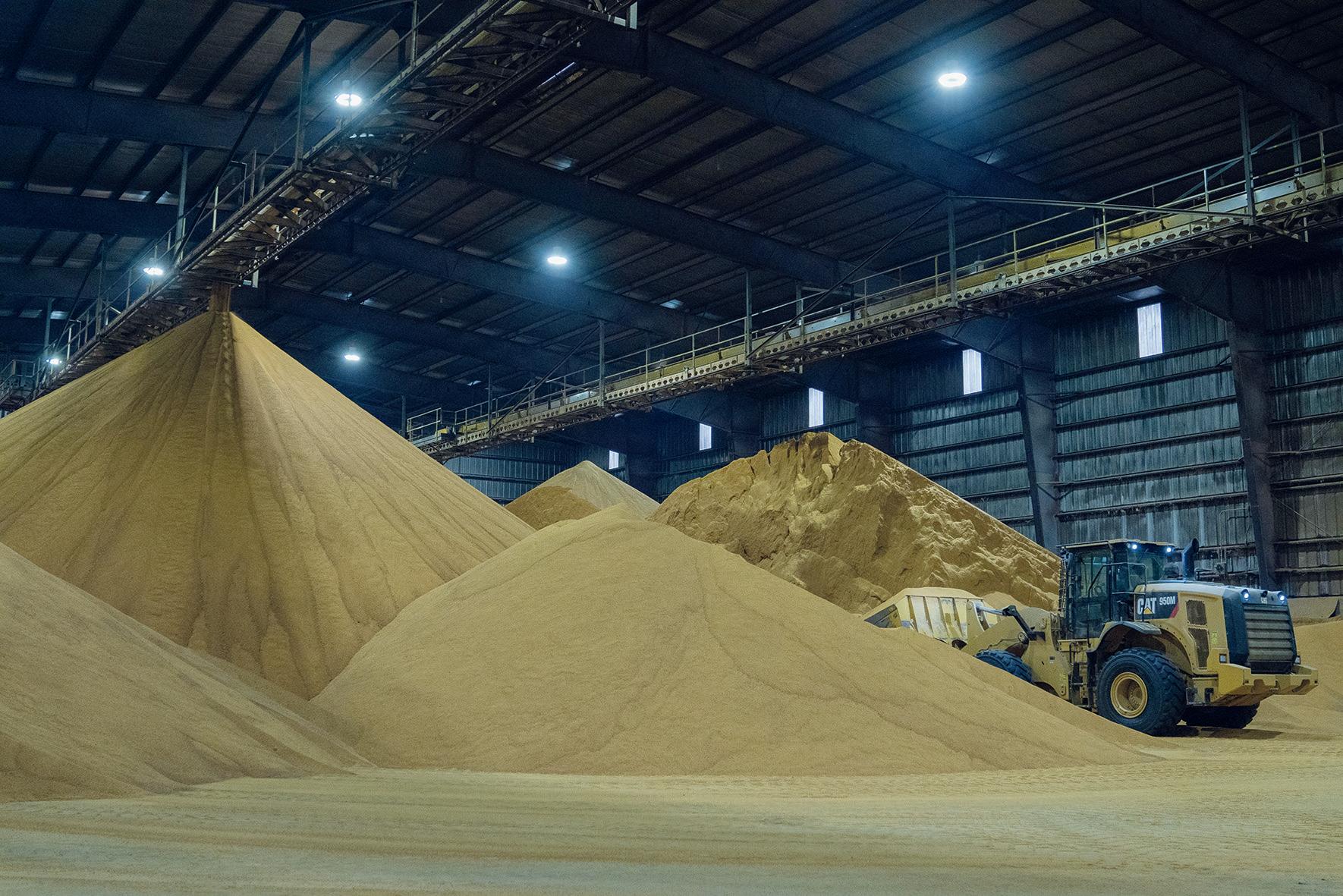

energy-oil-gas.com 79
The Andersons
also produces distillers corn oil, which is sold as an animal feed and a feedstock for renewable and biodiesel, and harnesses the pure stream of CO2 produced during the fermentation process, selling it back to the food and beverage industry through a business partner.
Perhaps the most promising result of The Andersons’ eye for optimization, in terms of a brighter future for both it and the planet, is the ground it is covering within the production of renewable diesel feedstock and related technologies. As Jacob Eberhart, Diesel


Feedstocks Vice President, explains: “The renewables growth came with the advent of RFS2 that pushed the US into an energy transition. After RFS2, the Low Carbon Fuel Standard (LCFS) in California provided an additional incentive for not only ethanol, but other platforms too, to try and decarbonize our footprint in the US.” The Andersons started trading and marketing its renewable diesel feedstock business just two and a half years ago and has already begun to revolutionize the industry with new technology.
This new development was born from a strategic partnership with Trucent Separation Technologies, LLC and enables ethanol plants to partially refine crude distillers corn oil of the unwanted metals content, which in turn allows them to send it directly onwards as feedstock for renewable diesel, without any further processing. This low investment on behalf of the supplier cuts down time and costs for the consumer. Jacob reiterates the pioneering nature of the collaboration to commercialize
80
the technology: “We are certainly an early mover in the space. We do have some competition, but we feel like we are the first ones to commercialize, and we are the first ones to push products into the industry.”
While the roots of the business continue to be firmly grounded in grain, and The Andersons still boasts some 77 grain facilities with over 36 million tons of traded product annually, the movement towards greener solutions for modern day problems appears to be where its future potential now lies. As Jacob concludes: “I will focus on the renewable feedstock business. It’s been such a growth business for The Andersons for the last two and a half years. We feel it could be a real driver for the company long term and a renewable solution for the industry.” ■

www.andersonsinc.com
CTE Global, Inc.
CTE Global, Inc. is a recognized leader in the biofuels industry for quality enzymes and yeast products. We are dedicated to helping advance the growth of low carbon fuels, and driven to evolve our products to benefit customers and communities. Through on-site process evaluations and optimized recommendations, we help maximize desired yields and extend customer relationships beyond product dropoff. We value our customers, and the results we achieve reflect collaborative partnerships and a shared desire for cleaner energy.

energy-oil-gas.com 81 The Andersons
PUMPED-UP production
Natgasoline is advocating for sustainability in the gas industry
The global methanol producer, Natgasoline LLC (Natgasoline), can be found in Beaumont, Texas. The company came about as a joint venture between Proman USA and Netherlands-based business, OCI NV. OCI NV and its partner, Consolidated Energy Limited (CEL)/G2X, each own 50 percent stakes in the company. Subsequently, Natgasoline is able to leverage both partners’ significant
technical, operational, and sales and marketing experience as leading methanol players, as well as its own existing relationships in the domestic market and around the world.
Natgasoline began operations in June 2018, and has quickly grown to become one of the most efficient methanol production facilities in the US. To date, the business produces over 1.7 million metric tons of methanol per year. As a result,
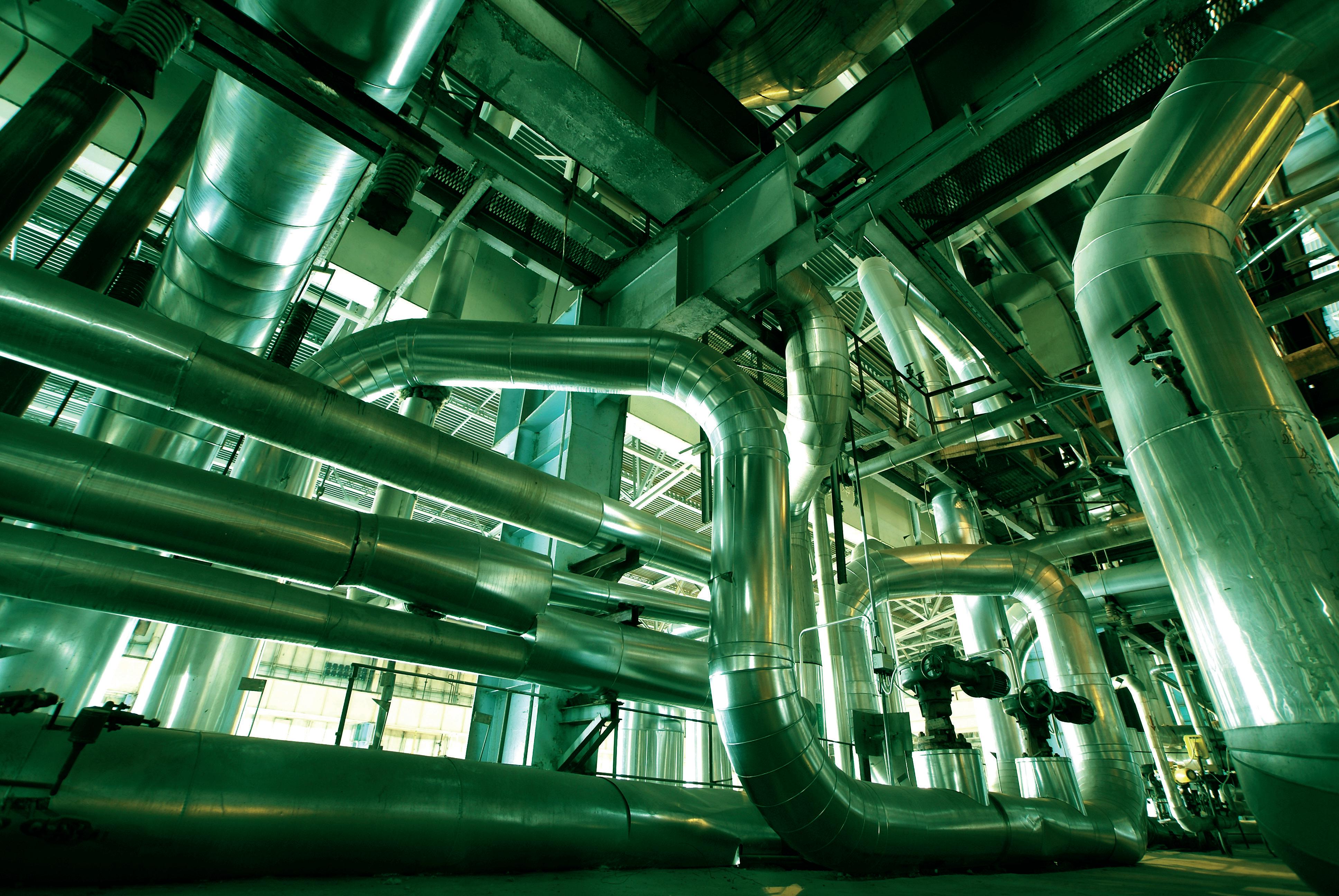
82
Natgasoline’s internal developments and operational growth are championing the wider oil and gas industry.
Natgasoline’s strategic location on the Texas Gulf Coast provides it with access to excellent distribution and logistics infrastructure. The company’s plant is located near six existing natural gas pipelines, where it receives natural gas from two lines that run through the project site, and offer the company access to several liquid trading pools for its feedstock. One of the locations provided it with the
opportunity to partner with Philips 66 (P66), a diversified energy manufacturing and logistics company with unique businesses in refining, midstream, chemicals, and marketing and specialties.
With access to the Neches River for domestic and international shipments, Natgasoline works with P66 for terminal storage and the loading of marine vessels, as well as pipeline transport to its terminal. Finally, its location near the Lower Neches Valley Authority canal system provides the company

Natgasoline LLC energy-oil-gas.com 83
with plentiful access to its other feedstock – raw water. These contributing factors have enabled the business to excel within the gas industry.
Before we dive into the inner workings of the company’s operation, a quick introduction to its specialism, methanol, is in order. Also known as
methyl alcohol, methanol is a colourless liquid, and the starting point to produce a multitude of everyday products such as clothing, automotive parts, paints or building materials. In addition to these wide-ranging applications, the use of methanol as a clean fuel is becoming more common, which is where Natgasoline comes in.

At Natgasoline, methanol is made from natural gas and water. These elements are combined, heated and passed over a catalyst to produce a mixture called synthesis gas. Using an additional catalyst, the synthesis gas reacts to become methanol, which is finally distilled to make the pure product.
Turning now to the pillars that form the foundation of the company’s success. As part of a wider global network, Natgasoline’s achievements are thanks to its clear vision,

Echo Group
Echo Group is a proud service provider for Natgasoline and has been since its operations began. Echo Group is a single source industrial contractor providing Capital, Maintenance and Turnaround services throughout the Gulf Coast. It has supported the Petrochemical industry since 1976 and employs approximately 2000 people with over 200,000 sq. ft. of shop space, and its fabrication facilities operate 24 hours a day, 7 days a week. Visit its website at EchoGroup.net to learn more about its products and services.
Natgasoline LLC 84

maintained values, and its people. The business’ dedicated team of employees are the best in their fields, and the leadership group aims to provide its people with the best environment in which to work.

One of the areas in which the company’s values can be seen is through its commitment to the community. Natgasoline is dedicated to seeking employees and vendors within the Beaumont and Golden Triangle regional area. Additionally, it has developed relationships with Lamar University, Lamar Institute of Technology and Lamar State College to create internship programs to grow the strengths and expertise of new employees. The organization also gives back to the community through blood drives, holiday toy drives, donating school supplies, and the participation in numerous charitable events.
Furthermore, Natgasoline is committed to the health, safety and welfare of its employees, visitors and the surrounding communities. This commitment is achieved through a

86
zero-accident operation and a documented health, safety and environmental system, which ensures leadership accountability for any potential risks. Additionally, authority for anyone to stop unsafe acts is communicated and promoted. This measure is instigated through thorough training of employees, which enables them to meet their responsibility of working safely and protecting the environment, and encourages proactive hazard and risk recognition and mitigation.
The company’s primary focus as a methanol producer remains safety and the environment. As is the case with all fuels and chemicals, methanol must be produced, handled, stored and transported safely. Accordingly, Natgasoline follows all applicable engineering, regulatory and industry practices to ensure that its facility is operated in a safe and environmentally sound manner to produce methanol. It utilizes and adheres to the OSHA Process Safety Management Standards, EPA’s Risk Management Planning regulations and a multitude of other state and federal environmental programs to ensure that its product is managed safely, and with minimum impacts to the environment.
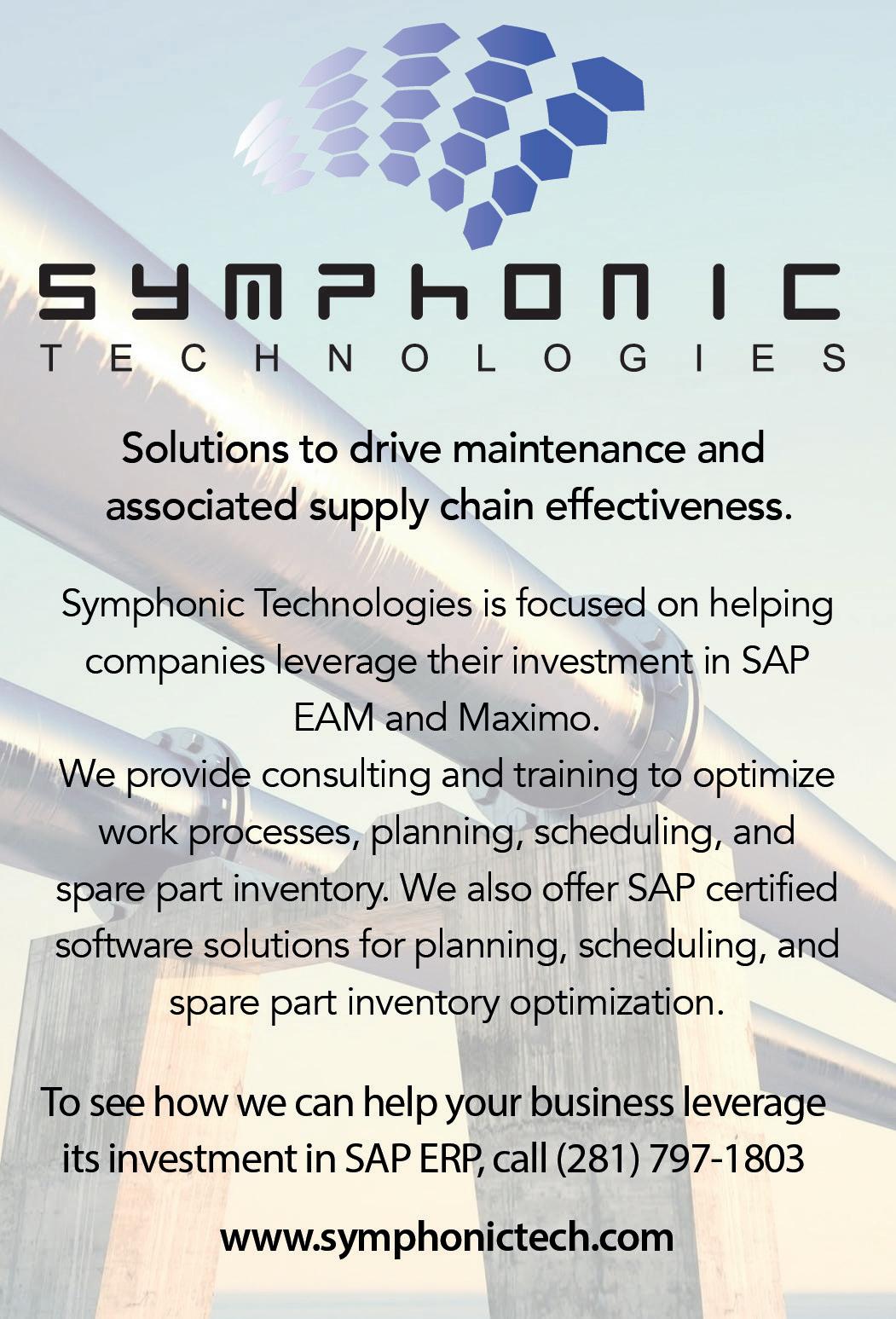
Technology also plays a pivotal role in championing the company’s sustainability efforts. Natgasoline believes that the selection of safe and environmentally responsible technologies is inherent for a greener future within the industry. The Natgasoline methanol process technology uses cleanburning natural gas as both a fuel and a feedstock. Natural gas CO2 emissions can be 50 to 60 percent less than other coal-derived feedstocks and fuels. During normal plant operations, Natgasoline employs process gas recovery systems that enable it to utilize these recovered streams as supplemental fuel in its fired-equipment, and to re-process the gases into methanol.
The process technology employed at Natgasoline also incorporates excess steam using an efficient waste heat recovery
system. This allows greater efficiency and reduces the amount of fired-sources needed to produce heat in various phases of the process. A large volume of condensed process steam is also cleaned and conditioned as a supplemental make-up water feed for the plant’s process water, thereby reducing water use.
With COP27 currently underway, we are reminded that the global push for greener energy methods is crucial to the longevity of our planet, and it is encouraging to see a company like Natgasoline pioneer the gas industry. We look forward to seeing how its efforts inspire other businesses in the gas sector to adopt measures that look after the environment, while continuing to power the man-made world. ■
www.natgasoline.com
Natgasoline LLC energy-oil-gas.com 87
Leading the greentransition
Since 2005, Energinet has successfully led the way in expanding Denmark’s sustainable energy infrastructure

Driven by a desire to create a 100-percent green energy future, Energinet owns, operates, and expands sustainable energy infrastructures all across Denmark. Maintaining its position as one of Europe’s leading contributors toward a climateneutral supply of gas and electricity, the company focuses on security of supply, sustainability, and open access for all users.
“For over 18 years, Energinet has been a state-owned sustainable energy operator. Based in Denmark, we are part of a movement to develop energy policies, in order to support decarbonization and more renewable energy production. We work closely with the government in order to follow through on projects and policies quicker than a privately held company.
88
“Energinet is primarily an Electricity and Gas Transmission System Operator (TSO), but it also owns and operates gas storage units. We also have a huge digital IT infrastructure in place, which means we support advanced market design; and can guarantee the origin of all our electricity, gas, and hydrogen. As a broad infrastructure operator, our latest assignment was to prepare two energy islands, in the North and Baltic seas, for the
accelerated development of offshore wind. This is in-keeping with our green strategy. Over two thirds of our current electricity output is sustainably produced, as well as 30 percent of our gas. We are currently in the process of negotiating several regional, bilateral, and European projects in order to increase these figures,” begins Torben Brabo, Senior Vice President at Energinet.

Energinet energy-oil-gas.com 89
The engine behind Energinet’s success has always been a strong belief in the necessity and power of sustainable energy alternatives. As Torben explains: “Following the liberalization of electricity and gas, there was a political discussion surrounding how the TSO should operate. We have a very market-orientated and green parliament in Denmark, which makes us global front-runners when it comes to sustainable and effective energy systems.
“When the company was established, the parliament made the decision that we should be independent, which meant that the government took us out of the previous commercial owner and prepared us as an independent entity with
an independent supervisory board. As a result, we can now create energy infrastructure for the sake of society, not for profit. We drive analysis on social and economic welfare in order to decide on projects of strategic development, in accordance with our findings; this process is now similar to the EU-regulatory scenario and network planning.
“Our sophisticated, data-driven processes mean we are global front-runners in a range of sectors. We offer open seminars on a variety of different development topics, which we prepare and carry out in close collaboration with the energy sector stakeholders. Maintaining this level of transparency with stakeholders and other influential figures within the business is one of the reasons for our success.”

Energinet’s work has helped make Denmark a global leader of the green transition. “In Denmark, the renewable electricity sector is fully integrated with the renewable transition and has been for decades. It’s about more than wind and sun energy, as we want to look at, and make use of,
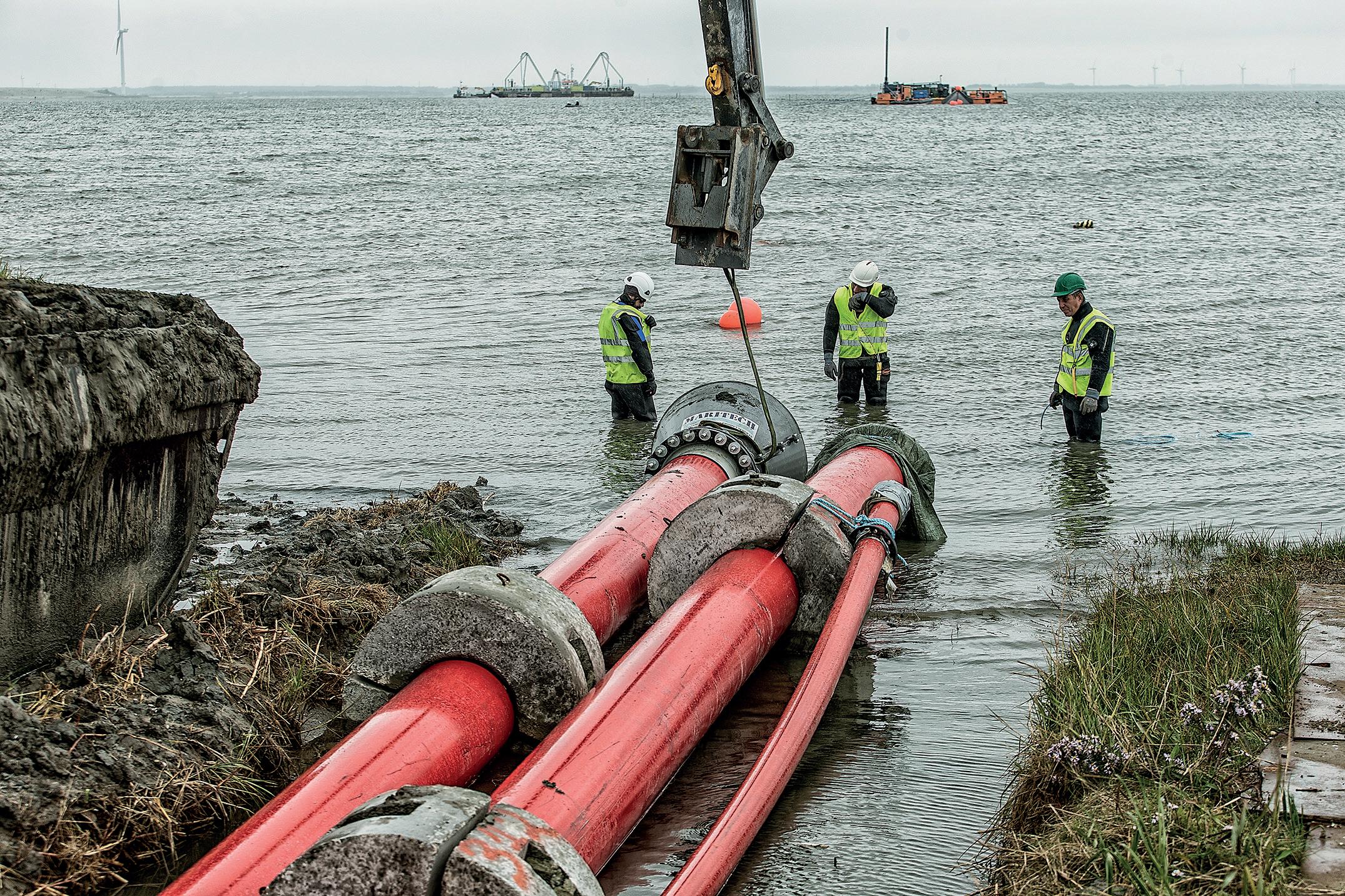
90
all different kinds of sustainable production. As of today, we are around two thirds renewable, and by 2030 that number will be up to 100 percent. We are very high on electrification, heat pumps, electric cars, and demand side response schemes; we also have a very advanced digital IT system, to manage the increase in volatile renewable electricity production we expect to see over the next ten years. Additionally, we will soon be delivering renewable electricity to many our neighbors, through our many interconnecting cables – the newest connect us to the Netherlands and UK.
“The gas sector operates a little bit differently. We are seeing a decline in fossil fuel and natural gas use, which means new infrastructure is needed to accommodate alternative gas production. Denmark started on biomethane production about ten years ago, and it’s now at 30 percent, meaning we can be 100 percent green by 2035 with biogas alone. However, this year we finalize the big Baltic Pipe project which carries Norwegian gas for Poland, Ukraine, and other Central and Eastern European countries (CEE). A key project for European gas supply security and for CEE decarbonization, as gas substitutes coal.
“Interestingly, we started doing detailed joint gas and electricity analysis about six years ago, with the expectation that these energy systems would be key drivers in the future of energy production. Using that analysis, we discovered that hydrogen would also be an important component of that integrated system. In fact, we now predict that by 2030, hydrogen will make up several gigawatts of electrolysis (PtX) and e-fuel production in Denmark,” Torben discusses.
Today, the company looks to expand its portfolio, in order to make effective use of all avenues for carbon-neutral energy production, including hydrogen and CO2 storage. As Torben details: “It’s all about assessing the scenarios and building the right infrastructure. We are already doing this successfully for renewable energy production in Denmark, we are tripling,

even quadrupling our electricity production in these areas. Alongside big, centrally constructed infrastructures we are also seeing a revolution in terms of de-centralized energy sources, including more solar panels and wind farms; connected to smaller PtX installations and hydrogen networks.
“It’s a balance between increasing largescale infrastructure and managing exponential growth in terms of smaller-scale energy systems and local energy production. Until now we have been successful mainly in terms of large-scale infrastructures, and now we have a double objective for managing a smooth coalition between these systems and smaller pockets of production. Finding a way of optimizing all those energy sources will be important for the future of Energinet,” he concludes. ■
www.energinet.dk
Energinet energy-oil-gas.com 91
MAXIMIZING POTENTIAL
Bouncing back: Motive Offshore’s remarkable journey to becoming an international energy and offshore supplier
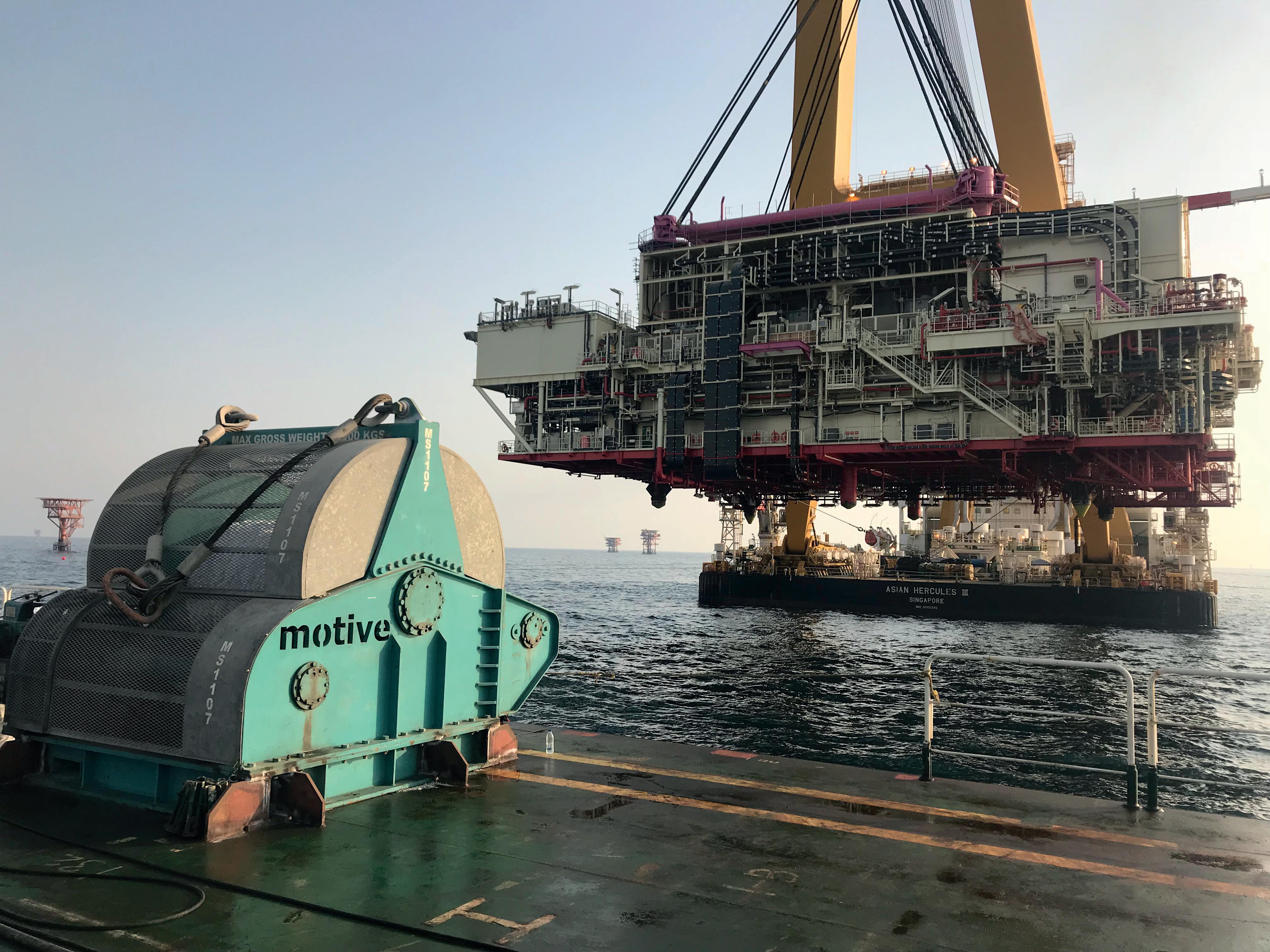
92
It’s been over 12 years since Dave Acton and James Gregg founded Motive Offshore (Motive) in June of 2010. A specialist supplier and manufacturer of rental equipment for the energy and offshore industries, the company achieved ISO9001 accreditation in 2011, before securing work from EPC contractors working across the North Sea and UK Continental Shelf, including the likes of TechnipFMC and Ocean Engineering. In 2012, the relocation of its headquarters brought the company to the old 30-acre RAF base of Boyndie Drome, where it remains to this day. A further base, in Stavanger, Norway, followed in 2013, before a downturn in the oil and gas market, coinciding with the campaign for Scottish Independence, brought about a declining pipeline of work. Having established an annual turnover of £5 million, and an employee base of approximately 100 individuals, the company found itself scaling back, reducing its headcount by half.

“It was a difficult time,” admits Dave, now CEO of Motive, when speaking to Energy, Oil & Gas “However, we were able to learn a lot of lessons, and come out of it bigger and stronger.” After initially focusing on the UK oil and gas sector following its rebuild, the company broadened its horizons in 2016, setting up a base in the Middle East. “That was our starting point, and it’s gone from strength to strength,” Dave continues. “In November of that year, we then took the decision to begin manufacturing equipment for rental, and to explore new service offerings, taking on private equity to do so. We achieved our goal of

energy-oil-gas.com 93 Motive Offshore
▲ Dave Acton, CEO
entering Taiwan in 2020.”
As of 2022, Motive has delivered projects in over 50 countries worldwide across sectors including oil and gas, telecoms, decommissioning, and more. Underpinning the company’s growth are a number of driving factors, one of which is acquisition, beginning with the purchase of Norway-based Pumptech AS in late 2018. “The acquisition brought us Norwegian management, in a company that had synergies with our services, along with those that fell outside our remit,” Dave explains. “In particular, they had a track record when it came to cables, which really provided a platform for us to move into offshore wind.”
Specialists. Established in 2001, Flowline Specialists designed, engineered, and manufactured its own equipment, supplying experienced technicians and support services for the handling and deployment of flexible pipes, umbilicals, and cables to the offshore energy market. It was an acquisition that allowed Motive to further implement its strategic vision of market diversification into offshore wind, power, and utilities, via the introduction of complementary products, services, and expertise to existing and prospective clients alike.
“At the time of the purchase, we were Flowline’s biggest client,” Dave recalls. “We already knew the team and their equipment very well,

94 Motive Offshore
“ “ “ “
We need to limit and reverse the effects of global warming, and to do that the world needs to reduce its carbon footprint
Clamping Solutions


Tube Connectors

Flanges
Adaptors
Tube
Hose Connectors
Hose
Quick Release Couplings
Valves
Test Components
Diagtronics
Filtration
Hydraulic Accessories

energy-oil-gas.com 95 www.stauff.co.uk STAUFF Scotland, Badentoy Avenue, Badentoy Industrial Estate, Portlethen, Aberdeen AB12 4YB Tel: 01224 786166 Email: uk.absales@stauffscotland.co.uk
quality manufactured individual hydraulic components, to the full service STAUFF Line concept ... and everything in
From
between.
and as such, it was a purchase that made sense – taking them out of the market, and bolstering our own rental fleet of equipment. It also allowed us to boost our head count by about 50, and it gave us an extra £7 million in turnover. Flowline Specialists also had a significant presence in the UAE, which was its biggest revenue generator. Because the same was true for Motive, it made sense to join those two ventures together.”

Beyond its equipment rentals, Motive Offshore offers in-house design, manufacturing, and fabrication services for a wide range of bespoke and standard equipment, including winches, spoolers, tensioners, and associated cable and flexible conduit handling equipment, along with a repair, maintenance, and overhaul service. It’s all part of Motive Offshore’s ambition to maximize its clients’ operational, commercial, and environmental performance.
“We’re very self-sufficient, carrying everything from design and procurement through to testing it, all on site,” Dave reveals. “We don’t rely on subcontractors except where it’s absolutely

96
essential, giving us full control over the process. Within our manufacturing department, we have a dedicated R&D team whose main focus is currently to incorporate new technology into our processes, such as augmented reality. With that, we could have onshore staff wearing 3D headsets, giving them the ability to operate offshore equipment remotely. That’s still in development, but we’re talking to our clients and hope to commercialize a version of that soon enough. Some of our clients are already testing our smart equipment on their projects, and through that we’ll be able to gather more performance data.
“Technology is set to be a big part of the future,” he adds. “When the business started off, it was very much hands-on and mechanical. However, as we’ve grown, and given the way the world is changing, we’re seeing more and more innovations being brought in all the time.”
It’s no secret that the energy sector is currently undergoing one of the most significant transformations in living memory. As the world seeks to allay growing fears around rising global temperatures, countries across the globe are pivoting towards renewables. For Motive, it’s a similar story. “As we were going through our journey towards becoming a more resilient business, we decided that sticking purely to oil
and gas wasn’t a good thing,” Dave says. “The world was going green, so we took the decision to transition into the offshore, and we set targets for that transition. In 2021, we hit our target of 40 percent non-oil-and-gas revenue, on a turnover of approximately £32 million. We began this year with the intention of increasing that to 60 percent, but global energy security concerns have shifted the focus back to oil and gas.
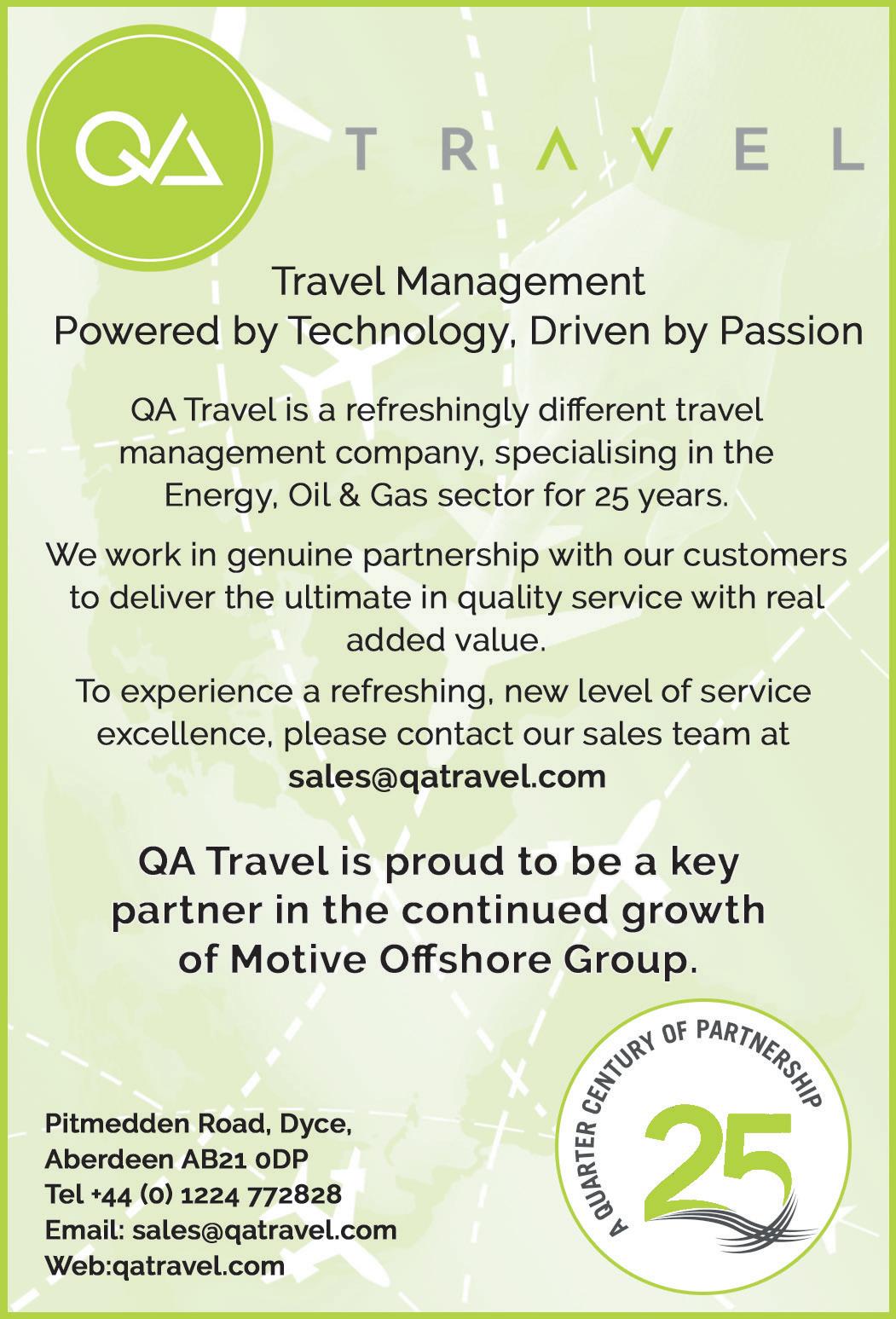
“We recently did a project in Germany for one client that involved synchronizing 20 winches to all work in tandem, as part of an offshore wind farm installation,” he notes. “The actual function of these winches was to lower an air curtain to the seabed to prevent the harmonics from the tiling causing detrimental effects to any marine life.”
Despite this, Dave emphasizes the continued importance of oil and gas. “We need to limit and reverse the effects of global warming, and to do that the world needs to reduce its carbon footprint,” Dave insists.
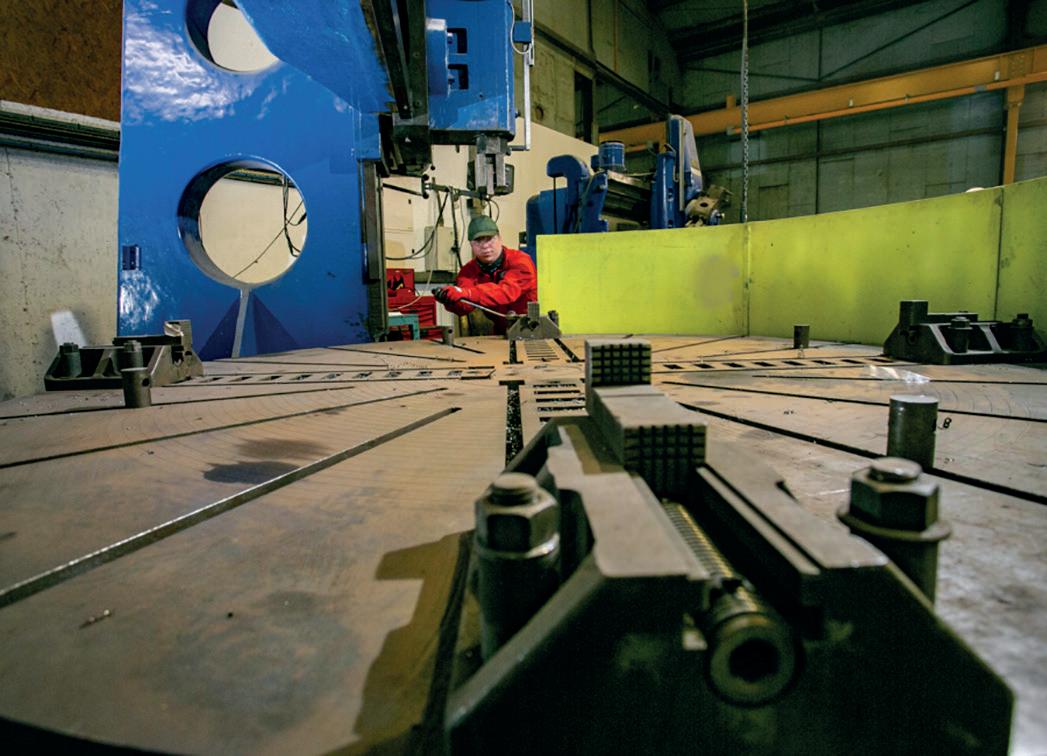
energy-oil-gas.com 97 Motive Offshore
“At the same time, we need to take a sustainable approach to how we achieve that. Without fossil fuels, we wouldn’t currently have the ability to develop new renewable technologies that harness wind, wave, sun, and other forms of renewable energy. It’s about achieving balance within the context of the transition.”
In 2021, Motive Offshore celebrated the official opening of a dedicated renewables hub located in Taipei, Taiwan, with an operational base near Taichung Port. The group’s first facility in the Far East, it signals Motive’s support for the region’s burgeoning offshore wind market, and allows the company to build on its significant presence within the region, while simultaneously creating jobs to support the local economy.

Since entering the market in 2018, Motive has played an instrumental role in the development and commissioning of every landmark offshore
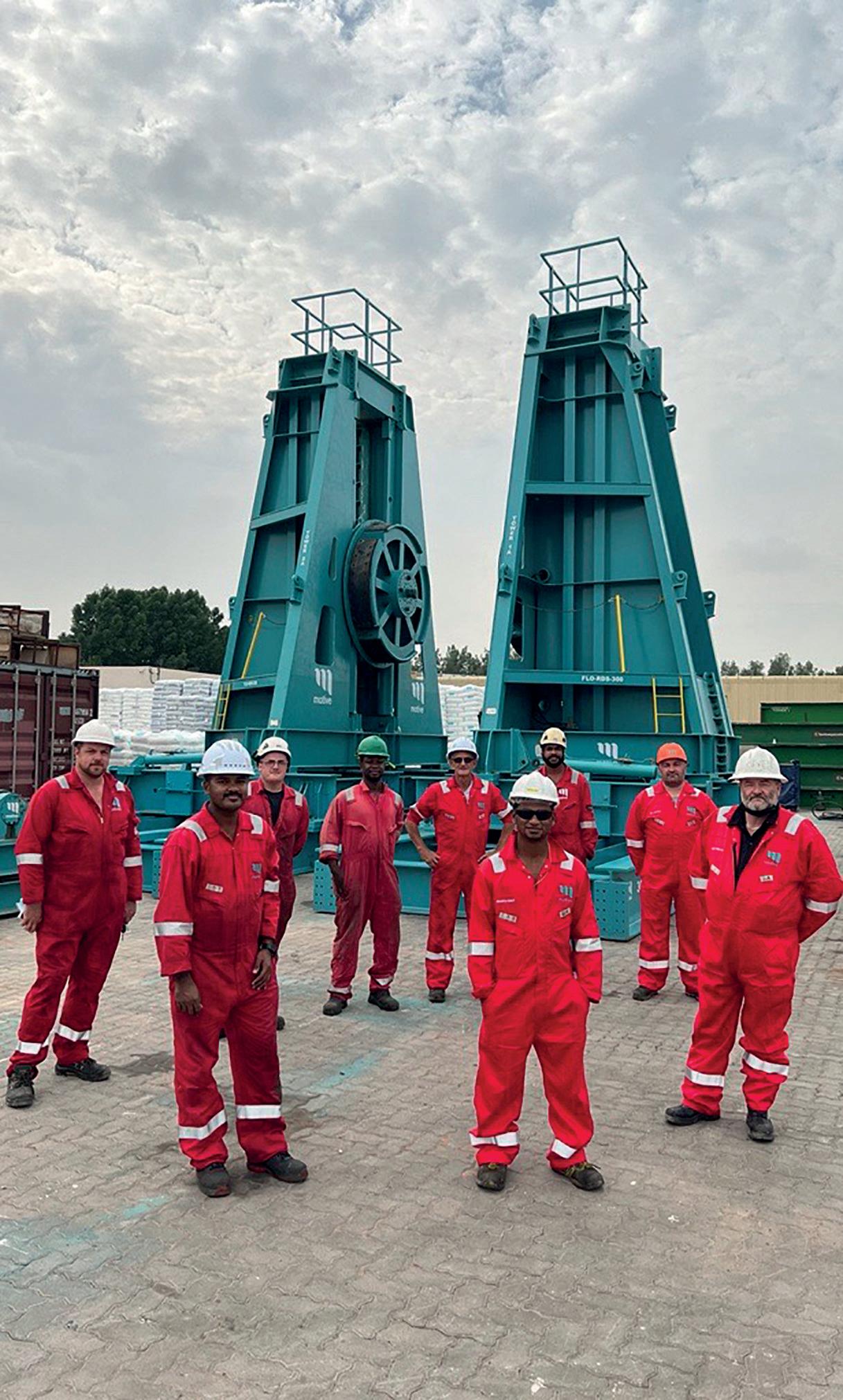
wind project in Taiwan to date, deploying multi-sector solutions to support the local supply chain.
“Taiwan is probably one of the first Far Eastern countries to have both established aggressive offshore wind targets, and actually delivered on them,” Dave says. “At the same time, it also offers a stepping stone for the future, as countries such as Japan begin to look towards offshore wind. With a base in Taiwan, it also provides us with opportunities to secure more work across the oil and gas sector locally, and throughout Indonesia, Singapore, and Australia, all of which sit within the same time zone.
“Before the end of this year, we’re also looking to complete another acquisition, which is set to increase our headcount by around 30, and bring in another £10 million worth of assets into our rental fleet,” Dave states. “It will also broaden our geographical footprint, bolstering our presence in America and the Far East. Looking beyond, we hope to see the
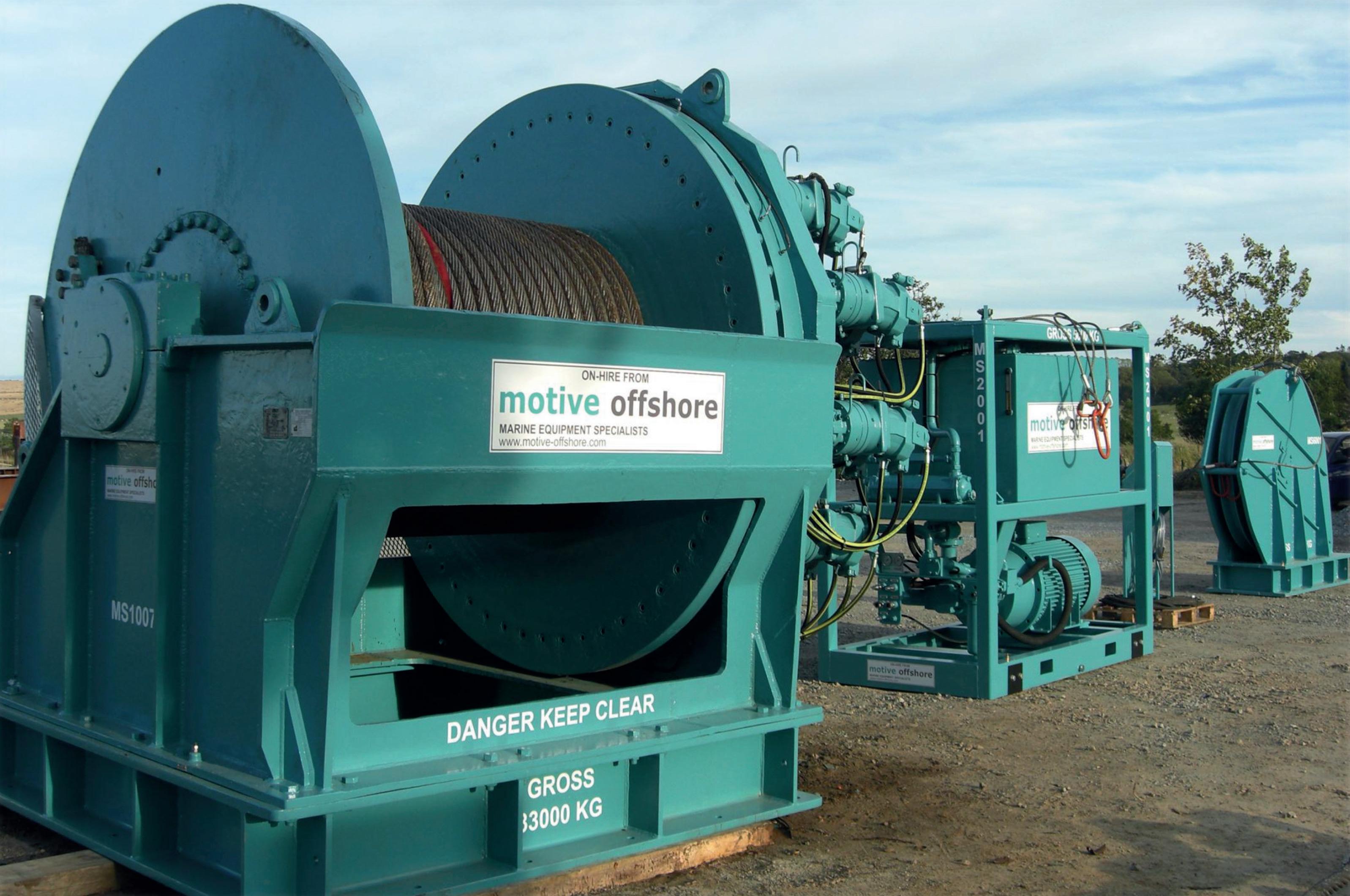
business achieve an annual turnover of £100 million within the next five years, eventually expanding our numbers to 500 people.
“The most important thing is to keep growing a sustainable business,” he concludes. “We’ll continue to pursue that organically, expanding our rental fleet and improving the level of our technicians. Geographically, we also have further plans. In general, our strategy is, and will remain, to follow our clients – that’s what took us to Taiwan, it’s why we went to Houston, Norway, and the UAE. We’re now working with a new private equity company, with a fresh acquisition strategy, which will help us to further drive towards achieving those goals. We have a list of approximately ten companies with whom we’re in dialogue, four of which are in the very early stages. By the end of this year, we hope to get at least one more acquisition over the line.” ■
www.motive-offshore.com
energy-oil-gas.com 99 Motive Offshore
Family at its core
Graco Oilfield Services drills down to the secrets of its success

Established in 1978 in Vernal, Utah, Graco Oilfield Services (Graco)was founded on the principal that “the working man can do better.” Built on a core supply specialism of fishing tools used in the retrieval of well equipment, Graco has been owned and operated by the Rambo family for over 40 years. As Graco’s President, JonRambo, explains:
“In the late 90s, Graco began its expansion throughout the Rocky Mountains by way of multiple strategic acquisitions. As our inventory, alongside our strength of reputation and experience, grew, it was time to expand south. By the mid 2000s, Graco had locations from Montana to Texas and as far east as Oklahoma and Arkansas.”
The organization’s growth has been organic in nature. Beginning in 1997 and continuing through to today, Graco has negotiated, executed and integrated numerous acquisitions that have
100
strategically focused upon the right product and location fit for the business, thereby complementing Graco’s core operations.
In 2020, Graco acquired the assets of Gravity Oilfield Services’ fishing and rental division. “With the purchase of Gravity, Graco expanded its geographic footprint within the Permian Basin from two locations to seven,” Jon states. “The Permian Basin has always been a prolific basin within the US, and we believe it will be even more so going into the future. This geographic reach allows us to service every corner of our customers’ assets quickly and easily.”

Alongside this geographic expansion, the organization’s service offerings also grew, enabling customers to use Graco and its product and service provision throughout the operational
lifecycle of a well. This augmented focus has increasingly enhanced customer relationships. The continual improvement of access to a broader array of services and rental equipment has served to strengthen Graco’s already-strong reputation with its customers and potential sellers. The business steadfastly aims to nurture and embrace such favorable business relationships. Recognized as a leading oilfield services provider, Graco is trusted to deliver superior results and exceptional service throughout the industry, offering oilfield equipment rental and fishing services that are synonymous with safety, service and performance.
Jon goes on to elaborate: “Throughout our history, we have offered pressure pumping, workover rigs, water hauling, casing services,
energy-oil-gas.com 101
Services
Graco Oilfield
“ “
The business was not built to be transient but rather, it was built to stand the test of time and be a generational company
“ “
tubing rental, pressure control equipment, foam unit and drill-out services, downhole motors, and completion tools, but we have never strayed from our core of being a fishing tool company.”
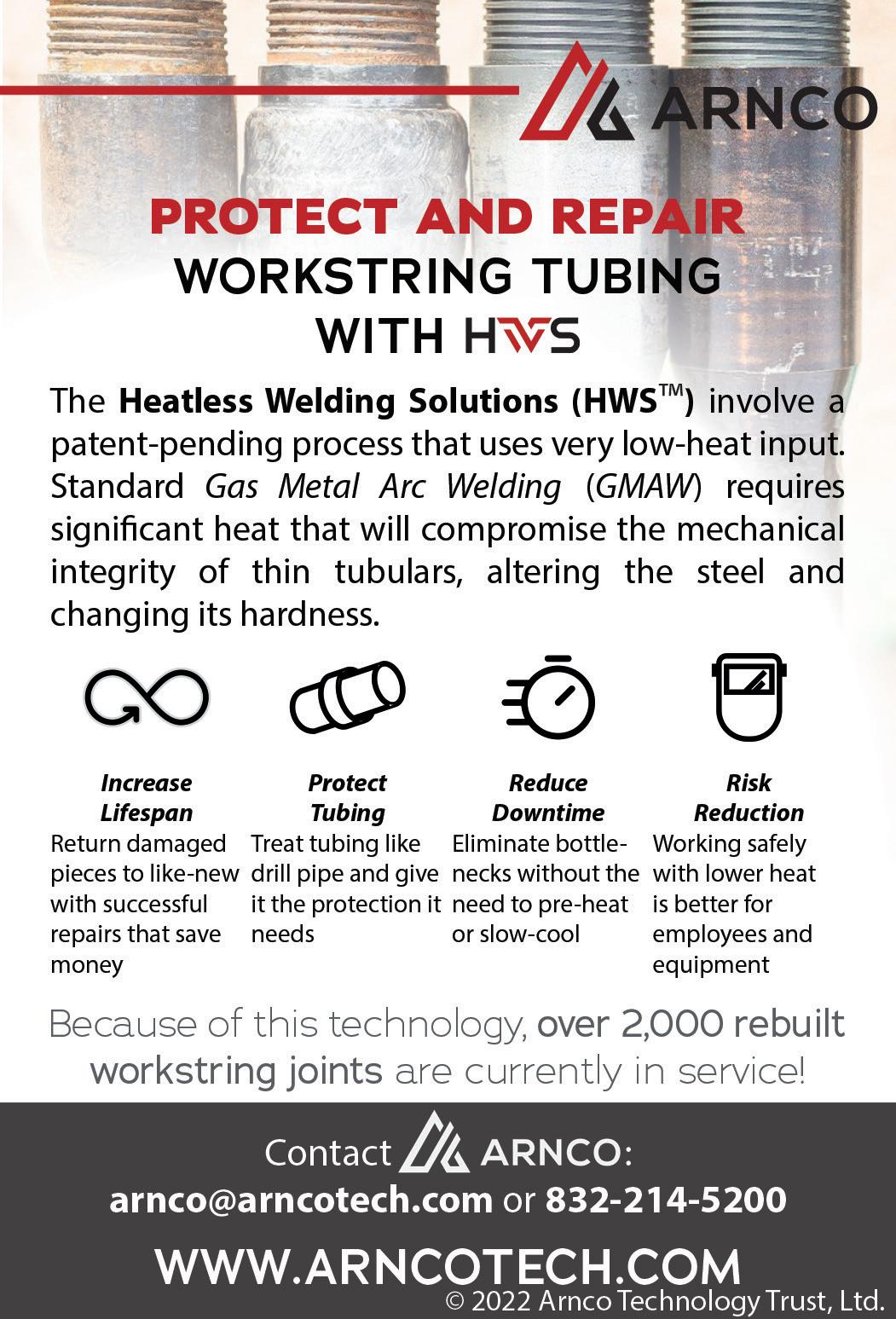
Graco’s team appreciates the costs associated with operational stoppage and potential asset loss and, as such, is established as a premier authority on fishing solutions and services. In support of this, Graco has focused on retaining and developing expertise among its personnel to best meet customer needs.
From proven conventional technologies to the latest advances for extreme environments, the business keeps abreast of industry needs by continuously updating and transforming its equipment inventory. This approach enables Graco customers to better utilize their capital rather than sink cash into equipment that’s not core to their operations. In support of its markets, Graco has developed a substantial network of facilities to ensure fast, cost-effective deployment of resources when and where they are needed.

102
Jon explains how Graco has harnessed its long history of fishing tool experience to broaden its service offering. “We have recently entered into the thru-tubing fishing and downhole motor business, targeting both traditional and coil tubing units.” Thru-tubing applications do not demand production stoppage from theoil well as the work is conducted while the well is producing. Indeed, as Jon continues: “Our primary focus over the next 12-to-18 months will be continuing to strengthen and grow our fishing and thrutubing expertise.
“Additionally, we are in the research and development phase of converting our pumping division from diesel to electrically-driven and believe that there is immeasurable potential to reshape the way this service is deployed and performed.”

Indeed, Graco offers everything an operator might require for their next drillout or workover program, including a large fleet of pressure pumps with capabilities to match the needs of its customers during the various phases of the wellbore life. Pressure pumping services are deployed by experienced supervisors, with units and associated equipment safely and efficiently delivered to the job site, whether for just one job or as a long-term rental.
“We are fully committed to evolving our business to match our customers’ requirements,” says Jon. “Currently, we are working with several customers to provide pumping services that will be powered by electricity at the wellsite.”
Like businesses the world over, Graco’s operations did feel the impact of Covid-19. Jon explains that “having been through every industry downturn since the business began in 1978, this one was most definitely a tough one.” However, as he goes on to suggest: “As an organization, we are so blessed to have a team of individuals who have spent their lives in this industry. As such, we all know what it takes to weather the storms.”
This expertise is held in high regard by the business. Graco employees are considered to be a valuable asset and their input is instrumental in the continued growth and success of the organization. As Jon insists: “As with any service company, our people are our strength. We pride ourselves on being able to bring value to each of our customers. We believe in having a culture that gives our people the flexibility and freedom to succeed as opposed to one that is heavily policy-driven. What we do today will forever speak volumes about how much we care for our people and their futures.”
Looking to the future, Jon has Graco’s sights firmly set on longevity. As he enthuses: “The business was not built to be transient but rather, it was built to stand the test of time and be a generational company. We enjoy having a place where not only our family can be involved, but our employees’ families too. We are fortunate to be a part of this great industry for over 40 years and hope to have another 40 plus.” ■
www.gracooilfieldservices.com
energy-oil-gas.com 103
Graco Oilfield Services
Only smooth SAILING
How Briggs Marine & Environmental Services is pioneering renewable energy
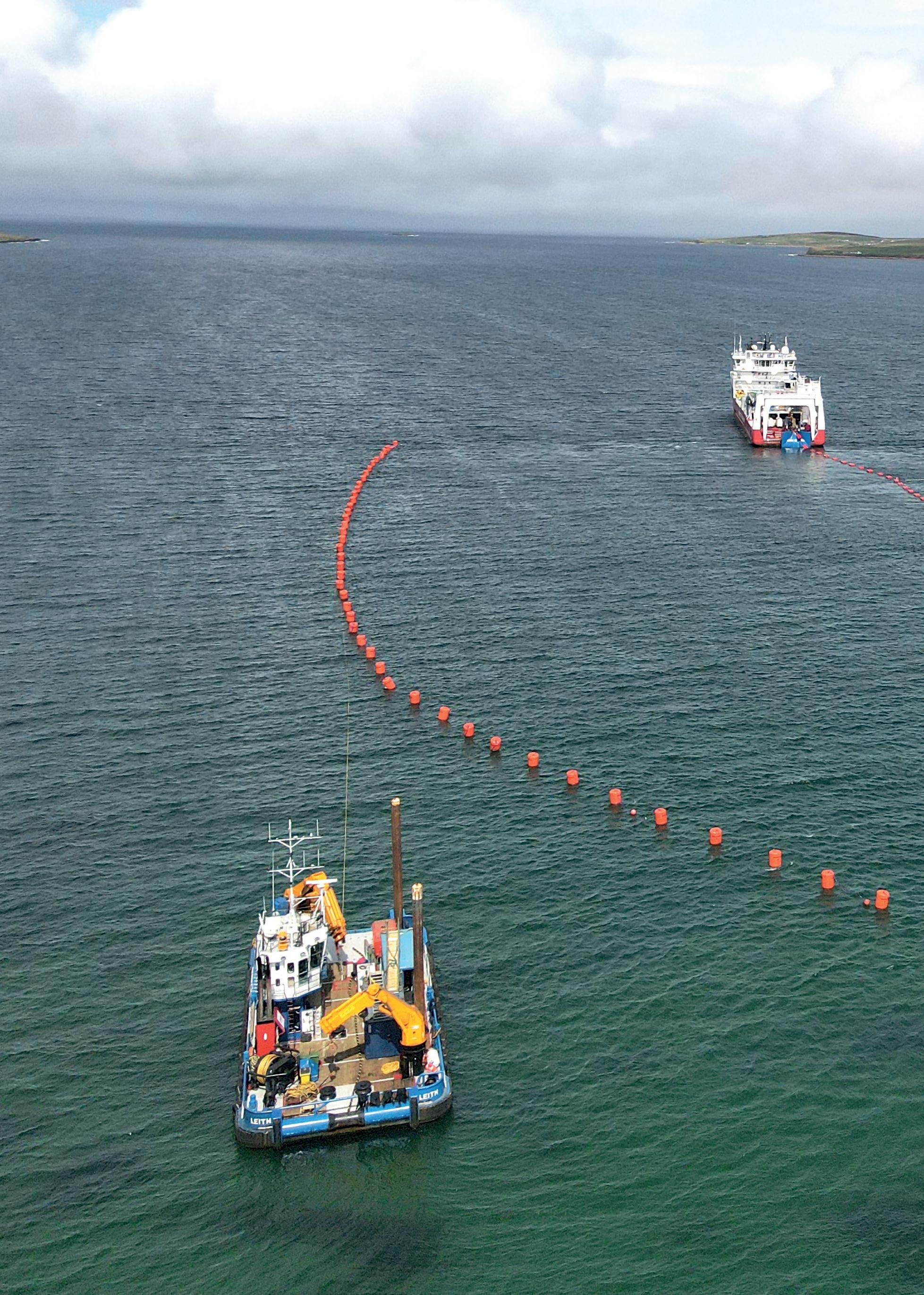
104
Headquartered in Burntisland, Fife, Briggs Marine & Environmental Services (Briggs Marine) is a familyowned business celebrating 50 years of working in the marine industry. An expert in coastal, nearshore, offshore, and subsea operations, the company has a wide range of experience and equipment at its disposal to undertake a range of marine projects, and the flexibility to create bespoke plans for clients’ requirements.
The Briggs family initially became involved in the marine industry in the 1970s, providing workboats to assist marine-based
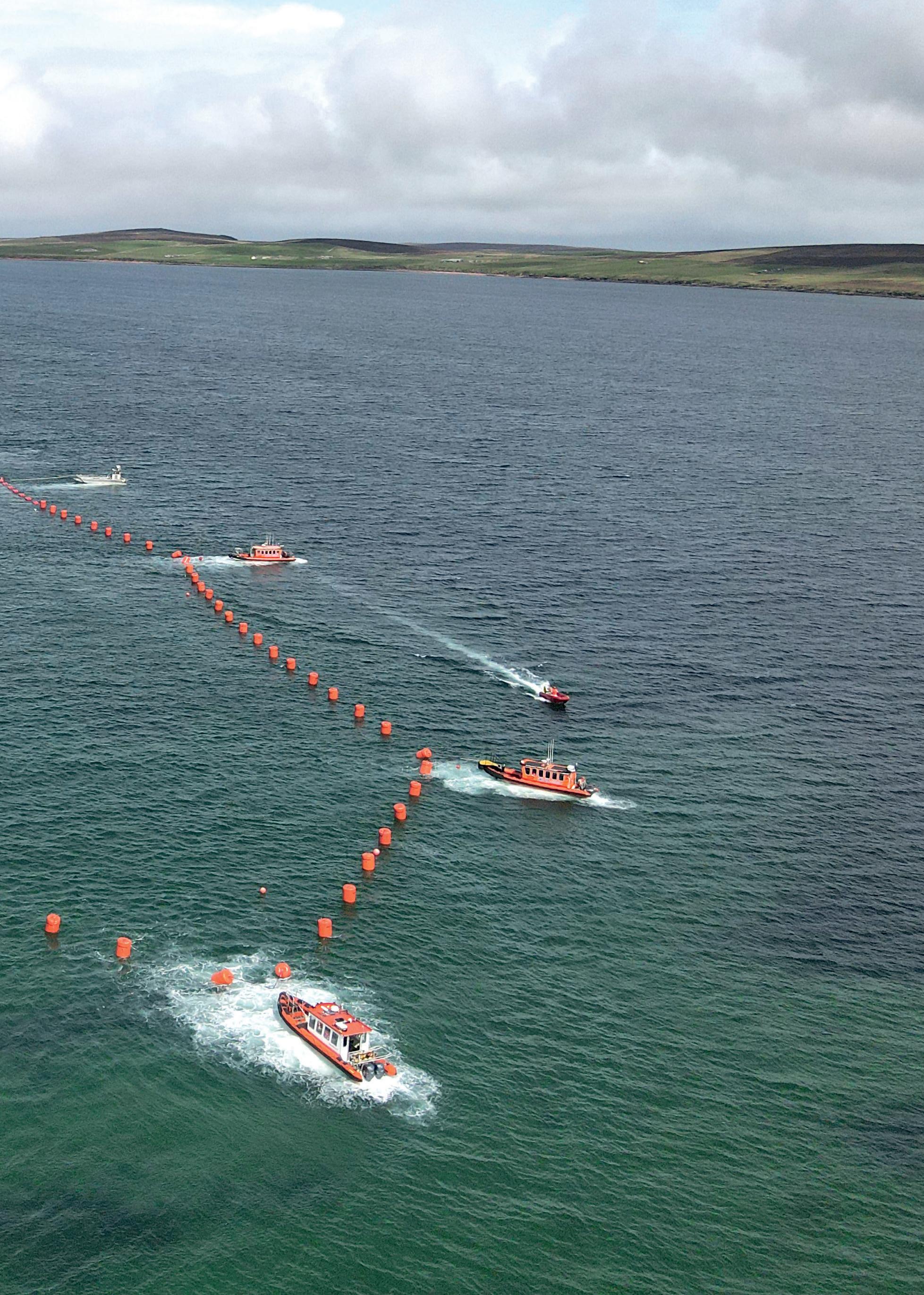
energy-oil-gas.com 105
Briggs Marine & Environmental Services
construction works, both on the east and west coasts of Scotland. Ten years later, they saw an opportunity in the environmental services market, and by 1987, the family had purchased an oil spill response vessel, and established Briggs Environmental Services. The company was then part of the response team for the Piper Alpha disaster in 1988, and the Exxon Valdez oil spill in Alaska in 1989.
It was also in the late 1980s that Briggs Marine started providing vessels and manpower for oil and gas terminal operations across the UK. This service provision continues today, having been subject to significant process improvements to ensure

safety and reduce potential impact on the environment. The company is now actively supporting energy transition on behalf of its clients.
Expanded service offer
Briggs Marine also became involved in various salvage operations, including the Sea Osprey Wave Generator at Dounreay, and the recovery of a 360-aircraft from the Firth of Forth. “The company continues to offer salvage and emergency response services and has been involved in many high-profile operations where it has mitigated damage to the environment,” shares Group General Manager, Rob Baker.
“ “
“ “
The Group has now expanded its services into the renewable energy market, with framework agreements in place with a number of large offshore wind developers
106
Rob continues to share that during the 2000s, Briggs expanded its services further into submarine cable repair and installation, single point mooring repair and maintenance, heavy moorings, and aids-to-navigation refurbishment. It is also responsible for the maintenance and repair of all MoD heavy moorings, and navigation aids around the UK, Gibraltar, and Cyprus. “We started operating in various countries delivering a full suite of environmental solutions including consultancy, training, and spill response services,” he says. “The Group has now expanded its services into the renewable energy market, with framework agreements in place with a number of large offshore wind developers.”
With 50 years of experience, it is no wonder that Briggs Marine has become a leading provider of marine and environmental services, specializing in port and marine operations, subsea and environmental support, and vessel charter. The company also owns and operates coastal survey vessels, offering safe platforms for carrying out a wide range of duties including bathymetric, environmental, oceanographic surveys and more.

In order to understand its customer requirements, not only does Briggs Marine operate spot charters, but it also provides a full vessel management service. “This enables customers, such as Peel Ports in Liverpool, to focus on operations, leaving the management of their pilot launches and other marine services to us,” Rob shares. “This service extends into RoRo

Briggs Marine & Environmental Services energy-oil-gas.com 107
Ferry and Terminal Operations, whereby a full suite of services is offered, including check-in, mooring, linkspan and stevedoring services.”
Coupled with the exciting developments that have grown the business over the last five decades, Briggs Marine continues to expand its service offering into subsea operations, where customers can now benefit from a complete solution, alongside survey and inspection, which often precedes installation and maintenance of subsea cables. “Our strength not only lies in experience in delivering safe, high quality and cost-effective marine-based services, but in our solutions focused approach,” Rob says. From his explanation, by operating in diverse and challenging environments to deliver projects on time and within budget, Briggs Marine can
provide clients with comprehensive solutions that minimize risk exposure, and gain competitive edge to achieve their strategic goals.
This bespoke approach is what enabled the business to win the 18-month project to deliver services to the Neart na Goaithe (NnG) offshore windfarm, where Briggs Marine was originally contracted to provide CTV services for NnG. However, the service offering developed to include the provision of technical staff to carry out routine maintenance tasks and other operational services. “More recently, this project was extended to the provision of a walk-to-work vessel, and a dehumidifier installation for wind turbine transition pieces,” Rob elaborates. “Other offshore windfarm work that we have completed includes the delivery of demarcation buoys for the construction projects at Seagreen, NnG, and others.”
These contracts enable Briggs Marine to demonstrate its capabilities within the renewables industry, but more importantly, they also enable the company to further invest

“ “
“ “ 108
We also plugged a gap in our offering by acquiring the majority stake in ARB Wind
in essential services for the offshore wind sector overall. Investments in cable handling equipment have been a particular focus this year, as the company’s cables department gears up to meet the demands of the offshore wind industry.
Company values
Briggs Marine continues to invest in its fleet, having recently commissioned a new pilot launch to be made available for chartering, once delivered in 2023. This provision will help clients in urgent need of a pilot launch, as the 12-metre-long vessel is road transportable and can be quickly mobilized across the UK. “As part of a continued investment program to upgrade our fleet utilized within the Port of Sheerness, Briggs Marine purchased four new vessels for its Medway contract in 2021,” Rob adds. “This followed significant investment into new pilot launches for a contract based in Liverpool, and the acquisition of a CTV in 2021.”
In terms of the company’s sustainability initiatives, the developments in that regard are just as exciting. The Briggs Marine offering to the renewables industry is based on the same core services it has provided over the last 50 years. “By repackaging these services, which have been enhanced by the purchase of the CTV, the company has been able to meet the needs of the offshore wind energy sector,” Rob insists. “We also plugged a gap in our offering by acquiring the majority stake in ARB Wind. ARB’s provision of statutory wind turbine inspections and maintenance and technical personnel gives the Briggs Marine Group a unique integrated package of wind farm services.”
Rob then takes a moment to recognize that these achievements would not be possible without the team at Briggs Marine. For him, a business is only as good as the people, and as a family-owned business, Briggs Marine still maintains its original values of loyalty and recognizing success. To
support employees, its training division offers opportunities to develop the skills within the workforce, as well as to keep staff engaged and provide progression opportunities.
Going forward, Briggs Marine will remain focused on its core market, and ensure it continues to add value to existing projects for its clients. As the business invests in assets and people, it will also seek to develop further relationships, particularly within the UK offshore wind sector, to ensure the company is part of the move towards green energy. Rob concludes: “By utilizing the experience we have gained in our first 50 years of trading, we intend to continue to build on our current success to meet the future demands of the marine and renewables industries.” ■
www.briggsmarine.com

Briggs Marine & Environmental Services energy-oil-gas.com 109
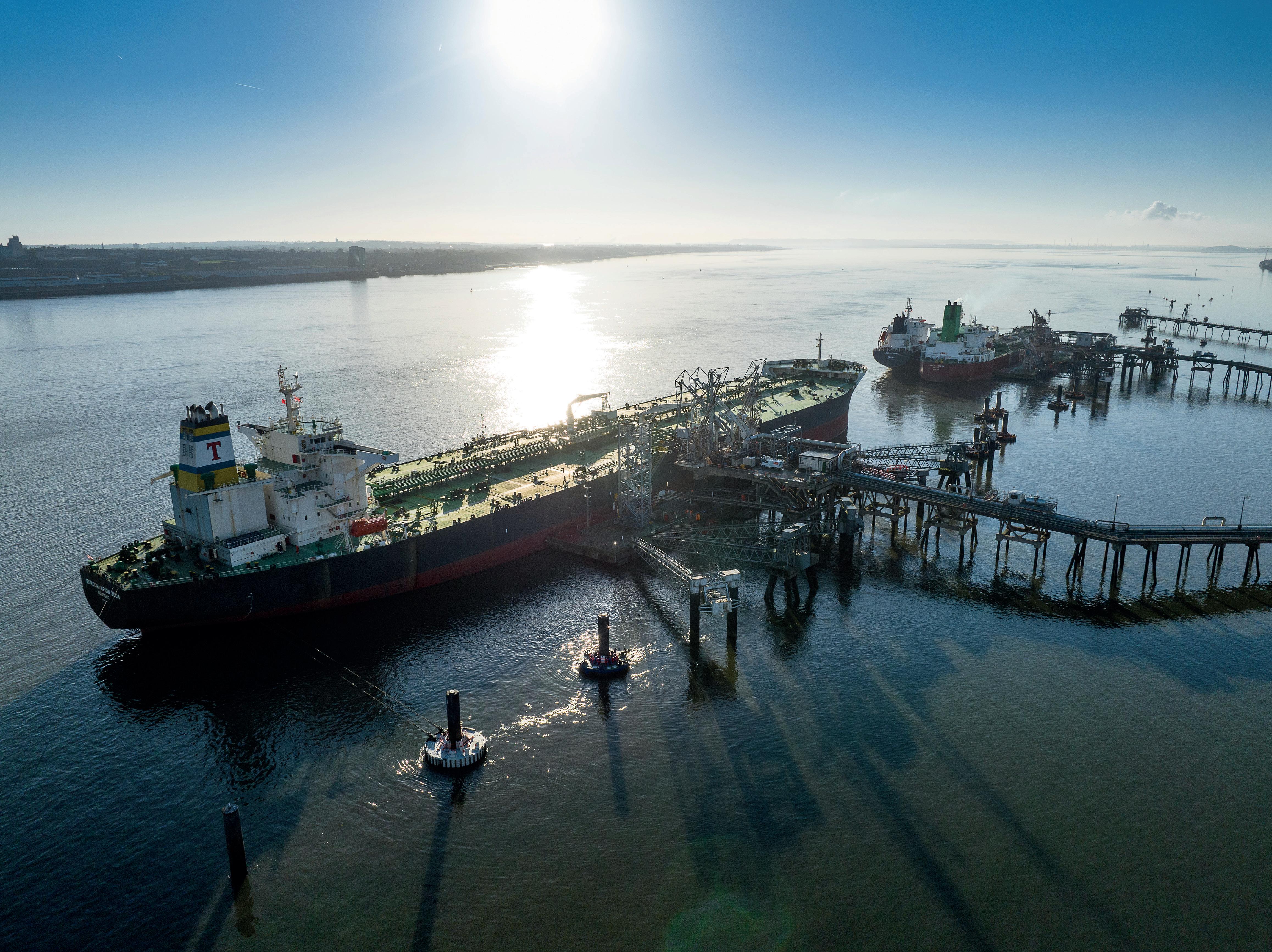
110
at home Energy
Stanlow Terminals is bringing an exciting new energy hub to the UK
In December of 2021, Stanlow Terminals made a major announcement, as the company shared its plans to develop the UK’s largest biofuels facility.
Part of Stanlow Terminals’ drive to support the country’s net-zero ambitions, the project will combine the repurposing of existing storage infrastructure alongside new infrastructure investments.

Stanlow Terminals energy-oil-gas.com 111
These investments will allow customers to store, blend, and distribute low-carbon biofuels suitable for use in the energy transition as drop-in replacement transport fuels for road, aviation, and marine. In total, the investment will add 300,000 cubic meters of capacity to the company’s two sites in Tranmere and Stanlow, enhancing what are already critical national infrastructure locations responsible for 16 percent of the UK’s total fuel supply.
“In the context of UK energy security issues, and the ongoing energy transition, this infrastructure is set to be absolutely critical to the development of the North West’s and the UK’s energy markets,” comments Mike Gaynon, CEO of Stanlow Terminals, speaking to Energy, Oil & Gas
The development of Stanlow Terminals’ biofuels storage facility is just one element of the broader work being undertaken by the company to adapt and transition its operations. Following a restructuring of its business units in early 2022, Stanlow Terminals is focusing its activities on so-called ‘new energies’.
“New energies include all our future lowcarbon energy storage and infrastructure projects: low-carbon hydrogen, sustainable aviation fuel, green ammonia, carbon dioxide and liquid organic hydrogen carriers,” Mike explains. “We’re starting to develop the elements of the hydrogen economy and other specific energy products that will contribute to the UK’s decarbonization.”

112
As the company embarks upon this journey, it’s supported by the existing capabilities of its deep-water facility at Tranmere. As Mike adds: “our Tranmere site is equipped to accommodate large ships, which will prove vital as we’ve developing globally-leading import and export markets, essential to the energy transition.”

The development of Stanlow Terminals’ capabilities is also expected to improve integration with its parent company, Essar. Based in India, Essar is currently exploring green fuel projects with a view to supplying the UK and European markets. According to Mike, this is also exemplified at Essar Oil UK, where the company is setting “a global benchmark” for the low-carbon refineries of the future. Essar is also investing in the development of hydrogen production facilities at Stanlow.
“Vertex Hydrogen, Essar’s hydrogen production company, will build the UK’s largest low-carbon hydrogen plant here within the next few years, with production to start in 2026,” he reveals. “Vertex Hydrogen is part of HyNet, the UK’s leading decarbonization cluster, and Stanlow Terminals is also developing plans to utilize HyNet’s carbon capture capability and sequestration pipeline. Together, these projects will provide a blueprint for a lowcarbon industrial cluster.
“In terms of scale, the first phase of HyNet will see the sequestering of around ten million tons of carbon dioxide per year, by around 2030,” Mike adds. “We’ll then be targeting the construction of a multi-modal hydrogen transport hub, providing an effective mechanism for the storage and distribution of hydrogen by road, rail, and marine.”

“ “
Before the end of this year, we hope to sign some of our first third-party storage contracts
“ “ Stanlow Terminals energy-oil-gas.com 113
Through this innovative approach, Stanlow Terminals is hoping to build upon what has been a successful couple of years. “Throughput volumes and sales have increased post-pandemic, in tandem with the refinery growth,” Mike notes. “Our new energies business is predominately long-lead, supported by significant capital investment programs over the next threeto-five years.
“We’ve also been working with the UK Government’s Catapult Network, together with Mersey Maritime, to establish
a green shipping corridor along both the river Mersey and Manchester Ship Canal,” he adds. “Historically, both Stanlow and Tranmere terminals have provided bunkering facilities for ships, and as new energies such as methanol, hydrogen, and ammonia are increasingly required for ship propulsion, bunkering is set to become a core part of our business once again.”
One significant recent development for Stanlow Terminals occurred in March 2021, with the announcement that the Liverpool City Region was set to become a Freeport.
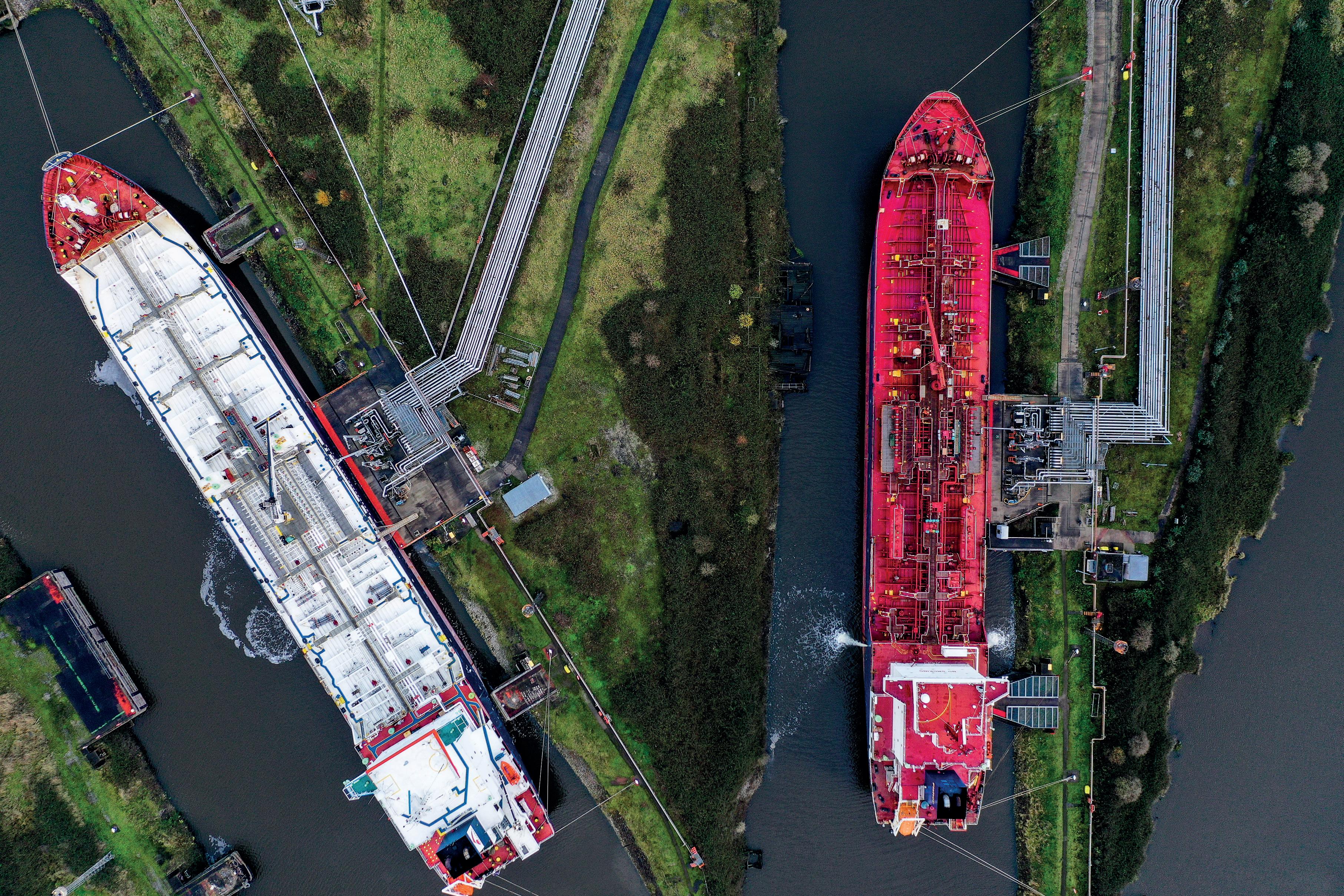
114


“
Stanlow Terminals energy-oil-gas.com 115
“We’ve also been working with the UK Government’s Catapult Network, together with Mersey Maritime, to establish a green shipping corridor along both the river Mersey and Manchester Ship Canal“ “
Both the company’s Tranmere and Stanlow facilities sit within the radius of the Freeport Zone, and the company is now working with the Liverpool City Region to explore what these designations could mean for the sites, including permitting Stanlow Terminals’ customers to import and export without customs duties. The company has also recently acquired International Sustainability and Carbon Certification (ISCC) – a tracking process for biofuels and other low-carbon replacement fuels, further enhancing its offering for customers.
“We’re certified as an ISCC warehouse keeper, meaning that our customers who have ISCC-certified products can bring those products into our facilities for storage while maintaining their certification,” Mike notes. “They’re able to do so thanks to our completely segregated storage, with all the necessary systems and procedures in place. Once again, it’s all part of making our hub more attractive to customers and businesses within the energy transition space.”
As we move into the fall, many within the energy sector are still adjusting to what has been a year of volatility, driven largely by the Russian invasion of Ukraine. This has thrust issues of energy security and resilience into the limelight. For Mike, it’s underlined the importance of investment in the energy transition and domestic energy infrastructure, and he expects plenty more to come.
“Before the end of this year, we hope to sign some of our first third-party storage contracts,” he confirms. “We also have a couple of MOUs (Memorandums of Understanding) in the pipeline, which we’ll be able to reveal more about in the coming months. Beyond that, we’re looking ahead to the next five years, for which the focus is, of course, on building out our storage platform and energy infrastructure business as we transition for tomorrow.” ■
www.stanlowterminals.co.uk

Stanlow Terminals 116
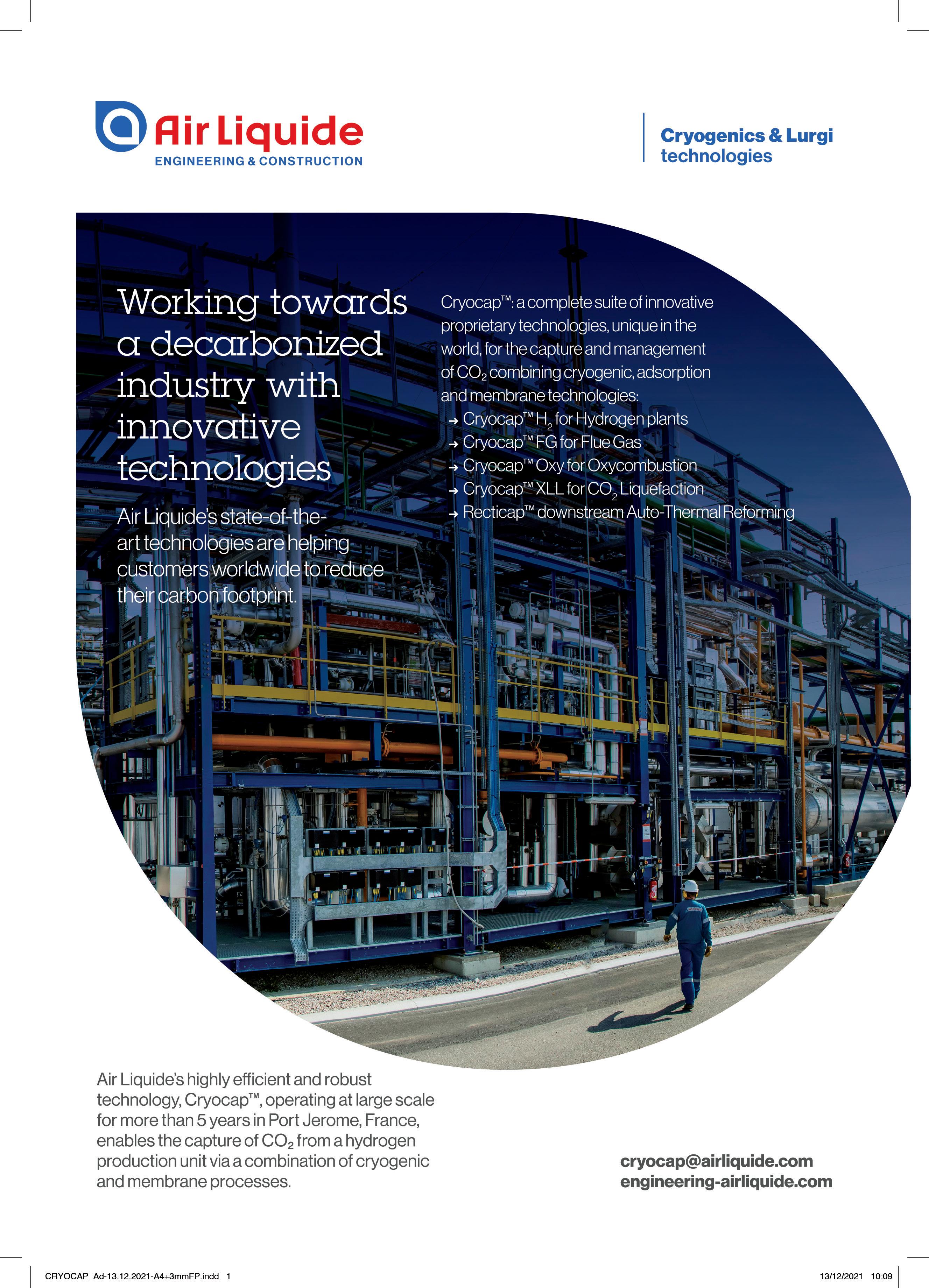
































 By Marek Lukaszczyk
By Marek Lukaszczyk
 By Kris Fumberger
By Kris Fumberger





 By Wouter Maas
By Wouter Maas



























 Above: Claresholm Solar Project, Alberta
Above: Claresholm Solar Project, Alberta

 The Skyway 8 Wind Farm is a 9.48 megawatt (MW) wind energy project near Southgate, Ontario
The Skyway 8 Wind Farm is a 9.48 megawatt (MW) wind energy project near Southgate, Ontario













































































